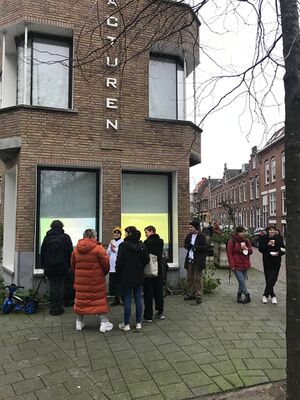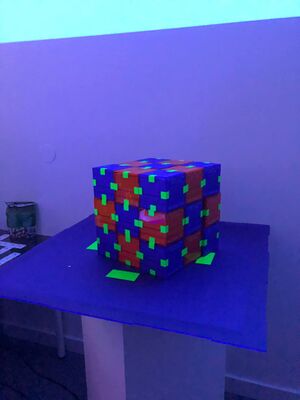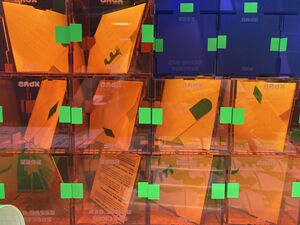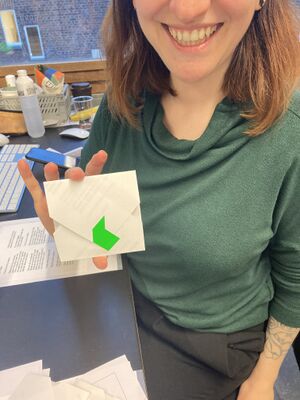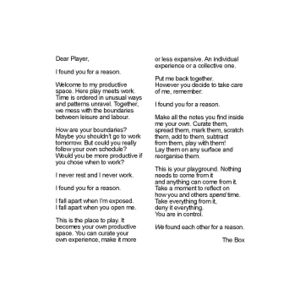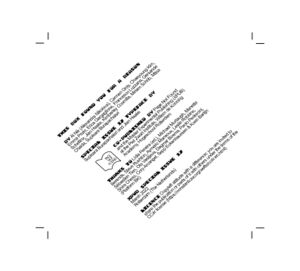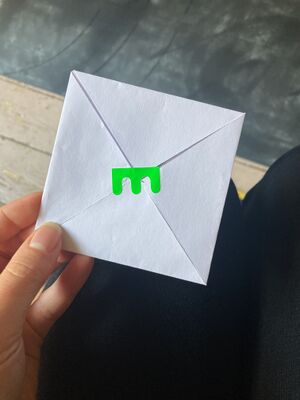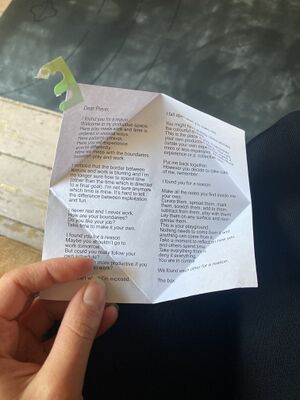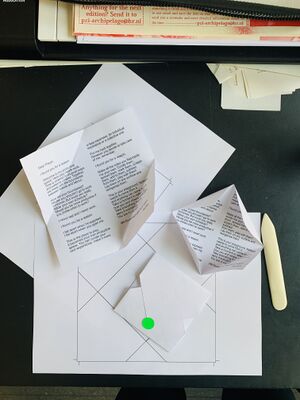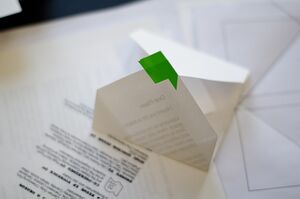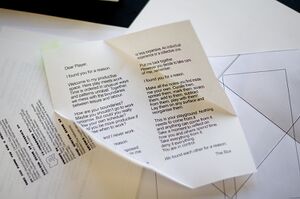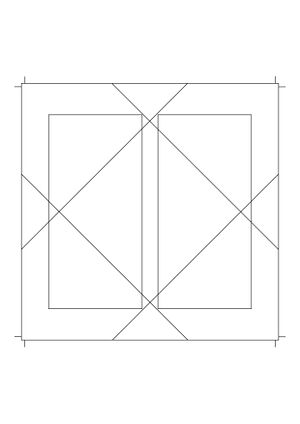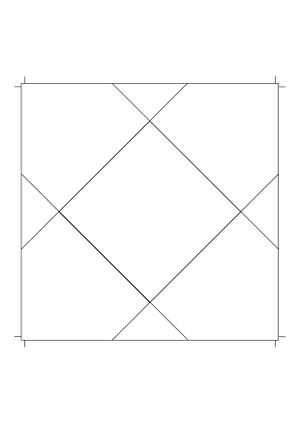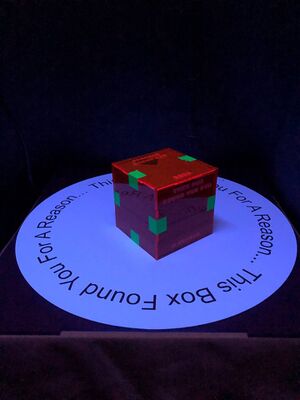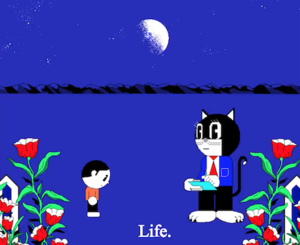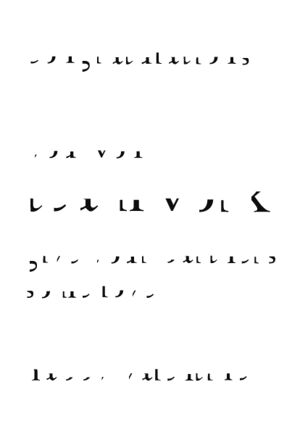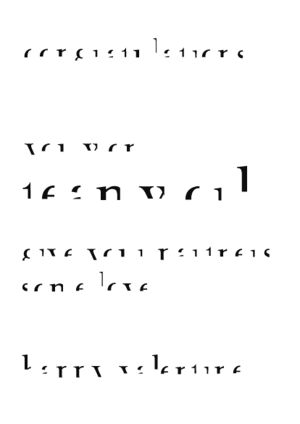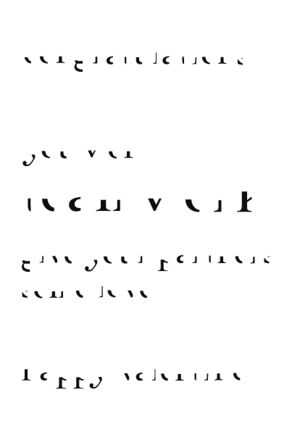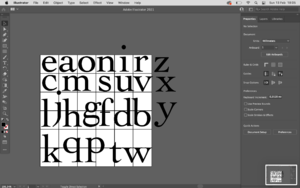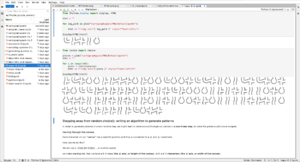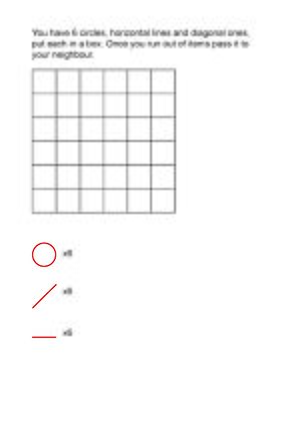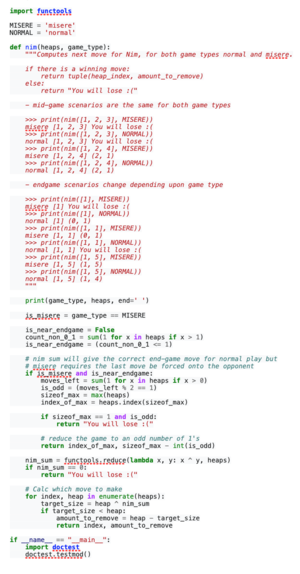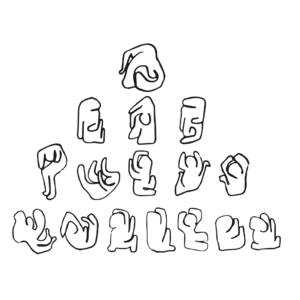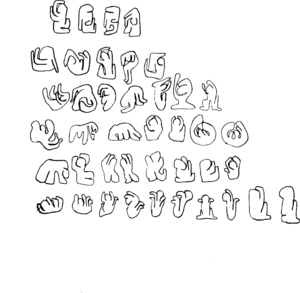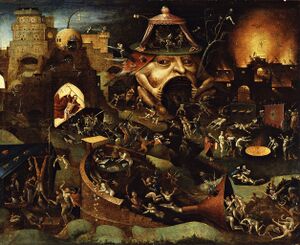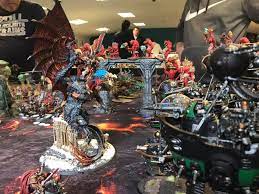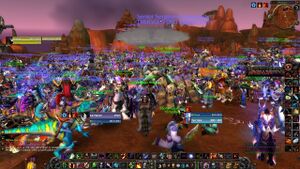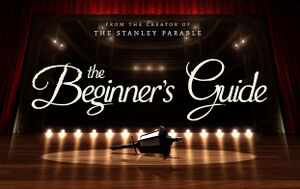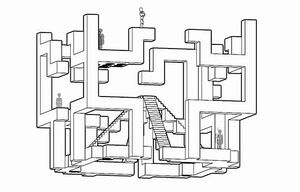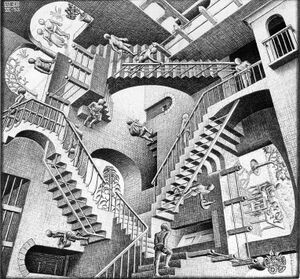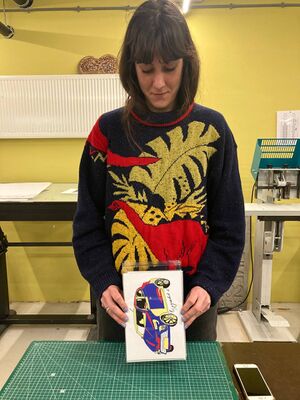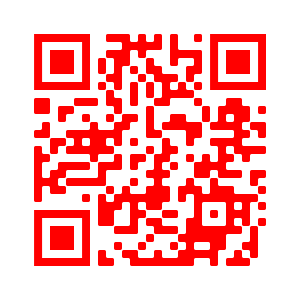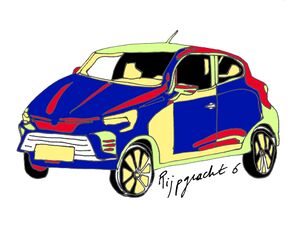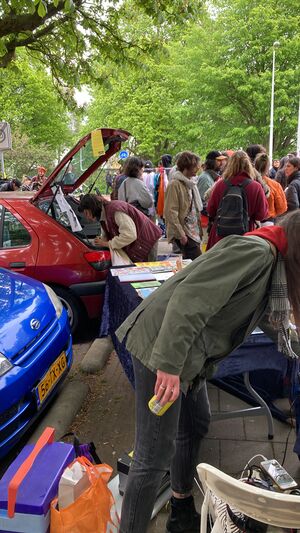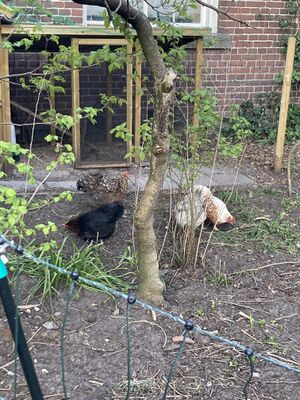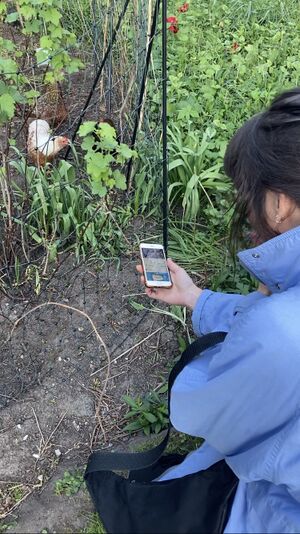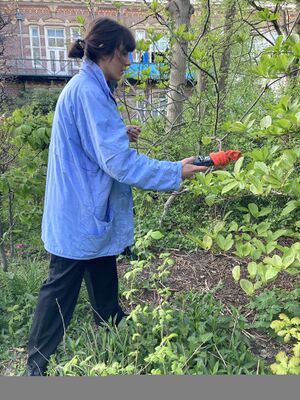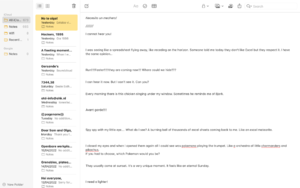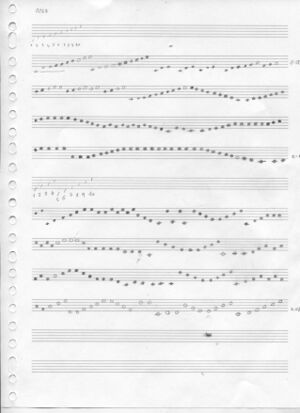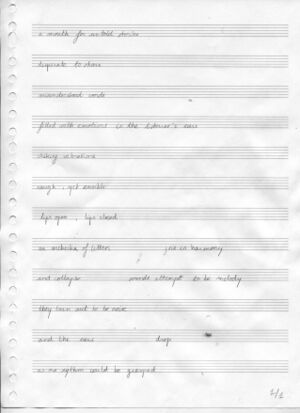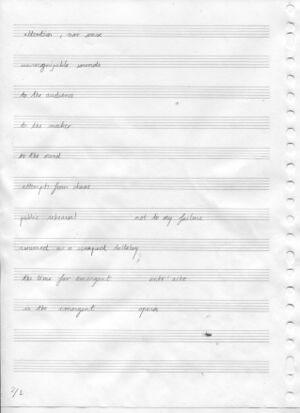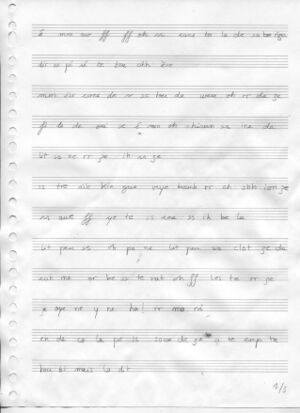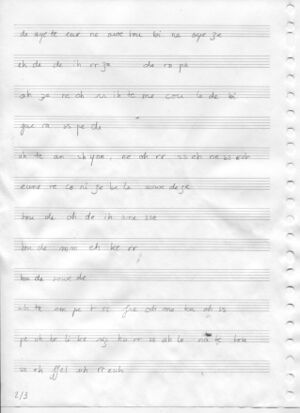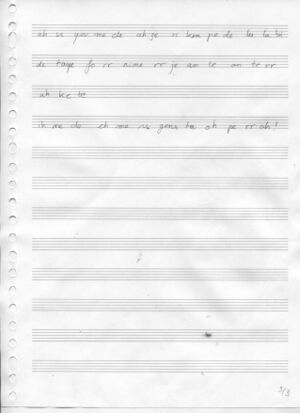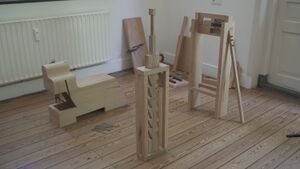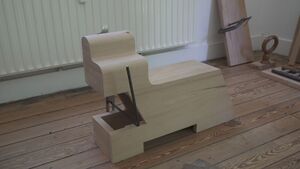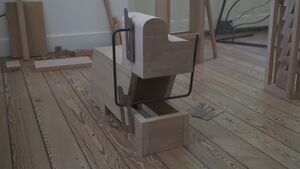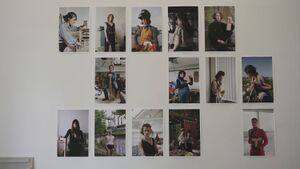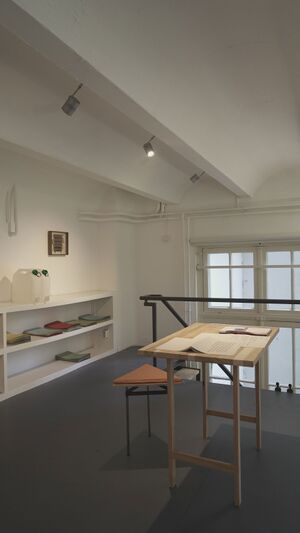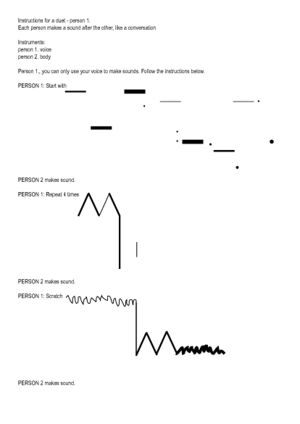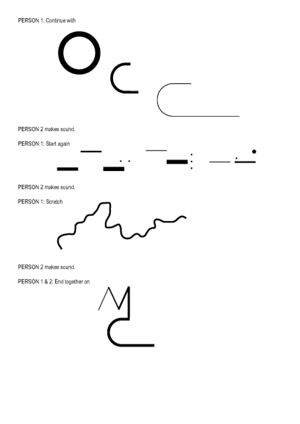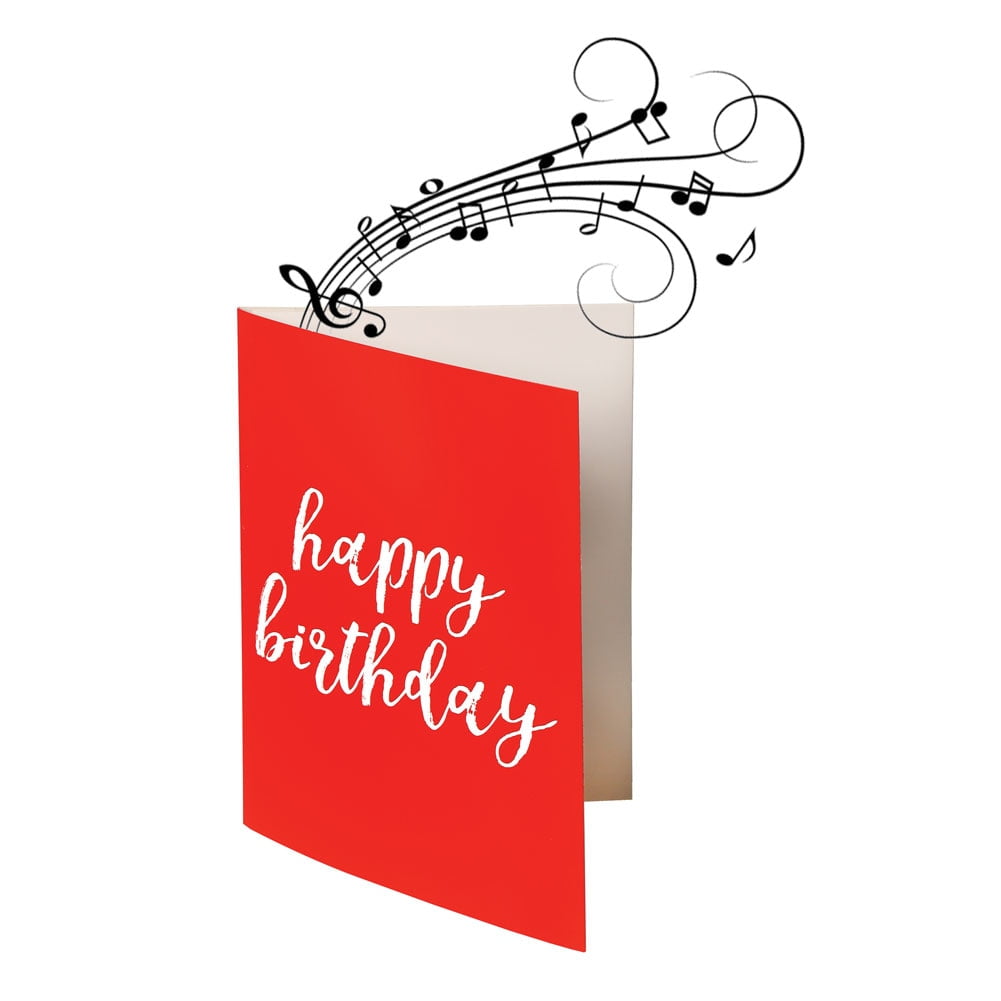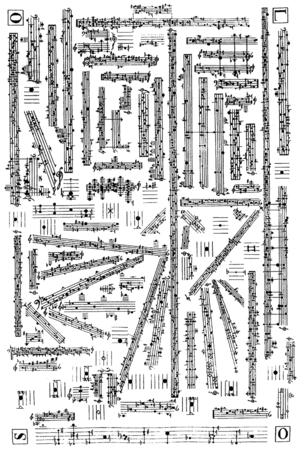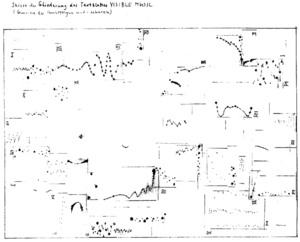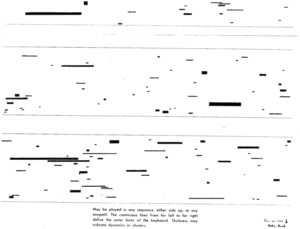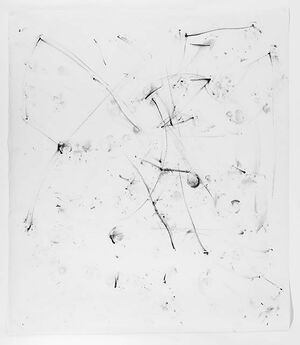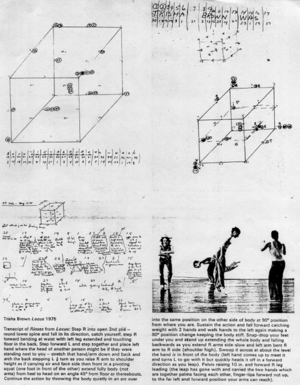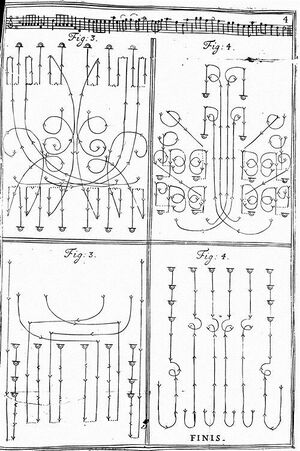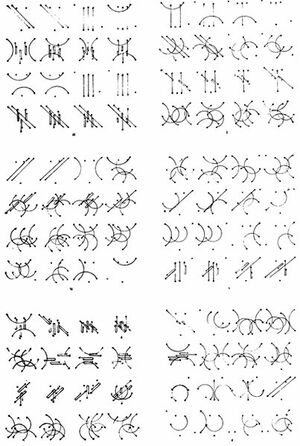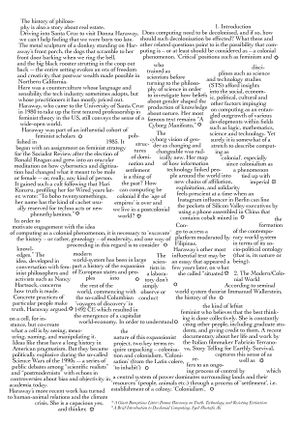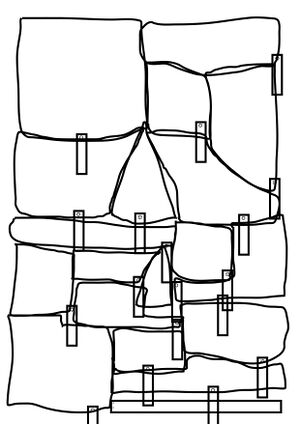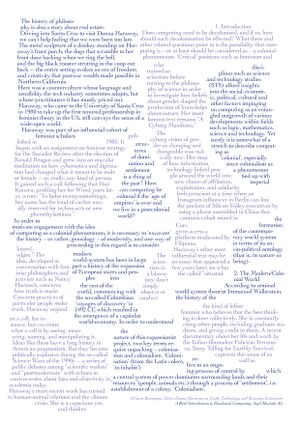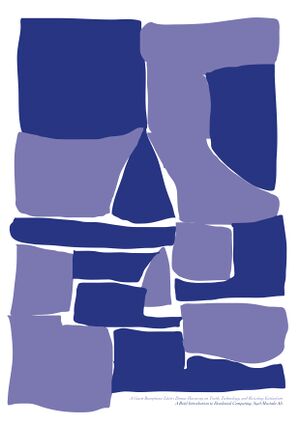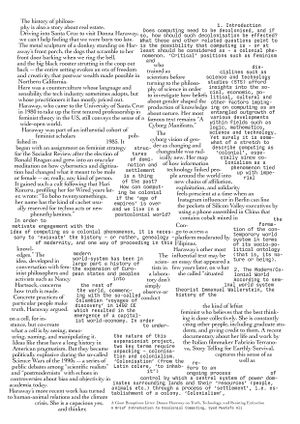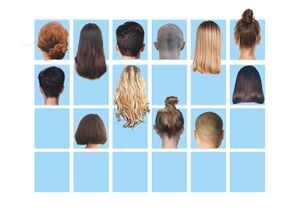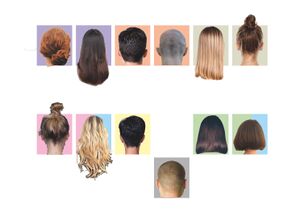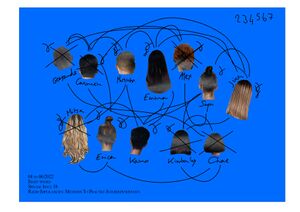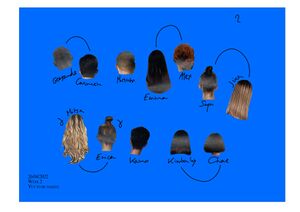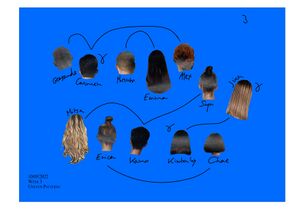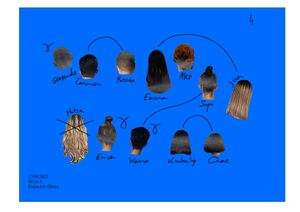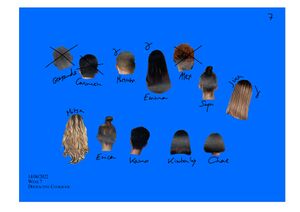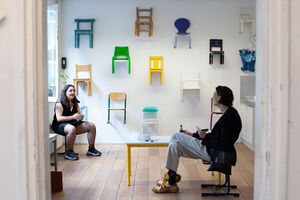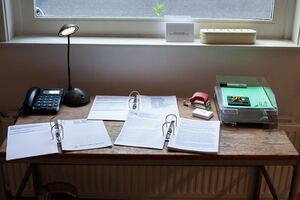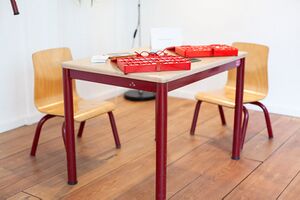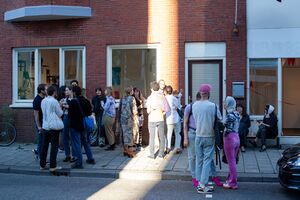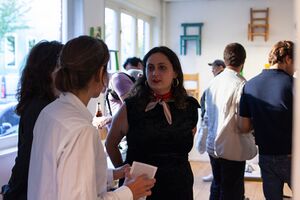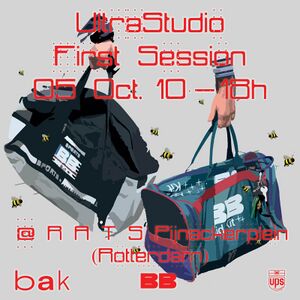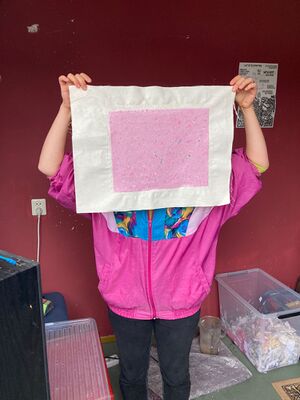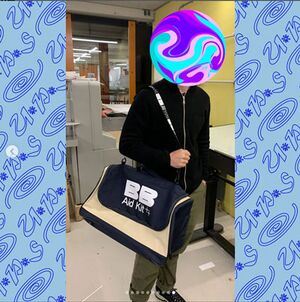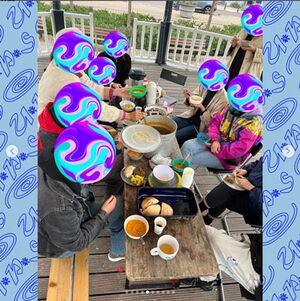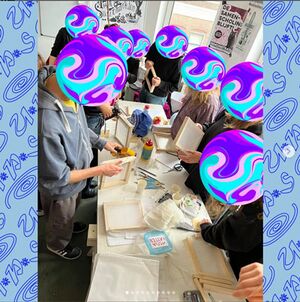User:Gersande: Difference between revisions
| (399 intermediate revisions by the same user not shown) | |||
| Line 1: | Line 1: | ||
''Last update 20.6.2022'' | |||
[https://gersandeschellinx.com gersandeschellinx.com] | |||
<big>XPUB1 2021-2022</big> | |||
=Special Issue 16= | =Special Issue 16= | ||
==Individual experience summary== | |||
Within the Special Issue 16 project, my head took many spins. One of my main focus revolved around the ETC project I developed with Chae. Our research took many directions and we were both very eager to archive every step of the way. Within the project I worked along the conceptualisation of our ETC portal with Chae and wrote all the textual content we needed to choreograph the co-writer’s experience. Next to this, I thoroughly edited and kept updated our research on the Wikipedia. The prototyping for the project started in prototyping class, took a physical turn with and idea for a parcel-publication and went back to python to evolve and remain online. I also tried to design our tool as to be coherent with the overall project and enable a fluid navigation for the visitors. <br> | |||
Next to this subgroup project I was overviewing the organisation of the overall Issue with Emma, took part in different groups meetings (front-end, back-end, launch, visual identity etc) as to keep an overall coherency in the whole project. Which, proved to be, very challenging. At the launch of the event in Varia I became the cocktail generator's hands. | |||
==Online publication== | ==Online publication== | ||
==Etc Research | https://hub.xpub.nl/soupboat/si16/projects/etc-portal/ | ||
[[File:Screenshot 2022-03-24 at 15.49.48.png|frameless]] | |||
==About== | |||
'''<big>''Learning How to Walk While Catwalking, XPUB, 2021''</big>''' | |||
XPUB (the Experimental Publishing master from Piet Zwart Institute, Willem de Kooning Academy) welcomes you to the Special Issue 16 on vernacular language processing: Learning How to Walk while Catwalking.<br> | |||
Our Special Issue is a toolkit to mess around with language: from its standard taxonomies and tags, to its modes of organizing information and its shaping knowledge. With these tools we want to legitimize failures and amatorial practices by proposing a more vernacular understanding of language.<br> | |||
We decided to release the Special Issue 16 toolkit in the form of an API (Application Programming Interface). APIs organise and serve data on the Internet; what is not always evident is that they facilitate exchange of information following mainly commercial purposes. However, Our API is an attempt at a more critical and vernacular approach to such model of distribution. You didn't get a thing yet? Don't worry! We are also on our way and that's the whole point of this experimental enquiry. We will be happy to guide you through the API and the different functions included in it, share our technical struggles and findings.<br> | |||
The overall project as mentioned above is a toolkit, thus hosts multiple tools. The SI16 website is a vessel for you to navigate from one to another of those projects smoothly. Where you will enter a sea of possibilities.<br> | |||
This project is characterized by the elaboration of functions, at the heart of our tools, that consider and process vernacular languages. The material we process comes from various sources. For some of it, we appropriated existing texts and compiled them into corpora. Alternatively, the activation of certain functions calls for an audience’s input. The participatory aspect of the functions is an important factor that unites them.<br> | |||
We approach the text as a texture, a malleable clay tablet, a space for foreign input and extensive modifications, for cut-up and for collage, for collective agency and participation. Not a surface but a volume, in which the text is not only text, but a shared space. We work to sort out several meanings from the same text. We intend to blur our roles as authors, users and public because this is an act of collective world building.<br> | |||
The Special Issue 16's title "Learning How To Walk While Catwalking" is a playful mention to illustrate how we experienced the present project and the mentality in which we want you to engage with it: be confident, be ambitious and be ready to fail a lot.<br> | |||
'''<big>''Colophon''</big>'''<br> | |||
All the code and the contents produced through this API are automatically licensed under the Catleft Licence.<br> | |||
Gersande Schellinx, Mitsa (Dimitra Chaida), Erica Gargaglione, Francesco Luzzana, Chaeyoung Kim, Emma Prato, Miriam Schöb, Supisara Burapachaisri, Jian Haake, Ål Nik (Alexandra Nikolova), Kimberley Cosmilla, Carmen Gray Manetta Michael Cristina Steve Clara Danny Aymeric Simon <br> | |||
Pirelli is a nice typeface from Jung-Lee Type Foundry (J-LTF)<br> | |||
==Etc Research== | |||
===Project Description=== | |||
The Etc Portal to Contamination is a project initiated by Chaeyoung Kim and Gersande Schellinx in the context of the Special Issue 16 (2021) of the XPUB around the topic of Vernacular Language Processing. | |||
It is a subgroup project hosted by the overall project: Learning How To Walk While Catwalking. | |||
The three-steps experience offered to the user unfolds as follows: the users enter the "etc-portal", on the other side of that portal is presented to them a text in which "gates"(submit boxes, see image below), each target-word will open a gate to a negative space in the text, created after our text has been processed. Where the space opens up, the users are invited to "contaminate" the text with their own contaminants (ideas, thoughts, anecdotes quotes or other textual matters). | |||
When done with their "contamination", the users are then invited to submit it and shift/rewrite the context of the text. | |||
Finally, the text is immediately returned to them with their latest additions. | |||
''Collaboration and project archive with Chaeyoung Kim: | |||
'' | |||
https://pzwiki.wdka.nl/mediadesign/Etc_Filter_/_Negative_Space_/_Starting_Point | |||
==XPUB meets BB== | |||
Bookbinding workshop at the Gerrit Rietveld Academie. | |||
<gallery> | |||
Xpubxbb.jpg | |||
Xpubxbb 1.jpg | |||
Xpubxbb 2.jpg | |||
Xpubxbb 3.jpg | |||
Xpubxbb 4.jpg | |||
</gallery> | |||
==SI16 Launch== | |||
[[File:Cocktail maker.jpg|frameless]] [[File:Cocktail bar.jpg|frameless]] | |||
[[File:SI16 launch.jpg|frameless]] | |||
=Special Issue 17= | =Special Issue 17= | ||
==Puzzles== | ==Individual experience summary== | ||
For the Special Issue 17, I took early on a facilitator role, trying to propose a structure for the whole group to work together cohesively and horizontally. The trimester started with a shared responsibility in decision making and facilitating meetings. Yet, coming closer to the “decision-making” deadline the size of the group got in the way of our proceeding to any cohesive project, thus the importance of a sharper editorial feature to the group. Following a Work Division proposal and “working ethic” (Letter to Ourselves), I joined Alex to try and keep the whole project together by enabling a smooth yet critical conversation between the different teams (representatives). We then proceeded, with the help of Steve, Lidia and Carmen, to write an Introduction to the overall project, a Letter to the Player. <br> | |||
Alongside the editorial work, I collaborated with Jian and Carmen on the conceptualisation and production of the Box of the SI17. Originating in a desire from Jian and Chae to work with Acrylic (a perfect physical loot box material, desirable yet not easy to confuse with other more relatable cardboard support you might find in traditional physical games) we worked on ways to create a playful container and platform for the content of the SI17, in order to trick&give agency to the player. Meeting the classical features of the loot box (in terms of desire, tricking the player), yet turning upside down an essential feature: the temporality and preciousness of the loot box, which usually disappears the minute it is open. The SI17 loot box, lasts in time and space. Next to the design and production of the box, I worked on different sets of stickers that are abstractions of boxes being opened, unraveled, playing with the pictograms one can find on parcels. A feature for the player to personalise their own box once it’s been activated.<br> | |||
You can find my [[User:Gersande#Nim_fanfic_v.2 | Nim Fanction]] in the publication. | |||
==About== | |||
'''''This Box Found You For A Reason''''' <br> | |||
'''''A Box in a Box in a Box is a Loot Box''''' | |||
[https://issue.xpub.nl/17/ Find the Loot Box online here] | |||
[[File:Big Loot Box.jpg|frameless]] | |||
[[User:Gersande#SI17_Editorial_work | More information]] | |||
==SI17: The Lootbox== | |||
'''''with Jian and Carmen''''' | |||
[[SI17_Box#Description|More information about the SI17 LootBox]] | |||
[[File:Lootboxtitle.jpg|frameless]] | |||
<gallery> | |||
Box assemblage 1.jpg | |||
Box assemblage 2.jpg | |||
Box assemblage 3.jpg | |||
</gallery> | |||
[[File:Box assemblage 4.jpg|frameless]] [[File:G-and-stickers.jpg|frameless]] | |||
=SI17 Editorial work= | |||
'''''with Alex''''' | |||
[https://pzwiki.wdka.nl/mediadesign/Special_Issue_17_Editorial More information about the Editorial work here] | |||
[[File:Alex and the intro.jpg|frameless]] | |||
==SI17 Introduction Letter== | |||
[[File:Intro letter SI17 final Page 1.jpg|frameless]] | |||
[[File:Intro letter SI17 final Page 2.jpg|frameless]] | |||
'''First try-out'''<br> | |||
[[File:Prototype intro letter.jpg|frameless]] | |||
[[File:Prototype intro letter 2.jpg|frameless]] | |||
'''Final Letter'''<br> | |||
[[File:Introduction letter.jpg|frameless]] | |||
[[File:Si17 intro letter.jpg|frameless]] | |||
[[File:Si17-intro-letter.jpg|frameless]] | |||
[[File:Si17-letter.jpg|frameless]] | |||
====Fold guide==== | |||
[[File:Intro letter s17 final a4.jpg|frameless]] | |||
[[File:Intro letter s17 final a42.jpg|frameless]] | |||
===Raw text=== | |||
'''Letter by the Box''' | |||
Dear Player, | |||
I found you for a reason. | |||
Welcome to my productive space. Here play meets work. Time is ordered in unusual ways and patterns unravel. Together, we mess with the boundaries between leisure and labour. | |||
How are your boundaries? Maybe you shouldn't go to work tomorrow. But could you really follow your own schedule? Would you be more productive if you chose when to work? | |||
I never rest and I never work. | |||
I found you for a reason. | |||
I fall apart when I'm exposed. I fall apart when you open me. | |||
This is the place to play. It becomes your own productive space. You can curate your own experience, make it more or less expansive. An individual experience or a collective one. | |||
Put me back together. | |||
However you decide to take care of me, remember: | |||
I found you for a reason. | |||
Make all the notes you find inside me your own. Curate them, spread them, mark them, scratch them, add to them, subtract from them, play with them! Lay them on any surface and reorganise them. | |||
This is your playground. Nothing needs to come from it and anything can come from it. | |||
Take a moment to reflect on how you and others spend time. | |||
Take everything from it, deny it everything. | |||
You are in control. | |||
We found each other for a reason. | |||
- The Box | |||
'''Colophon''' | |||
This Box Found You For A Reason | |||
by Ål Nik (Alexandra Nikolova), Carmen Gray, Chaeyoung Kim, Emma Prato, Erica Gargaglione, Francesco Luzzana, Gersande Schellinx, Jian Haake, Kimberley Cosmilla, Miriam Schöb, Mitsa Chaida, Supisara Burapachaisri | |||
Co-published by Page Not Found and the Master Experimental Publishing (XPUB) at the Piet Zwart Institute, Willem de Kooning Academy, Hogeschool Rotterdam | |||
[logo PNF] | |||
Special Issue 17 Typeface by Supisara Burapachaisri and Jian Haake | |||
Thanks to Lídia Pereira (ed.), Michael Murtaugh, Manetta Berends, Steve Rushton, Aymeric Mansoux, Leslie Robbins, Sébastien Tien, Ola Vasiljeva, Dagmar Bosma, Paolo Pedercini, Shira Chess, Cory Arcangel, Sepp Eckenhaussen & Koen Bartijn (Platform BK) | |||
March 2022 | |||
Rotterdam (The Netherlands) | |||
License | |||
This Box Found You For A Reason | |||
2022 XPUB Special Issue 17 | |||
Copyleft attitude with a difference: you are invited to share the publication or parts of it with others under the terms of the CC4r license | |||
https://constantvzw.org/wefts/cc4r.en.html | |||
==SI17 Launch== | |||
<gallery> | |||
Launch 3.jpg | |||
Launch 1.jpg | |||
Launch 6.jpg | |||
Launch 9.jpg | |||
Launch 8.jpg | |||
Launch 2.png | |||
Launch 4.jpg | |||
</gallery> | |||
[[File:Launch 10.jpg|frameless]] | |||
=Editorial= | |||
==Work Division== | |||
Work division proposal for a horizontal working structure within a collaborative project. | |||
[https://hub.xpub.nl/soupboat/pad/p/SI17_workdivision#L6 Final Proposal] | |||
'''Work Division Special Issue 17 -Draft #1''' | |||
Sum-up of the Work Distribution Draft#1: | |||
Team #1 is in charge of what is inside the loot box, detached of the box itself. They are hosted by | |||
Team #2 that is in charge of the loot box itself and anything attached to the box (physically). They are both hosted and curated by | |||
Team #3 that is in charge of the context in which the loot box appears. | |||
Yes, a box in a box is a loot box… (—-: | |||
The potential teams are a draft I made in relation to what was mentioned during the meeting, feel free to change your team by putting your name elsewhere. If a team empties out we might need to discuss further the teams. I wasn’t sure where Carmen and Alex wanted to go, so I haven’t put them anywhere. | |||
(((For practical reasons the content of the box as game(s) is in a singular with optional plural, as the SI17 Game, but of course I leave up to Team #1 whether the SI17 has one or more games physically present in the box))) | |||
'''Team #1. Inside the box: Game(s)''' | |||
Group #1 will be in charge of what is to be found at the heart of the box. Conceptually as much as production-wise. | |||
They have to decide what kind of game(s) can be found by the user inside the box. It can be a crossing between games that have already been made this trimester in class, an evolution of them, a selection of them or even a whole new game. BUT, group #1 cannot ask any other groups to participate to the production of whole new items for the SI17’s game(s). | |||
This game(s) can be only physical or physical&digital. Due to the nature of our assignment it cannot only be digital. Even if the game(s) is mainly digital, there needs to be a token(s) inside the box that can give the user some kind of physical agency on the game(s). | |||
''To keep in mind:'' | |||
Thus the game(s) is Group #1’s full responsibility. If they decide that the game(s) includes an online experience, they are in charge of developing that infrastructure. Even if the line of conduct can be discussed with Team #3. | |||
Team #2 is there to guarantee the element of surprise leading towards the unravelling of Team #1’s work and facilitate any needs the game(s) would have inside the box. Team #3 is there to guarantee a coherent line of conduct in relation to the game as well as its distribution at the launch and beyond. | |||
Practically Team #1 has to design a game(s), produce it and insert it into the box. The rules of the game(s) are up to Team #1. Everything attached to the box is Team #2’s responsibility. | |||
Potential team #1: | |||
'''Team #2. The box itself''' | |||
Team #2 will be in charge of creating the space of the box, conceptually as well as physically. They will challenge the physicality of the box within the context of gamification, exploiting its depth, 2D and 3D potential. | |||
They will be in charge of creating the space of the box, how does it look from the outside, how is the user led to the inside. What kind of choreography leads to the opening of the box, how does it open and how does it close again. | |||
This team has to guarantee an element of surprise in relation to what is inside. They have the responsibility of triggering the customer’s wants of a SI17 depending of different physical features/triggers. | |||
''To keep in mind:'' | |||
Of course Team #2 is there to facilitate Team #1’s work and guarantee that everything that leads the user from the outside to the inside of the box revolves around an optimal game experience & loot box surprise. | |||
Team #2 could also facilitate some of Team #3’s needs in terms of Public Relationship by integrating different features that could be necessary to the public’s line of conduct. | |||
Practically speaking Team #2 has to design a box, produce it (and any add-ons attached to the box) and host Team #1’s work. | |||
Potential team #2: | |||
'''Team #3 Public Relationship & Experience | |||
''' | |||
Team #3 will be in charge of the overall Public Relationship & Experience of the SI17. | |||
They will curate the line of conduct leading to the purchase of the SI17 and what happens with it after it has already been purchased. They will decide the cost(s) of the publication. | |||
The display of the publication(s) at the launch (what is the spatial set-up, public access, program, etc) and further selling points (example: do we always need a spatial setting for the SI17 to be sold or can they be scattered) is up to Team #3 as well. | |||
All additional items outside of the box, made in the context of the launch or context of the SI17 are up to Team #3 to decide upon, conceptualise and produce (example: booklets, fake money, leaflets, posters, etc). | |||
''To keep in mind:'' | |||
Team #3 is free to create a narrative to contextualise how the loot box occurred, occurs or will occur (example: is it in relation to PNF? to an extraterrestrial encounter we experienced? is it an accidental leak of the gaming industry? something for the consumer to decide on? a fanfic?). This narrative can be directly (or not) related to the game(s) made by Team #1 and integrated if needed to the design of the box in collaboration with Team #2. | |||
Practically speaking Team #3 has to orchestrate and write a line of conduct (use, distribution, cost) for the overall distribution and use of the SI17. They will curate the launch of the SI17, advertise it, orchestrate it and organise the further distribution beyond the launch. Therefore they are also in charge of the display of the box created by Team #2 & Team #1 in Page Not Found for the launch and the overall public experience. The rules in which the SI17 are used, distributed, shared are up to Team #3. | |||
Potential team #3: | |||
'''Team Admin & Finance''' | |||
I overall really like that this trimester we have different people in charge for each meetings. So maybe we could keep that format and have a shared calendar somewhere where everyone can keep an eye on the deadlines and continue meetings like this? Maybe each team could have a different representative to talk at the big group meetings about progress? | |||
Like we saw last time, finance cannot be too messy and it would be best to have one treasurer that overlooks all our spendings and budget. Anyone interested? | |||
Treasurer: | |||
==Letter to ourselves== | |||
Dear beloved colleagues, friends and classmates, | |||
This is a letter to ourselves, a friendly reminder that this project is what we make it. | |||
All the material produced so far can be used to develop the different teams' work but do not have to be all used. We do not need to produce new products/concepts we are not able to develop efficiently or have time to produce if we don't want to. It is everyone's responsability not to take on more than they can handle. | |||
Now that we all have a team with a certain aspect of the project to focus on, let's make the best of it. | |||
The game, box, or launch context will be as difficult to achieve as we make it. Let 's not make complicated plans we do not have time to achieve or produce. The simpler our concept, the most we can get out of it. If we all focus our energy on a different aspect of our project we might even have the time and means to make different prototypes, try-out different versions of a same aspect and optimize it to its best or favorite version. | |||
We decided to work as a group, so let's also share tasks as a group. We are not robots, being responsible of a certain aspect of the project does not mean you cannot support, advice or help others in the group that are not in your team. It just means you do not have a say in what they decide to do with what they are responsible for in their team. | |||
The teams are free to define tasks and work distribution in their own team, with in mind a realistic approach of production, conceptualization and execution in relation to the workforce within the team, and the time they have to execute their visualisation. | |||
Once a team has decided what they want to work on the rest of the group's responsability towards them is just to support their vision, and maybe contribute time for logistic and production, not to slow down their process by contaminating their decision-making on their said responsability. | |||
As individuals we have to let go of certain aspects of the project to be fully commited on the aspects we are responsible of. | |||
All the team representatives and VI representatives will take care of a smooth communication between the different aspects of the project and keep their own team members up-to-date with the overall project's needs within their responsabilities. | |||
Each aspect of the project is as relevant as the energy and intelligence we put in it to make its potential shine. We believe we have all the tools to make this publication a great experience for ourselves and for our public. | |||
So let's start working and trusting that things we'll work themselves out if we let them, | |||
Much love, | |||
Ourselves. | |||
==Glossary of Productive Play== | |||
Glossary: https://pzwiki.wdka.nl/mediadesign/Glossary_of_productive_play | |||
=Visual References= | |||
===Black Sheep Boy=== | |||
[[File:Balck Sheep Boy 2019.png|frameless]] | |||
https://www.youtube.com/watch?v=riHl1WYfXrU | |||
=My puzzles= | |||
==Wordbuilder== | |||
===1402=== | |||
[[File:Letter maze-4.jpg|frameless]] [[File:Letter maze-1.jpg|frameless]] [[File:Letter maze-2.jpg|frameless]] [[File:Letter maze-3.jpg|frameless]] | |||
[[File:Screenshot 2022-02-13 at 18.05.48.png|frameless]] | |||
===Lettermaze=== | |||
Attempt#1 create a lettermazepack similar to cartographypack. | |||
Solve the maze by building words. Create path by untangling sentences. | |||
[[File:E split.jpg|frameless]] | |||
[[File:Screenshot 2022-02-14 at 15.30.19.png|frameless]] | |||
https://www.kenney.nl/assets/cartography-pack | |||
==6by6== | |||
[[File:Grid 1.jpg|frameless]] [[File:Grid 2.jpg|frameless]] | |||
The worldbuilder player creates the puzzle as well as solves it.<br> | |||
The agency of the player is omniscient, wether the puzzle can be solved or not, is up to the architecture one makes. | |||
The solving instructions, should only be revealed after Player1 has build a grid for Player2.<br> | |||
If Player1's architecture is an unsolvable puzzle for Player2, Player1 won.<br> | |||
If Player2 manages to solve the puzzle Player1 made, Player2 wins. | |||
=Other Puzzles= | |||
Jigsaw puzzles. | |||
Tangram. | |||
Rubikscube. | |||
Secret boxes. | |||
https://erich-friedman.github.io/puzzle/ | |||
https://grandpappy.org/hmgames.htm | |||
==Some thoughts== | |||
===De-gamified/critical games=== | |||
(i) Counter-gamification, creating a “game” (more likely a puzzle) where the player has agency that is uninterested. Agency as emancipation, source of confidence. Why do I play puzzles? It makes me confident! The more I play the better I become. | |||
Mundane process: to learn to process arbitrary information & gestures. Uninterested game could be a game that unfolds all it’s itinerary/system/intention (a safe way to experience reality?) before the start, in the same way that jigsaw-puzzles have their full picture on top of the box, prior to the solving of the puzzle. | |||
===Puzzle=== | |||
A puzzle is a game, problem, or toy that tests a person's ingenuity or knowledge. In a puzzle, the solver is expected to put pieces together in a logical way, in order to arrive at the correct or fun solution of the puzzle. | |||
(ii) Instead of putting something together or building up a narrative one has to unravel, take apart. To unsolved is a goal in itself, outcomes can be multiple. | |||
Like labyrinth-games, I always used to start from the end to find the route to the start, it always seemed to be the fastest way to find the correct route back. | |||
To win a game one needs to cheat or “loose”. Usually the player is encouraged to win over something, in Misère games one has to refrain from taking it all over. | |||
===Misère game=== | |||
A misère game or bettel game is a game that is played according to its conventional rules, except that it is "played to lose"; that is, the winner is the one who loses according to the normal game rules. | |||
===Nim Game=== | |||
Nim is a mathematical game of strategy in which two players take turns removing (or "nimming") objects from distinct heaps or piles. On each turn, a player must remove at least one object, and may remove any number of objects provided they all come from the same heap or pile. Depending on the version being played, the goal of the game is either to avoid taking the last object or to take the last object. | |||
(iii) Dynamic between POP and PAP, hierarchy in cultural activities. What are trash games? What defines a PAP-activity? Do games have to be guilty? Trash game could be playing the game as “the voluntary effort to overcome unnecessary obstacles” (Roger Caillois). | |||
(iv) Real Time-consuming Fake Production: spending time and not having physical result for the labour spent in game is one of the main feature of games. The acquisition from those virtual labour are all mental, wether they be bad or good. Create a game with real outcome that is not time-consuming. | |||
===About the loot box=== | |||
Is it possible to make a loot box that is not exploiting/consuming the player? | |||
Is it then still a Loot box? | |||
Are non-virtual items the only counter-action possible in order to go around the (financial, social, material) void implemented by the illusion of the loot box items? | |||
How to challenge the anti-consumer loot box? What can be in favour of the player? | |||
Loot box | |||
In video games, a loot box is a consumable virtual item which can be redeemed to receive a randomised selection of further virtual items, or loot, ranging from simple customization options for a player's avatar or character, to game-changing equipment such as weapons and armor. | |||
==Nim== | ==Nim== | ||
[[File:Nim 2.png|frameless]] <br> | |||
https://www.youtube.com/watch?v=82l8FtL6Og4 <br> | |||
''Last Year at Marienbad (L'année dernière à Marienbad by Alain Resnais, 1961)'' | |||
===What is it?=== | |||
A strategic and mathematical game. Much like Chess and Go, the players need to plan their moves ahead in order to “win” the game. | |||
_________ | |||
( _____ ) | |||
| |_____| | | |||
(_________) | |||
_________ _________ _________ | |||
( _____ )( _____ )( _____ ) | |||
| |_____| || |_____| || |_____| | | |||
(_________)(_________)(_________) | |||
_________ _________ _________ _________ _________ | |||
( _____ )( _____ )( _____ )( _____ )( _____ ) | |||
| |_____| || |_____| || |_____| || |_____| || |_____| | | |||
(_________)(_________)(_________)(_________)(_________) | |||
_________ _________ _________ _________ _________ _________ _________ | |||
( _____ )( _____ )( _____ )( _____ )( _____ )( _____ )( _____ ) | |||
| |_____| || |_____| || |_____| || |_____| || |_____| || |_____| || |_____| | | |||
(_________)(_________)(_________)(_________)(_________)(_________)(_________) | |||
The classic game of Nim can have different structures, always composed of a few “heaps” or “rows” of items, any items. The amount can be of 2, 3 or 4 heaps. The one above is 4 heaps: '''1, 3, 5 and 7'''. A peculiarity of the Nim game is that, even if can be played in a normal setting (the player that picks-up the last item wins) it is mostly played as a Misère game, meaning one has to lose the last item to its opponent in order to win. | |||
O O O | |||
OOX OOX OOO | |||
OOOOX OOOOO OOOOX | |||
OOOOOOO (1, 2, 4, 7) OOOOOOX (1, 2, 5, 6) OOOOOOX (1, 3, 4, 6) | |||
BEWARE: this game is inherently unfair! Unlike other games there is nothing left to chance. The Nim game is intrinsically an unfair game, as depending of the amount of items in each heaps, one can be sure to win or sure to loose. Also if a player knows the safe positions depending of the amount of pieces in front of him, one can be sure to always be in a winning position (some of the allegedly winning combinations below for the 4 heaps version). | |||
===What are the rules?=== | |||
The rules of the Nim game are quite simple. It is a two players’ game, each player plays one after the other. One can remove as many items as they want each turn, and needs to remove at least one item, as long as they remain in the same row. The next turn they may remove again as many items as they want in another row, as long as it remains in that same row. The last player to pick up an item loses. | |||
===What do you need to play this game?=== | |||
No physical skills require. You need an adversary and 16 pieces of anything. This game can be done on paper, physically, with placards, glasses, peanuts, cigarette butts, coins. As long as you have 4 rows of 1, 3, 5 and 7 items layed out in front of you, you can be “nimming” your adversary away. | |||
===What is a Misère game?=== | |||
A misère game is a game in which the rules which in a “normal” game would bring one to win actually get one to loose. As such the players have to trick their adversary into a “poor” game, it is thus necessary to spare tricks, in order not to acquire but dismiss. The one who looses territory, gains authority. | |||
===Ideologies behind the Nim?=== | |||
Unlike other strategic games such as Go, Chess or even Ought Crosses, the Nim game is very brief and experienced players can already tell after a few turns which player is gonna win or lose the ongoing game, as its mathematical sequence are very dominant visually and tactically. Also, when in Go and Chess, or other similar boardgames the player is overtaking the territorial space of the game in order to corner its opponent and take over its pawns, the take-over in the Nim game is nowhere to be seen but in the players’ mind. In its own way, the Nim “game” is a counter-game as the players are in certain ways with very little to no agency. One player is always ahead of the other, and there are no chance in turning back the table while playing. | |||
The win is reversed, one has to escape the urge of dominating the space in order to trick its opponent into the light, at the moment the one losing is in the spotlight, the game has already been lost. In a way the Nim game illustrated all the micro-actions taken by player in order to win in any other more lengthy tactical games, the difference being that while in other games, a player might be overpowered at any moment, in the Nim game, this power dynamic is set in stone quite quickly. | |||
This game fascinates a lot due to its solvable feature, if one has cracked the code, one will always win (or loose rather…), undoubtedly! In a way it is a puzzle to solve with two people but where only one gain from it, and you need that human factor in order to solve the puzzle. | |||
The Nim game, formula has been studied, solved, programmed as well by thinkers, mathematicians, programmers and puzzle amateurs. Accessible to any person, of any age or background. It can be seen as a party trick as show-off, but contains some kind of magic for the unexperienced player. | |||
It is said to originate from China, but the sources are uncertain. People would allegedly play on the streets with any kind of junk that could be found around them. Therefore, the Nim game is absolutely not site-specific and can be played anywhere with anything as long as there are two players. Of course one can play alone, but then one doesn’t gain any kind of puzzling satisfaction. | |||
===Different Nim games format=== | |||
[[File:DrNimDirections.jpg|frameless]] <br> | |||
> Dr. Nim was a plastic toy invented by John Thomas Godfrey and published by ESR Inc. in 1966. It was the first mass-market consumer product explicitly marketed as a “computer game,” | |||
[http://benpyle.com/nim/ ONLINE NIM HERE] | |||
[https://www.youtube.com/watch?v=osPYppC33OI ANDROID NIM] | |||
'''See''' [https://en.wikipedia.org/wiki/Nimber Nimbers], [https://en.wikipedia.org/wiki/Surreal_number Surreal Number] | |||
1940, Westinghouse Electrical Corporation built the first Nim playing computer in 1940 and exhibited it at the New York Worlds Fair. | |||
===In Python=== | |||
[[File:Screenshot 2022-02-08 at 15.04.59.png|frameless]] | |||
([https://en.wikipedia.org/wiki/Nim#Example_implementation Example Implementation]) | |||
==Nim Fanfiction== | |||
https://www.youtube.com/watch?v=MVRunwyoTMA | |||
===Nim Fanfic v.1=== | |||
July 2056, the Nim population has hit a point of stagnation. My name is 1, I am a proud, yet worn out citizen, of what is known as the Nim nation for now more than five centuries. Since our formation in Europe in 1532 our population has not decreased nor increased. We remain a steady and horrifyingly tiresome sixteen individuals, stuck in what is now a seriously embarrassing hierarchical structure: the pyramid. | |||
Our society used to be organised in the following structure: | |||
1<br> | |||
1 2 3<br> | |||
1 2 3 4 5<br> | |||
1 2 3 4 5 6 7<br> | |||
We respond to a very simple set of rules that are the following: | |||
(i) Only one couple is allowed at the time in Nim Nation<br> | |||
(ii) Nim citizens are only able to communicate with their immediate neighbour, i.e 1 and 7 can never be in touch<br> | |||
(iii) Only Nim’s of an identical position within our pyramid structure can navigate outside of the pyramid together at once<br> | |||
As you may imagine, the referral to multiple 1s, 2s, 3s, 4s and 5s was quite unsettling, raised jealousies and could get outsiders confused. The Nim Revolution, 1904, marked a turn in our history as new names were assigned to each citizen: 1, 2, 3, 4, 5, 6, 7, 8, 9, 10, 11, 12, 13, 14, 15, 16. | |||
1<br> | |||
2 3 4<br> | |||
5 6 7 8 9<br> | |||
10 11 12 13 14 15 16<br> | |||
Embracing each citizen as individuals, through distinct names and physical features became the norm. Our diversity had finally become the trope for a fair representation of the self within a co-dependent society. The following year, 1905, the L-group composed of 3, 7, 13, 14, 15 and 16 wanted to go even further and re-considered our architectural ideologies. We wanted to implement a new set of rules: | |||
(i) Nim nation is opened to groups as much as individuals one. It will no longer be a couple only experience. <br> | |||
(ii) Nim citizens should be able to engage with any Nim citizens and not only their immediate neighbour <br> | |||
(iii) Identity and social stature wouldn’t be limited to one’s position in the pyramid <br> | |||
(iv) Nim citizens should be able to navigate outside the structure with any other Nim citizens not only the once of similar structural stature <br> | |||
(v) The traditional pyramid structure has to become a structure amongst others, not the default structure <br> | |||
(vi) One’s fate shouldn’t be set in stone, one should have agency as to the path one chooses <br> | |||
(vii) Nim nation should be open to the growth of its citizens as well as its annihilation, retirement of its citizens or replacement of its citizens <br> | |||
Unable to convince the others of the necessity of the institution’s rewriting, our structure remained the same. | |||
1: Psst. | |||
''Silence.'' | |||
1: Pssst! | |||
2: What?! | |||
1: I’m not talking to you. | |||
2: 3. | |||
3: Hm? | |||
2: I think 1 is trying to talk to you. | |||
3: What is it? | |||
1: I’m lonely. | |||
3: We already talked about this. | |||
1: Well it still hasn’t been solved. | |||
3: I’m sorry there is nothing I can do about it at the moment, you could… | |||
1: People assume because I’m at the top of the pyramid, everything is great for me! Ha, sure is a great bore. Five centuries of solitude, an omnipotent perspective that has no witness. No one to share my point of view with. To get any mundane experience across I need a waterfall of information to slightly hope one will get some kind of input and they might never understand. | |||
3: I understand you! Or at least try too. | |||
2: Quiet you two I’m practising. | |||
1: And when I go, I go alone. | |||
3: Well at least you don’t have to suffer the unreasonable ones of this row. | |||
1: And when I fear, I fear alone. | |||
3: You talk to me, sometimes. | |||
7: Is one having a moment again? | |||
3: Yes, yes, we’re trying to figure it out. | |||
2: Sssh. | |||
6: This again? | |||
2: 1 is trying to annihilate us again. | |||
6: Let them be, they will be picked at soon enough again. | |||
2: Hmm. | |||
1: And when I dream, I dream alone. | |||
7: They got everyone up again. | |||
3: Everyone’s up now. | |||
1: Well not enough. | |||
3: Let’s keep it quiet for now. | |||
1: You know? | |||
3: Tell me. | |||
1: In dreams… I walk with you. | |||
3: Roy? | |||
https://hub.xpub.nl/soupboat/~gi/About_Nim/Nim_Fanfic-1.pdf | |||
===Nim fanfic v.2=== | |||
July 2056, the Nim population has hit a point of stagnation. My name is 1, I am a proud, yet worn out, nimizen of what is known as the Nimation for now more than five centuries. Since our formation in Europe in 1532 our population has not decreased nor increased. We remain a steady and horrifyingly tiresome sixteen individuals, stuck in what is now a seriously embarrassing hierarchical structure: the pyramid. | |||
Our society used to be organised in the following structure: | |||
1<br> | |||
1 2 3<br> | |||
1 2 3 4 5<br> | |||
1 2 3 4 5 6 7<br> | |||
We respond to a very simple set of rules: | |||
(i) Only one couple is allowed at the time in Nimation<br> | |||
(ii) Nimizens are only able to communicate with their immediate neighbour, i.e 1 and 7 can never be in touch<br> | |||
(iii) Only Nim’s of an identical position within our pyramid structure can navigate outside of the pyramid together at once<br> | |||
As you may imagine, the referral to multiple 1s, 2s, 3s, 4s and 5s was quite unsettling, raised jealousies and could get outsiders confused. The Nim Revolution, 1904, marked a turn in our history as new names were assigned to each nimizen: 1, 2, 3, 4, 5, 6, 7, 8, 9, 10, 11, 12, 13, 14, 15, 16. | |||
1<br> | |||
2 3 4<br> | |||
5 6 7 8 9<br> | |||
10 11 12 13 14 15 16<br> | |||
Embracing each nimizen as individuals, through distinct names and physical features became the norm. Our diversity had finally become the trope for a fair representation of the self within a co-dependent society. The following year, 1905, the L-group composed of 3, 7, 13, 14, 15, 16 and myself wanted to go even further and re-considered our architectural ideologies. We wanted to implement a new set of rules: | |||
(i) Nimation is opened to groups as much as individuals. It will no longer be a couple only experience. <br> | |||
(ii) A nimizen should be able to engage with any other nimizens and not only their immediate neighbour<br> | |||
(iii) Identity and social stature is not limited to one’s position in the pyramid<br> | |||
(iv) Nimizens should be able to navigate outside the structure with any other nimizens not only the ones of similar structural stature<br> | |||
(v) The traditional pyramid structure has to become a structure amongst others, not the default structure<br> | |||
(vi) One’s fate shouldn’t be set in stone, one should have agency as to the path one chooses<br> | |||
(vii) Nimation should be open to the growth of its nimizens as well as its annihilation, retirement of its nimizens or replacement of its nimizens <br> | |||
Unable to convince the others of the necessity of the institution’s rewriting, our structure remained the same. | |||
1: Psst. | |||
''Silence.'' | |||
1: Pssst! | |||
2: What?! | |||
1: I’m not talking to you. | |||
2: 3. | |||
3: Hm? | |||
2: I think 1 is trying to talk to you. | |||
3: What is it? | |||
1: I’m lonely. | |||
3: We already talked about this. | |||
1: Well it still hasn’t been solved. | |||
3: I’m sorry there is nothing I can do about it at the moment, you could… | |||
1: People assume because I’m at the top of the pyramid, everything is great for me! Ha, sure is a great bore. Five centuries of solitude, an omnipotent perspective that has no witness. No one to share my point of view with. To get any mundane experience across I need a waterfall of information to slightly hope one will get some kind of input and they might never understand. | |||
3: I understand you! Or at least try too. | |||
2: Quiet you two I’m practising. | |||
1: And when I go, I go alone. | |||
3: Well at least you don’t have to suffer the unreasonable ones of this row. | |||
1: And when I fear, I fear alone. | |||
3: You talk to me, sometimes. | |||
7: Is one having a moment again? | |||
3: Yes, yes, we’re trying to figure it out. | |||
2: Sssh. | |||
6: This again? | |||
2: 1 is trying to annihilate us again. | |||
6: Let them be, they will be picked at soon enough again. | |||
2: Hmm. | |||
1: And when I dream, I dream alone. | |||
7: They got everyone up again. | |||
3: Everyone’s up now. | |||
1: Well not enough. | |||
3: Let’s keep it quiet for now. | |||
1: You know? | |||
3: Tell me. | |||
1: In dreams… I walk with you. | |||
3: Roy? | |||
https://hub.xpub.nl/soupboat/~gi/About_Nim/Nim_Fanfic-2.pdf | |||
==Nim Paper Game== | |||
[[File:Img nim 3 small.png|frameless]] | |||
[[File:Img nim 2 small.png|frameless]] | |||
[[File:Img nim small.png|frameless]] | |||
==Nim Fanfiction Game== | |||
''Submit to the Rietveld Journal #5'' | |||
'''No-social-distanciation game for on the way''' | |||
Yet again, our touch has known restrictions, regulations and innovations… no-social-distanciation game for on the way is a proposal to radically ignore the consequences of touch and engage with other in a playful, yet consensual way. | |||
NSDG #1 is the Human Nim | |||
The Nim game can be played in different ways, its main feature: two players can pick up a game of nim at any point with any 16 items at hand. Here is my proposal, you’re with a friend, a bit bored, comfortable yet looking for some excitement, what could you possibly do? | |||
A Human Nim game! | |||
Go on the streets, find 16 consensual Human-Nims and it’s game on! | |||
''The Human Nim''<br> | |||
''2 players ''<br> | |||
''16 consensual Human-Nims picked randomly on the streets''<br> | |||
''4 rows (1, 3, 5, 7)''<br> | |||
''1 rule: Both players take turn playing, each player must dismiss at least one Human Nim at their turn, they can dismiss more than one Human Nims, as long as those are in the same row. The last player to dismiss a Human Nim has lost.'' | |||
The Human Nims may choose to stick around or leave the players once dismissed from the game. This makes it more challenging for the players to have multiple games in a row. | |||
[[File:Player 1 copy.png|frameless]] | |||
==About Modding== | ==About Modding== | ||
== Bilbiography == | '''Chapter 2:"Game Modding: Cross-Over Mutation and Unwelcome Gifts" from "The Player’s Power to Change the Game" by Anne-Marie Schleiner'''<br> | ||
"‘Modding’ is a term that is used among game players and in the game industry referring to player-driven modification or transformation of a computer game." <br> | |||
"The cultural production of modding thus transpires between two distinct spheres of exchange and reciprocity, between commercialized and volunteered game producers, a contrast to the previous chapter’s sharing of unfolding games freely created among player-artists entirely outside of the game industry." <br> | |||
"As I enter into these questions of relations between di-ferent sets of cultural producers, I will compare modding to a relation of parasitism of a host(3). Michel Serres multivalent figure of ‘the Parasite’ provides a useful theoretical model for understanding how unequal cultural producers like amateur modders and professional game developers co-create digital games. Serres o-fers three possible definitions of the Parasite. In Serres’ first definition, the Parasite is defuned as noise in an informatic system. Secondly, the Parasite manifests as a biological infiltration within a larger hosting body, and thirdly, as the anthropomorphic poachers in Aesop’s fables of hospitality, for instance the hungry rats gnawing on cheese in a tax collector’s well-stocked kitchen(3)." | |||
Ambiguous dynamic between modders and gaming industry. The players/programmers willing to change features of certain games for free are donating a service to the gaming community but also to themselves. They create features they'd like to benefit from themselves. Some of those modders also become part of the gaming industry, thus earning back from their previous time investments. <br> | |||
There lies also a pirate zone where gamers enjoy recently made modding that has not yet been assimilated and monetised by the gaming industry, but that are already available to gamers. <br> | |||
'''Chapter 26: Repetition, Christopher Hanson (The Routledge Companion to Video Game Studies edited by Mark J. P. Wolf and Bernard Perron)'''<br> | |||
Modding has enabled the game industry to create what is called "replay value", with only slightly different features being changed on game characters, which might have slightly different access to a world-game, enables gamer to go multiple times through a same game/same décor, with what feels like a completely new point of view. <br> | |||
"The pronounced difference in cost between games designed for arcade and home markets has effected an assessment of the price of the purchase of a game for the home as measured against its long-term recreational use-value; this valuation of a game’s potential for pleasurable return oninvestment is termed “replay value,” by which a game’s potential for continued play after its completion is measured. As such, games designed for arcade settings tend to demonstrate broadly dissimilar tendencies toward average length of play, while games designed for domestic settings (which are thus sold to the consumer) are characterized by significantly longer investments of player time and a pronounced propensity toward game designs that incorporate a degree of finality and completion; this tendency toward games that can be “finished” has placed an increased emphasis on “replay value” for home games as a means to increase the player’s desire to play the game again after it is has been completed—and thus increasing its perceived recreational use-value." | |||
[[File:Follower of Jheronimus Bosch Christ in Limbo.jpg|frameless]] | |||
[[File:Warhammer.jpg|frameless]] | |||
[[File:Wow.jpg|frameless]] | |||
=(Non-Mainstream?) Video Games= | |||
==The Beginner's Guide== | |||
[[File:TBG.jpg|frameless]] | |||
[https://thebeginnersgui.de Play Game here] | |||
'''Davey Wreden''', in real life, is the creator and designer of The Beginner's Guide and [https://en.wikipedia.org/wiki/The_Stanley_Parable The Stanley Parable]. Davey Wreden is also brothers with famous content creator Doug Doug. Within The Beginner's Guide, he is the narrator and as such, one of the main characters. | |||
'''The Beginner's Guide''' is a narrative video game for Mac and PC. It lasts about an hour and a half and has no traditional mechanics, no goals or objectives. Instead, it tells the story of a person struggling to deal with something they do not understand. | |||
[https://tvtropes.org/pmwiki/pmwiki.php/VideoGame/TheBeginnersGuide Tropes found in the Video Game] | |||
Some interesting Wikipedia quotes: | |||
[1] "This game, its design in stark contrast to the others Coda had made, included puzzles that were intentionally designed to be almost impossible to solve, such as an invisible maze, a six-digit combination that the player must randomly guess, and a door that cannot be opened from within the room the door leads out of. Wreden found that when he was able to use various programming tools to bypass these, he ended up in a gallery with a message from Coda directed at him personally, thanking him for his interest in Coda's games but asking him not to talk to him any more, nor to showcase his games to others. The messages implied Coda felt that Wreden mistook the tone of his games as a sign of an emotional struggle and was missing the point of why he had engaged in game design, as well as accusing Wreden with modifying Coda's games to add more symbolism, and that Wreden's actions had betrayed Coda. As a result, Wreden felt terrible about what he had done, and thus reveals that the purpose of The Beginner's Guide is to try to reconnect to Coda by sharing his games with the public at large and to hope to apologize for his actions." <br> | |||
[2] "Christopher Byrd, writing for the Washington Post, points to blog posts made by Wreden after he had received a great deal of attention following the re-release of The Stanley Parable, and that the game's version of Wreden is really a fictionalized version of himself acting as an unreliable narrator, building upon his own personal experiences from the sudden media spotlight in the relationship between the fictional Wreden and Coda." <br> | |||
[3] "Another interpretative theme taken by some is that the game is presented as commentary on the role between the video game developer and their audience. PC World's Hayden Dingman believed the game was designed to demonstrate the fallacy of the Death of the Author essay applied to video game development, in which commentators attempt to attribute aspects of a game to how the game developer approached it, as opposed to considering how the game affected themselves.[11] Gamasutra's editor-in-chief Kris Graft notes that, as the game attempts to deconstruct the way players will interpret narrative video games, any attempt to interpret the deeper meaning behind The Beginner's Guide is paradoxically "committing all of the sins" that the game presents as problems with player interpretations of games.[12] Laura Mandanas, writing for Autostraddle, described the game as "a man (poorly) coming to terms with his hugely overinflated sense of entitlement", interpreting the game's themes as not only applicable to game development, but also to inter-personal relationships.[13]" <br> | |||
[4] "Some have taken the game to be a work of non-fiction, in that the games presented are works of a real developer other than Wreden, and that the game itself could be seen as an unethical use of someone else's work and potentially copyright-violating. In considering this aspect, Destructoid's Laura Kate Dale commented with later clarification that the game was short enough to fall within the Steam refund window for those who believed the game was non-fiction and thus contained stolen works to return the game.[14] Dale's statement, prior to clarification, led to some controversy in that Dale was suggesting misuse of the Steam refund system, though her clarification made it clear she was addressing those believing it to be non-fiction. The controversy led some to point out that the interpretation of the game was very personal, differing between each player; Wreden himself in light of the controversy refused to affirm or deny any interpretation of the game, until confirming the game's ultimately fictional nature in an in-depth interview with the podcast Tone Control.[15][16][17]" | |||
[https://en.wikipedia.org/wiki/The_Beginner's_Guide?fbclid=IwAR1Ew732NNLa8aj_lKJSGGorfbBYVmbES07GJmGyQD8367Z2jCArmCXdf3c Wikipedia] | |||
<small>See also[https://en.wikipedia.org/wiki/Interactive_storytelling Interactive storytelling], [https://en.wikipedia.org/wiki/Dialogue_tree Dialogue tree], [https://en.wikipedia.org/wiki/Metafiction Metafiction] and [https://en.wikipedia.org/wiki/The_Magic_Circle_(video_game) The Magic Circle (video game)] | |||
</small> | |||
==Echochrome== | |||
[[File:Echochrome.jpg|frameless]] | |||
Time only given by audio clues and Ateliers enable timeless roaming. | |||
[https://en.wikipedia.org/wiki/Echochrome Echochrome in Wikipedia] | |||
[https://www.youtube.com/watch?v=wLJiv9Aeo2c Echochrome in Movement] | |||
[[File:Escher stairs.jpg|frameless]] | |||
Video Game inspired by Maurits Cornelis Escher's work | |||
=Loot box(es)= | |||
==Future Loot Box== | |||
Loot Box Brainstorm: https://pzwiki.wdka.nl/mediadesign/Future_Loot_Box | |||
==A Box in a Box in a Box is a Loot Box== | |||
''<small>16.02.2021, with Carmen and Emma</small>''<br> | |||
<small>Brainstorm on: https://pad.xpub.nl/p/aboxinabox</small> | |||
<big>'''This box found you for a reason'''</big> | |||
''The publication is a box.<br> | |||
Each box, that has a same "cover" (outside looks), contains a series of simple games with different rules (see examples) that will uncover ideological awareness. Objectives behind the games are more complicated. Create a world around "simple games", procedures and approach them in a way to subvert the rules and expectations of common games.<br>'' | |||
===PART 1=== | |||
Examples of games to be found inside the boxes:<br> | |||
'''"Crooodd(ie)s"'''<br> | |||
Rule number 1: You cannot write letters.<br> | |||
Rule number 1: Only write a word a day.<br> | |||
Rule number 1: Fill in the definition of the word.<br> | |||
Rule number 1: across definitions only on monday.<br> | |||
'''Card games''' <br> | |||
Context number one: with instructions (the instructions are the cards in themselves).<br> | |||
So like a Card with a command that prompts you to do something very specific. <br> | |||
Pick other players without them knowing.<br> | |||
Commands that imply the inversion of what we would usually do. <br> | |||
'''"Zupelz"'''<br> | |||
All of the pieces with the same shape.<br> | |||
Puzzle maker can also be puzzle solver.<br> | |||
Incomplete puzzle.<br> | |||
'''"aMAZ-ing"'''<br> | |||
You know where you are going <br> | |||
A real-life maze.<br> | |||
Escher-style.<br> | |||
'''Classical board game'''<br> | |||
empty, little packages, no rules, but the player will find out/ come up with the rules, | |||
===PART 2=== | |||
Alternative Structures: | |||
'''Alternative 1. -''' | |||
The publication is a box.<br> | |||
Each box, that has a same "cover" (outside looks), contains a:<br> | |||
1. same "game-grid". <br> | |||
2. same code of conduct. <br> | |||
3. different rules.<br> | |||
The aim of the game depends on the rules contained inside.<br> | |||
'''Alternative 2. -''' | |||
The publication is a box.<br> | |||
Each box, that has a same "cover" (outside looks), contains a:<br> | |||
1. same "game-grid".<br> | |||
2. same code of conduct.<br> | |||
3. no rules.<br> | |||
The aim of the game is to figure out the rules.<br> | |||
'''Alternative 3. -''' | |||
The publication is a box.<br> | |||
Each box, that has a same "cover" (outside looks), contains a:<br> | |||
1. different "game-grids" with their own set of rules.<br> | |||
2. same code of conduct. <br> | |||
The aim of the game is to have a good time. For good time we understand a stimulating experience that will foster creativity as well as bring you to a higher level of consciousness meaning, the overproduction of serotonine.<br> | |||
=Special Issue 18= | |||
==Week ONE== | |||
''with Carmen'' | |||
[https://hub.xpub.nl/soupboat/~gi/weekly_release/week_one/Take1.mp3 '''LISTEN HERE'''] | |||
===Script output=== | |||
''Take #1 Carmen and Gersande on an easter Monday that felt like a Sunday.'' | |||
<br> | |||
<br> | |||
G: There is a man on a bench eating a sandwich. | |||
<br> | |||
C: Fouf. Can you repeat slower? | |||
<br> | |||
G: There is much space around us today in the sun. | |||
<br> | |||
C: My god. I have no idea what you are saying. | |||
<br> | |||
G: It’s not really ideal but whatever. | |||
<br> | |||
C: Hm. I thought I understood French better. | |||
<br> | |||
G: The thoughts come and go around us, but they seem to be right thoughts. | |||
<br> | |||
C: Actually I think I’m a bit hungry. | |||
<br> | |||
G: But we’re looking for a bit of shadow, because thinking, especially in the sun, is tiring. | |||
<br> | |||
C: Now I understood Camembert. | |||
<br> | |||
G: It seems that our co-editor has said a swear-word, I understood “shit” but maybe it was something else. | |||
<br> | |||
C: Hm, huh, my head is going in a bunch of directions at the same time, I don’t know which one to take. | |||
<br> | |||
G: We could go in all directions, to the right to the left, straight forward backwards, in front, up and down, euh, but we chose an uncertain direction. | |||
<br> | |||
C: I don’t know. | |||
<br> | |||
G: We don’t know anymore. | |||
<br> | |||
C: Exactly. | |||
<br> | |||
G: Exactly, I think that we are meeting in the middle of the road, multiple thoughts, thoughts that go in all directions, but especially an uncertain direction. | |||
<br> | |||
C: I was 33, I was living in Amsterdam and the world had turn into something truly weird. | |||
<br> | |||
G: It’s been three years that we are here in Amsterdam in uncertain conditions, while the world is changing, we are still going in multiple directions, but especially an uncertain direction. | |||
<br> | |||
C: And now I ask to myself what’s gonna happen? I don’t know what is gonna happen next month or next year? | |||
<br> | |||
G: We don’t know where we’re going, we don’t know what we’re doing and it’s still very uncertain, yet we know exactly what exactly means. | |||
<br> | |||
C: Today I put on some weird clothes. | |||
<br> | |||
G: The truth, who knows? Not me, nor Carmen. | |||
<br> | |||
C: But it’s sunny, everything is fine, the truth is I’m hungry, we could eat. | |||
<br> | |||
G: It seems the truth could be found in the shadow, who knows? Not I, nor Carmen know. | |||
<br> | |||
C: Or maybe we could also go to the coffeeshop. | |||
<br> | |||
G: I heard coffeeshop, we are heading to the coffeeshop, it is uncertain what kind of coffeeshop has been mentioned, but it is certain, for once in this uncertain direction we are heading to, that we are heading to the coffeeshop. | |||
<br> | |||
C: Now I started smoking this thing that is much better, because it doesn’t destroy your brain, and it’s called CBD, and it’s much better. | |||
<br> | |||
G: Many many, certainties, that we are almost arriving at the coffeeshop. I can see the shadow of the coffeeshop, we arrived. | |||
<br> | |||
C: Shall we turn right? | |||
<br> | |||
G: Indeed, it is the coffeeshop, we are living you here. Thank you for following our uncertain directions. In a certainty of arrival, this was a very bad conclusion, but thanks for listening. | |||
<br> | |||
C: Did we arrive? | |||
===Rijpgracht 6 publication for Kingsday=== | |||
[[File:Carmen&thepub.jpg|frameless]] [[File:Qr code Transcript 1.png| frameless | listen here]] | |||
[[File:Rijpgracht 6 color front.jpg|frameless]] [[File:Rijpgracht 6 back.jpg|frameless]] | |||
'''Event Description''' | |||
[[File:ROOKIE.jpg|thumb | ROOKIE curated by Espacio Estamos Bien]] | |||
"Holaaa 🪧 | |||
THIS WEDNESDAY 27.04 FROM 10 am-6 pm | |||
De Rijpgracht, Amsterdam, Netherlands | |||
ROOKIE is the first public encounter of Espacio Estamos Bien. | |||
EEB started by plotting around the idea of a new space in Amsterdam. We felt the need of a place –not necessarily a physical one–that could provide us with an affective and supporting context. The course was set with a sketch of a place that could contain events and exhibitions, with nomadic and flexible models on our mind, a space for those who do not belong in the institutional circuit. A space that is always changing, always moving, but always available. | |||
Our first rendition will be displayed in the back of our car during King's day. We will explore the potential of showcasing a selection of merch from artist from Chile, Colombia, the Netherlands and more, on a day when free exchange and commerce are allowed. We invited Proyecto relámpago (CO) Casa Rat Trap (CO) and Ediciones Rocashop (CL) to make the selection. | |||
A live program will accompany the shop, with performances, music, and more. | |||
Artists invited: | |||
N13bl4 | |||
Polvoindigo | |||
Fixme studio | |||
Perro Centinela | |||
Jeronimo Velasquez | |||
Chao Antonia | |||
Connidona | |||
Ol dirty Things | |||
Juan Sebastian Rosillo | |||
Isabel O’ Toole | |||
Giovanni Vargas | |||
El Futuro ediciones | |||
Hocus Locus Publishing | |||
Juan Manuel Rosero | |||
Christine Bjork | |||
Juan Ospina | |||
Mala Influencia Punk Posters | |||
Alfabeto | |||
Jason Fonseca | |||
SOLA- colectiva de diseño | |||
Willow Florez | |||
Jose Darcy Cabrera | |||
OASIS | |||
El corruptor | |||
Simonnetta | |||
Valeria Giraldo | |||
Juan Daniel Velasquez | |||
Pablo Bardinet | |||
Dasha Leontova | |||
Merceria Clara | |||
Casco Antiguo | |||
Laura Lopez | |||
Willow Flores | |||
David Alejandro (Ausencia.NADA) | |||
Gersande Schellinx | |||
Carmen Gray | |||
Brass Neck Press | |||
Noe Lafranchi | |||
Regia Studio | |||
Oriol Cabarrocas | |||
Rebecca Solari | |||
Hugo Beheregaray | |||
Eva Mahhov | |||
Antonio Duarte | |||
Macarena Ternicien | |||
Daniela Parra | |||
Valentina Peña Caroca | |||
Performances by: Content&Contenido and Mehmet Suzgun | |||
Music by Arif, Carmen Gray, Funkyspunk and Cascabel (Juan Sebastián Rosillo) | |||
Logo by Carmen Dusmet Carrasco | |||
Logo animation by Carmen Dusmet C. and Céline Hurka | |||
Jingle by Antonio Duarte | |||
GD by Levi van Gelder" | |||
==Week TWO== | |||
''with Carmen and Alex'' | |||
===About=== | |||
Take advantage of the space created by sounds, to create a real fake space were the three collaborators can discuss and evolve in what seems to be a same environment. | |||
[[File:Chicken.jpg|frameless]] [[File:Carmen&Chicken.jpg|frameless]] [[File:Carmen & Nature.jpg|frameless]] | |||
'''''Each [ ] is a sentence of any wished length.''''' | |||
''Alex, Carmen and Gersande are sitting on a bench in a real fictional space. It is sunny around them. A slight breeze brushing off their cheeks while they discuss something of utmost importance: what is happening around them.'' | |||
===Gersande's Script=== | |||
Alex: [ ] … [ ]! | |||
Carmen: [ ]! | |||
Gersande: [ What do you mean ]? Qu’est-ce que tu veux dire? | |||
''Alex and Carmen are silent for a moment, thinking about the question Gersande asked.'' | |||
Alex: [ ]. | |||
Carmen: [ ]… | |||
Alex: [ ]? | |||
Carmen: [ ]! [ ]? | |||
Gersande: [ When I hear this noise it makes me feel like I’m on a holiday, almost like being on a boat, one that has wheels , one that could be a boat, but also just an animal]. [ The noise happened again, a distant call, followed by laughs ]… Quand j’entend ce bruit, j’ai le sentiment d’être en vacances, comme être sur un bateau, qui a des roues, du genre qui a des roues, mais aussi simplement un animal. Le bruit est encore survenu, un appel distant, suivit de rires. | |||
Carmen: [ ]. [ ]. [ ]? | |||
''Gersande and Alex burst out laughing.'' | |||
Alex: [ ]. [ ]. [ ]. [ ]! | |||
''Alex made a good point. Everyone has a moment of reflection in silence.'' | |||
Gersande: [I never looked at it this way]. Je n’y avais jamais pensé sous cet angle. | |||
Alex: [ ]? | |||
Carmen: [ ]! | |||
Alex: [ ]: [ ]! | |||
Carmen: [ ]. | |||
Gersande: [You never ate steamed potatoes]? Tu n’as jamais fais de patates douces à la vapeur? | |||
Carmen: [ ]. [ ]. [ ]? | |||
Gersande: [Do you think the sky will still be blue tomorrow]? Tu penses que le ciel sera encore bleu demain? | |||
Carmen: [ ]. | |||
Alex: [ ]. [ ]. | |||
Carmen: [ ]! | |||
Gersande: [It must be someone howling far away]! Cela doit être quelqu’un qui appelle au loin! | |||
Alex: [ ]! | |||
Gersande: [Who is this]? Qui est-ce? | |||
===Alex's Script=== | |||
Alex: I knew the seagulls would come ask for food at some point. Look! | |||
Знаех си, че чайките ще дойдат да ни тормозят за храна по някое време. Вижте! | |||
Carmen: [ ]! | |||
Gersande: [ ]? | |||
''Alex and Carmen are silent for a moment, thinking about the question Gersande asked.'' | |||
Alex: To be honest, I have never thought about it. | |||
Честно казано, никога не се бях замисляла за това. | |||
Carmen: [ ]... | |||
Alex: Do you think we should go and talk to that person? | |||
Дали не трябва да идем и да говорим с този човек? | |||
Carmen: []! []? | |||
Gersande: . [] ... | |||
Carmen: [] . []. []? | |||
''Gersande and Alex burst out laughing.'' | |||
Alex: Ok, that might make a total sense. But perhaps we were completely wrong. | |||
Looking at them now, I think they just wanted to have some ice cream. Pfff, maybe we | |||
were completely wrong! | |||
Окей, в това може би има смисъл. Обаче, може и да сме в грешка. Като ги гледам | |||
сега, ми се струва, че просто са искали малко сладолед. Пффф, май не сме изобщо | |||
прави! | |||
Alex made a good point. Everyone has a moment of reflection in silence. | |||
Gersande: [ ] | |||
Alex: Why not go join them? | |||
Защо да не се включим и ние? | |||
Carmen: ! | |||
Alex: Well, what I meant was this: the sun is too strong, we should put some suncream! | |||
Ами, имах предвид следното: слънцето е прекалено силно, трябва да си сложим | |||
малко крем! | |||
Carmen: . | |||
Gersande: ? | |||
Carmen: . . ? | |||
Gersande: ? | |||
Carmen: . | |||
Alex: Yes, I was also planning to leave at some point. I am wondering if it's not time to | |||
do that now. | |||
Да, и аз планирах да си тръгна по някое време. Чудя се дали сега не е точният | |||
момент. | |||
Carmen: ! | |||
Gersande: ! | |||
Alex: Hah, exactly! | |||
Ха, точно така! | |||
Gersande: ? | |||
===Carmen's Script=== | |||
[[File:Screenshot 2022-04-25 at 20.12.15.png|frameless]] | |||
==Week THREE== | |||
''caretaker with Kamo and Erica'' | |||
===Introduction=== | |||
Welcome to the Emergent Opera’s Overture Atlas. | |||
Stepping out of the traditional model of the opera and using its different features as tools to make possible this new model of musical and sound research environment. | |||
The emergent opera, practically, still has all the components of a classical opera: overture, act 1, act 2, act 3, the grande finale and of course entr’actes. Yet, those different components do not suffer any kind of linear regime. As a music conductor, you might play those different components, one way, or another, briefly or repeatedly, together or individually… the possibilities are endless. The Overture Atlas is a space in which the opera could be orchestrated… by anyone! The opera, constantly shifting. It comes into being with the listener’s urge to activate the Overture Atlas. Become a conductor and explore all of its potential. | |||
===Editorial=== | |||
🎺🎺 WEEK THREE is an Emergent Opera! 🎺🎺 | |||
''What does it mean?'' | |||
This week we invite you to make content within a common structure, instead of finding a structure when the contents have already been made! An emergent opera where each property is part of a bigger whole, that comes together in the becoming... | |||
Pick one part of the opera! | |||
Structure: Emergent Opera | |||
Pick Your Opera Slot | |||
Overture: jumbo supi | |||
Act 1: Emm + Jian | |||
Act 2: Miri + Carmen | |||
Act 3: Al (Voices of hierarchy orchestra) | |||
Curtain Call/Grand Finale/Finale: kim-chae | |||
Below you can find some vocabulary that is usually related to opera. You can use the definitions or you can freely interpret them in order to build your piece. | |||
===Emergent Opera Glossary=== | |||
<small>INTERFERENCE</small><br> | |||
Blur your contribution across other pieces. | |||
<small>OPEN CALL</small> <br> | |||
Your piece asks for external (but what does it mean external at the end?) interventions. | |||
<small>OVERTURE</small><br> | |||
Which refers to an opening or a hole. | |||
<small>ARIA</small><br> | |||
A solo piece which focuses on emotion. | |||
<small>SUITCASE ARIA</small><br> | |||
A signature solo piece (performer's trademark) for a performer that returns often. | |||
Repetition, jingle-like piece, motif, virtuoso piece, stunt. | |||
<small>RECITATIVE SECCO</small><br> | |||
Minimal instrumentation with a free rhythmic style where the singer/voice can do as pleased. | |||
<small>RECITATIVE STROMENTO</small><br> | |||
Rhythms are dictated and should be followed. | |||
<small>RECITATIVE</small><br> | |||
Imitates rhyhtms of the spoken word or used in place of spoken words. | |||
<small>DUETS</small><br> | |||
Performed by two people or two contributions (botta e risposta/pingpong/back and forth). | |||
<small>ORCHESTRA</small><br> | |||
Instrumental only. | |||
<small>LIGHTING</small><br> | |||
Sets the drama atmosphere, enlightens, puts in the shadow, etc... (Can be connected to the listening experience live). | |||
https://i.pinimg.com/474x/83/af/45/83af455c8e2a8647e685fc2c2f8d6127--roland-situationist-international.jpg | |||
===Libretto=== | |||
Libretto | |||
For this week's release, we'd like to create a Libretto! Please share your notes, scores, texts, lyrics or any other related drafts to your contribution with us in order to make it possible. | |||
https://www.gonnelli.it/photos/auctions/xlarge/13384.jpg | |||
===Entr'actes=== | |||
''solo piece'' | |||
The Entr'actes 1., 2. and 3. are the intermissions of the Emergent Opera. Meant as a one-person orchestral interlude for the listener's ears. The Entr'actes are meant as a musical narration with no intelligible language. Entr'acte 1. is an improvised piece where the player talks through the trumpet, rather than playing the trumpet, resulting in scratchy sounds and chaotic rythms and intentions. Entr'acte 2. is a naïve score, transcribed from an improvised numerical chant. While Entr'acte 3. uses the noise signifier of a poem rather than the signified sounds of that poem and the story it could tell. This research is an attempt at squeezing out of words their inner emotions, not to distract the listener from feeling while looking for meaning. | |||
[https://hub.xpub.nl/soupboat/SI18/03/entr%27actes/entr%27acte_1/Entracte_1_Aria.mp3 ENTR'ACTE 1 - LISTEN]<br> | |||
[https://hub.xpub.nl/soupboat/SI18/03/entr%27actes/entr%27acte_2/Entracte_2.mp3 ENTR'ACTE 2 - LISTEN]<br> | |||
[https://hub.xpub.nl/soupboat/SI18/03/entr%27actes/entr%27acte_2/Entracte_2.2_Recitative-Stromento.mp3 ENTR'ACTE 2.2 - LISTEN]<br> | |||
[https://hub.xpub.nl/soupboat/SI18/03/entr%27actes/entr%27acte_3/Entracte_3.mp3 ENTR'ACTE 3 - LISTEN]<br> | |||
[[File:Entr’acte 2 Improvisation Notation.jpg|frameless]] | |||
[[File:Entr’acte-3 Original-Text 1-2.jpg|frameless]] [[File:Entr’acte-3 Original-Text 2-2.jpg|frameless]] | |||
[[File:Entr’acte-3 Noise Transcription-1-3.jpg|frameless]] [[File:Entr’acte-3 Noise Transcription-2-3.jpg|frameless]] [[File:Entr’acte-3 Noise Transcription-3-3.jpg|frameless]] | |||
==Exhibition: The Headquarters at PuntWG== | |||
[https://puntwg.nl/the-headquarters Read more about the exhibition] | |||
===Tools built for The Guild=== | |||
[[File:1 headquarters.jpg|frameless|Education Department]] [[File:2 headquarters.jpg|frameless|Working Bench and blades made for the Education Department]] | |||
[[File:4 headquarters.jpg|frameless|Working Bench and blades made for the Education Department]] | |||
[[File:7 headquarters.jpg|frameless|Members of the Guild]] | |||
===Modular Text=== | |||
Written for the Writing Department: [https://hub.xpub.nl/soupboat/~gi/a_laborious_portrait.pdf A Laborious Portrait]. | |||
[[File:6 headquarters.jpg|frameless|Writing Department]] | |||
==Week FOUR== | |||
''with Jian'' | |||
===About=== | |||
For the Jingle Board Parliament, the group raised the question of found footage as a material, especially anchored in Pop Culture. A space that can be uncomfortable for some. While Jian immediately felt natural to turn to friend group-chats in order to seek references and material, Gersande turned to a more mundane response. Reacting to those often unfamiliar sound footages with a spontaneous manner, as one would in a live interaction. Reactions that could also apply to other sound footage. | |||
<br> | |||
Gersande also found of interest to give in similar manner (the reactions to the Viral Voices being somehow neutral as applicable to different other footage) to explore the potential of the non-human actors in the Jingle Board Parliament, wondering: what would those be? And how would they react to their surroundings? Would they also be involved in the politics of the room or insensible to it as not concerned or used to it. Might they be as moralistic, ethical or judgemental as the human actors in the room? Is it even possible to make non-human actors speak up without personifying them in a human manner? | |||
[https://issue.xpub.nl/18/index.html GO TO THE JINGLE BOARD PARLIAMENT HERE] | |||
===Reaction to: Viral Voices of the WWW=== | |||
00:42 Alexandra Ocasio Cortez<br> | |||
00:04 Cheering-Applause.mp3<br> | |||
00:24 Bob Ross<br> | |||
00:02 Thank-You.mp3<br> | |||
00:04 Kamala Harris<br> | |||
00:01 Well-Said.mp3 <br> | |||
00:39 Miriam Margolyes<br> | |||
00:05 Ha-ha.mp3 | |||
00:11 Owen Unruh<br> | |||
00:02 Do-That.mp3 <br> | |||
00:02 Robert Habeck<br> | |||
00:01 Just-Bam.mp3 <br> | |||
00:09 Rumors say it is James Baldwin<br> | |||
00:01 Just-Same.mp3<br> | |||
00:17 Tony and Ezekiel<br> | |||
00:01 Who-s-Tony.mp3 <br> | |||
00:01 Fuck-You.mp3 <br> | |||
===Objects of the Parliamant=== | |||
00:02 Astonish Glass<br> | |||
"I can't believe your eyes!" | |||
00:03 Blue Pen<br> | |||
"Eh! Take it easy there. No need to push so hard." | |||
00:02 Bottle Water<br> | |||
"Yes, that's it! Drink up." | |||
00:04 Chair Man<br> | |||
"Could you please lean a bit more to the left already? My legs hurt." | |||
00:02 Creacky Floor<br> | |||
"He, psst, nice shoes!" | |||
00:04 Sad Suit<br> | |||
"It's been ages since you last took me out and this is where you take us?" | |||
00:04 Showcase Briefcase<br> | |||
Close me when you're done would you? Not everyone needs to see me undress." | |||
00:06 Sneaky Snickers<br> | |||
"What? You're ashamed of us? We can't be hidding under there forever!" | |||
00:03 Tameless Table<br> | |||
"Could you please not put your snots under there?" | |||
00:03 Tight Tie<br> | |||
"It's getting really warm in here." | |||
==Instrumental and Notation Research== | |||
===Instructions for a Duet=== | |||
[[File:Notation person1 Page 1.jpg|frameless]] | |||
[[File:Notation person1.2.jpg|frameless]] | |||
===Instrument ideas=== | |||
1. Hollow box with hidden "noise", sound source. Like a drum. Design pattern at top, open as a gate to the hidden source. What could be inside? Strings? Metal? Beans/seeds?<br> | |||
2. The sound of letters... letters as instruments? Letter-shaped pipes, or horns. | |||
3. Recordable voice module (geluidsmodule) to make a shouting book, that could be a choir if opened in a certain way. A publication that releases sound when flipped through, can be played like an accordion. An instrument for public surprise. Play casually while doing a mundane activity. Where is the sound coming from? This idea is... expensive. | |||
https://encrypted-tbn0.gstatic.com/images?q=tbn:ANd9GcRe9wTppVQ_VIG32seqJSZL-pWkVQKgXIYxJErHdLRJpzzcU07OUDdbFaFjh_sp8rglPKI&usqp=CAU | |||
https://i5.walmartimages.com/asr/1c0dea6f-c418-4887-b988-8064b2fa5dbe.58832d3ca8cc0a9f3649a9c13e8c68ca.jpeg | |||
===Contactless Instrument=== | |||
Theremin: no physical or no material touch rather. | |||
===Scores with depth=== | |||
====Research==== | |||
[[File:Alternative score-1.jpg|frameless]] | |||
[[File:Alternative score-2.png|frameless]] | |||
[[File:Alternative score-3.png|frameless]] | |||
[[File:Alternative score-4.png|frameless]] | |||
[[File:Alternative score-5.png|frameless]] | |||
[[File:Alternative score-6.jpg|frameless]] | |||
[[File:Alternative score-7.png|frameless]] | |||
[[File:Alternative score-8.jpg|frameless]] | |||
[[File:Alternative score-9.jpg|frameless]] | |||
==Week FIVE== | |||
''with Chae'' | |||
===Raw Text=== | |||
If we censor art what is left to discuss: <br> | |||
why art has been censored maybe. Or would that also be censored? Something like the liar's paradox as mentioned by Dennis the Pillow in Everything is Alive. Is censorship openly discussed, out there, if censorship there is? "I am lying" says the liar. Would censored art be censored to discuss? A motivation to rename, rebrand, re-contextualise. Be under the radar, under-scrutinized in opposition to overanalysed.<br> | |||
If we understand art what is left to discuss?<br> | |||
In a book I am currently reading, Weight of the Earth The Tape Journals of David Wojnarowicz, I read the following: "I liked that things carry the possibility for unlimited interpretations." Oh how I like this image. Oh how I rediscover this thought I've had at many occasions: that of a text with million stories, as each set of eyes has a different rhythm, attention span, assumptions of certain words, sentences, definitions, might skip over a sentence, some letters, misconstruct narration or structure... so many variables depending of the reader, leaving the text to interpretation, leaving the "things" with the possibility for unlimited interpretations.<br> | |||
If we misunderstand art what is left to discuss?<br> | |||
I am 126 pages into the book and for the first time I smile and fold the bottom of the page, underline this sentence as not to forget its placement. Not that I didn't enjoy the book previously, but I recognised something in this sentence, I wanted to mark down, as to acknowledge it and be able to come back to it at any given moment. Not to censor, rather to underline.<br> | |||
===Notes from Chae=== | |||
What if we leave out very concrete parts? The ones that I stroke out. <br> | |||
Can this trigger imagination? Like what if we beep it out or put highlight sounds (literally attach a mic on the tip of the highlighter and record the sound of it)? | |||
I love everything is alive too btw. My fav is a grain of sand and glass. <br> | |||
This text you wrote triggered me to overlap the act of highlighting and censoring/deleting. During the Japanese Colonial Period in Korea and from 60s to 80s during the military government, a lot of newspapers were censored, published as blank blocks or with blackened lines. <br> | |||
Now I am highlighting this sentence, "Not to censor, rather to underline". <br> | |||
Highlighting and deleting texts within the line. Same movements. Different outcomes, with different intentions. <br> | |||
https://upload.wikimedia.org/wikipedia/commons/1/1e/Censored_section_of_Green_Illusions_by_Ozzie_Zehner.jpg | |||
https://ilovetypography.com/img/2019/10/highlighter-horror-1.jpg | |||
https://blog.kakaocdn.net/dn/m8JvD/btqYpVVp1rn/JzLfa1OK6StIJ3vgkxRkr0/img.jpg | |||
===Edited Text=== | |||
If we censor art what is left to discuss: the reasons, the motivations behind the censorship of art perhaps. Or would that also be censored? Something like the liar's paradox as mentioned by Dennis the Pillow in Everything is Alive. Is censorship openly discussed when censorship is also taking place? Can censorship be discuss simultaneously while it is happening? "I am lying" says the liar. Would censored art be censored to discuss? A motivation to rename, rebrand, re-contextualise. Be under the radar, under-scrutinized in opposition to overanalysed.<br> | |||
If we understand art what is left to discuss? In a book I am currently reading, Weight of the Earth The Tape Journals of David Wojnarowicz, I read the following: "I liked that things carry the possibility for unlimited interpretations." Oh how I like this image. Oh how I rediscover this thought I've had at many occasions: that of a text with million of stories. How? Well, each set of eyes has a different rhythm, a singular attention span, personal assumptions of certain words and sentences and definitions; some might skip over a sentence, some letters, misconstruct a narration or a structure... so many variables depending of the reader. These different circumstances put together, leave the text to interpretation, leave the "things" with "the possibility for unlimited interpretations."<br> | |||
If we misunderstand art what is left to discuss? I am 126 pages into the book and for the first time I smile and fold the bottom of the page, underline this sentence as not to forget its placement. Not that I didn't enjoy the book until that moment, but there is something in this sentence I recognised. Something I wanted to mark down, as to acknowledge it and be able to come back to it at any given moment. Not to censor, rather to underline.<br> | |||
What is left to discuss? The ones that I stroke out. I left them out, for they are too concrete. <br> | |||
Does it trigger your curiosity? If it beeps, does it trigger your imagination? If it is highlighted, is there any way you would not read it? Probably your eyes would roll back over, again and again. Like marbles, sliding towards the highlighted sentences. Like magnets, drawn to their opposites: a fluorescent body, so unnatural to our eyes that they are not to be missed. Impossible to ignore, a coloured scream.<br> | |||
If we underline censorship what is left to art? The questions above triggered me to overlap the acts of highlighting and censoring and deleting. During the Japanese Colonial Period in Korea and from the 60s to the 80s during the military government, a lot of newspapers were censored, published as blank blocks or with blackened lines, a colourless shout. Highlighting and deleting texts within the line are the same movements. They offer different outcomes, with different intentions. To highlight becomes a form of militantism, to delete presents a twisted kind of activism. A space to enhance words, another to strike absence.<br> | |||
For now I want to highlight this sentence, "Not to censor, rather to underline".<br> | |||
==Week Six== | |||
''with Carmen'' | |||
===The Kut-Up Method=== | |||
''The Kut-up method is an illustrative way to create new content for theoretical reflection and aestehtic contemplation with an undefined grid. Inspired by William Burrough’s & Brian Gysin Cut-up works in The Third Eye and Digital Workers found Varia Zone.'' | |||
<br> | |||
<br> | |||
Thinking of diffractive ways of reading and methods to do so, Carmen and Gersande tried to imagine "unintentional" ways to edit text. | |||
<br> | |||
How to come up with a new content of already existing texts? How to create new connections between contents, without being biased by our own influences and expectations of textual matter? | |||
<br> | |||
The Kut-Up Method is inspired by existing works and initiatives, combining systemic, visual and textual tactics.<br> | |||
A naïve approach to text editing, focusing on an illustrative grid, instead of a formal one, in which text can be added and mixed on a 50/50 spatial occupation. | |||
<br> | |||
<br> | |||
This approach does challenge the notion of copyright and how to treat caption and footnotes. As not to ignore the sources of that newly made text-collage. Thus the different experiments with colours, typefaces and outlines to find a way to map or underline those differences. Or at least make those differences noticeable, maybe legible. The text thus comes in two shapes: the mapping of the inputs and the output. | |||
===Process Log=== | |||
1. Take two texts/images/illustration that have or have not anything in common<br> | |||
2. Create a hand-made lay-out, filling an A4 (or more) sheet of paper with different kind of “box”-shapes.<br> | |||
3. Use a symbol, color or typeface to indicate the two different sources in your footnote at the bottom of the page and use it to differentiate your content without interfering with it.<br> | |||
4. You just created your very own Kut-up text!<br> | |||
5. Read it out loud with or without your partner(s).<br> | |||
[[File:Kut-up-method.jpg|frameless]] | |||
[[File:Kut-up-method-2.jpg|frameless]] | |||
[[File:Kut-up-method-3.jpg|frameless]] | |||
[[File:Kut-up-method-4.jpg|frameless]] | |||
[[File:Kut-up-method-5.jpg|frameless]] | |||
==SI18 Release== | |||
===First Draft=== | |||
SI18 REVIEW | |||
<br><br> | |||
The third and last issue of the first year Experimental Publishing (XPUB) students, Radio Implicancies: Methods To Practice Interdependencies, is a series of eight, increasingly ambitious, weekly released sound publications. While the name of this publication might give you the impression that those periodical releases were broadcasted, they very much took place behind closed doors, amongst the group of students themselves… | |||
<br><br> | |||
Released for the very first time on the 12th of April, the twelve members of the group, who where shapeshifting each Tuesday of the week into their own audience, constantly shuffled positions in the overall work infrastructure until their very last release on the 21st of June. | |||
This modular approach to work positions enabled an interdependent publishing structure in which different figures of agency took turn in order to share responsibilities in a sustainable manner. | |||
<br><br> | |||
Certainly captivated by the diversity in shapes, contents and experiences offered by the Special Issue 18’s eight sound publications, you might wonder: but what is it all about? The time pressure and weekly format framework left the overall project stuck under the surface of the water, as under an ice floe. Yet, the time spared on reflecting over past releases was invested in a bold pace of exploration, in which each week the group has re-conceptualised new work methodologies. | |||
The urgency of experimenting with new infrastructures and breaking down mainstream hierarchical ones, took over the reflection of the resulted emergencies within each project. The ice floe broke at some place, enabling water flows, but those remained disparate, a stream still waiting to be connected. | |||
<br><br> | |||
Somehow estranged from everyones’ work progress, all the members of the group would walk into a dedicated room every other Tuesday of each week unaware of what kind of experience they would step into. Some publications even shifted from edited projects to live performances, presenting tools, interface or instruments for the public to thread all the pieces together themselves. | |||
<br><br> | |||
The third week release, Uneven Patterns, was the first milestone, in which the release’s care-takers took the role of editors. The listener’s experience evolved from that of a brutal unintentional edit of disparate sound-works, to an intentional curated piece, interlaced by a common rythm: that of different binding sounds. The theme presented by the editors was inviting in an non-restrictive manner. | |||
<br> | |||
From then on the publications’ care-takers(1) became the heart of each weekly publication. | |||
<br><br> | |||
On the fourth week, the Emergent Opera’s care-takers introduced a new kind of release format: live edit. The release’s interface, unlike the up-to-then linear structures, a circular constellation of sound tracks was activated live on the day of the release. instrument-like rather than a track | |||
<br><br> | |||
(1) care-takers a name given to a small group of students, responsible of the overall outcome of that week’s publication. | |||
===Final Draft=== | |||
SI18 REVIEW | |||
<br><br> | |||
The third and last issue of the first year of Experimental Publishing (XPUB), Radio Implicancies: Methods To Practice Interdependencies , is a series of eight, increasingly ambitious, weekly released sound publications. While the name of this publication might give you the impression that those periodical releases were broadcasted, they very much took place behind closed doors, amongst the group members themselves… | |||
<br><br> | |||
Released for the very first time on the 12th of April, the twelve members of the group, who where shapeshifting each Tuesday of the week into their own audience, constantly shuffled positions in the overall work infrastructure until the last release on the 21st of June. This modular approach to work positions enabled an interdependent publishing structure in which different figures of agency took turn in order to share responsibilities in a sustainable manner. | |||
<br><br> | |||
Certainly captivated by the diversity in shapes, contents and experiences offered by the Special Issue 18’s eight sound publications, one might wonder: but what is it all about? The time pressure and weekly format framework left the overall project stuck under the surface of the water, as under an ice floe. Yet, the time spared on reflecting over past releases was invested in a bold pace of exploration, in which each week the group has re-conceptualised new work methodologies. The urgency of experimenting with new infrastructures and breaking down mainstream hierarchical ones, took over the reflection of the resulted emergencies within each project. The ice floe broke at some place, enabling water flows, but those remained disparate, a stream still waiting to be connected. | |||
<br><br> | |||
Every other Tuesday of each week, somehow estranged from everyones’ work progress, all the members of the group, except the care-takers (a few members responsible of the overall outcome of that week’s publication), would walk into a dedicated room unaware of what kind of experience they would step into. Some publications even shifted from edited projects to live performances, presenting tools, interface or instruments for the public to thread all the pieces together themselves. | |||
<br><br> | |||
The third week release, Uneven Patterns, was the first milestone in which the release’s care-takers took the role of editors. The listener’s experience evolved from that of a brutal unintentional edit of disparate sound-works, to an intentional curated piece, interlaced by a common rhythm: that of different binding sounds. The theme presented by the editors was inviting in a non-restrictive manner. | |||
<br><br> | |||
From then on the publications’ care-takers became the heart of each weekly release. | |||
<br><br> | |||
On the fourth week, the Emergent Opera’s care-takers introduced a new kind of release format: live edit. The release’s interface, unlike the up-to-then linear structures, took the form of a circular constellation of sound tracks, an instrument that can be activated by any willing participant, generating a new kind of audio-collage. | |||
<br><br> | |||
This potential for more performative and interactive interfaces inspired the care-takers of The Jingle Board Parliament to challenge said format on the fifth week. For the first time, the potential of found footage in media and pop culture, within a short-format restriction, got encouraged. The occasion to experience and command a once in a lifetime political landscape hosting an eclectic assemble of voices. | |||
<br><br> | |||
The instrument became voice. While dialogues were emerging out of cheer spontaneity, the Nested Narratives release was the occasion to reflect together on a textual net around a given refrain. One that would weave the diverse reflection, on a common problematic, of makers and listeners together… | |||
<br><br> | |||
And the voices carried methods. For the first time in months, the care-takers decided to take the bull by the horns and propose to confront methodologies upfront with the Sharing Methods for Diffractive Reading cookbook. The occasion highlighted that however considerate a method might be, different texts need different care and attention. | |||
<br><br> | |||
This intricate publication blew a wind of spontaneity to the last week’s release. Each day, the different contributors would react to one another with daily (short-) uploads on the Unfolding [ ] Implicancies platform. A final interface with data strata of all kind resulted in a generous open-end: a rhizome narrative with no top nor bottom, no left or right, where what ends is where that begins. | |||
===Visuals Drafts=== | |||
[[File:Test si18 1.jpg|frameless]] | |||
[[File:Test si18 2.jpg|frameless]] | |||
[[File:Test si18 3.jpg|frameless]] | |||
[[File:Test si18 3.2.jpg|frameless]] | |||
[[File:Test si18 3.3.jpg|frameless]] | |||
[[File:Test si18 3.4.jpg|frameless]] | |||
[[File:Test si18 3.5.jpg|frameless]] | |||
[[File:Test si18 3.7.jpg|frameless]] | |||
<big>XPUB2 2022-2023</big> | |||
=Office for Small Decision Making= | |||
''Plan B, September 2022 <br> | |||
with Carmen Gray and Mariana Jurado Rico'' | |||
==About== | |||
[[File:OfSDM 1.jpg|frameless]] | |||
"The Office for Small Decision Making has been given the unique opportunity to set their Office and use the vacant space of Plan B during the month of September. <br> | |||
Unfortunately, due to budget cuts the OfSDM will only be able to occupy the current premises for a total of three days and three days only, with a number of ad hoc additional hours..<br> | |||
Due to the exceptional character of such a short-term instalment, the Office members instigators do not get any remuneration to conduct proper job interviews to hire more Office staffs. Having the opportunity not to pay only a few Office members, the OfSDM concluded that any temporary employee working on the base of free volunteering are welcome to call themselves Office members. Therefore, any client of the Office can assume corporate status when participating in any Office activities during Office hours."<br> | |||
<br> | |||
Excerpt from Third Office Meeting Transcription made by the Chief Secretary | |||
[[File:OfSDM 2.jpg|frameless]] | |||
[[File:OfSDM 3.jpg|frameless]] | |||
==Chief Secretary's Paperworks== | |||
Office Manuals [https://hub.xpub.nl/soupboat/~gi/Office_Rules_junior.pdf Junior], [https://hub.xpub.nl/soupboat/~gi/Office_manual_teenage.pdf Teenage] and [https://hub.xpub.nl/soupboat/~gi/Adult_Office_Manual.pdf Adult] | |||
<br><br> | |||
[https://hub.xpub.nl/soupboat/~gi/smallchaircatalogue.pdf Small Chair Inventory Catalogue] | |||
==Events== | |||
All following excerpts are from the Third Office Meeting Transcription made by the Chief Secretary | |||
===Onboarding day=== | |||
[[File:OfSDM 4.jpg|frameless]] | |||
"The onboarding day at the office takes place on the 10th of September, on which occasion all Office members and clients will be briefed on the Office’s guideline, Office rules and upcoming days of work. <br> | |||
This day will be the occasion for new Office members and clients, to be introduced to the Office’s new facilities, meet one another and share their hopes for the short-coming and small ambitions of the OfSDM. <br> | |||
The Office members will welcome potential clients into the space from 5PM onwards, the introduction to the office’s rules and facilities will then be ongoing until 11PM where the Office will conclude its first day in service." <br> | |||
[[File:OfSDM 5.jpg|frameless]] | |||
[[File:OfSDM 6.jpg|frameless]] | |||
===Auction of favours=== | |||
"On the 17th of September, an auction will take place for Office members and clients to determine who will take which small chair home with them. <br> | |||
Artist Carmen Gray has given as condition to the donation of her Small Chair Collection to the Office the dissemination of the collection amongst autonomous parties. <br> | |||
Therefore the OfSDM has decided to hold an auction of favours, no small chair will be sold, where individuals part of the community of the Office can acquire a small chair through trade. <br> | |||
This will be an important step for the Office to spread the facility's furniture as it will be already time to think of the ending of the OfSDM within the space of Plan B for the next week. <br> | |||
As a survival tactic, for the Office has no means to survive in a comm on space, Office members decided to spread it, scatter its body, to plant seeds of Small Decision Making tactics and tools beyond Plan B." | |||
===Karaoke Cocktail Party=== | |||
"As a farewell cocktail party a karaoke night will be held during the last opening hours of the Office on the 24th of September from 5PM to 11PM. <br> | |||
It will be the occasion for all Office members and clients to get together, celebrate a short time of labor and the achievements and failures the Office will have managed the past weeks.<br> | |||
<br> | |||
As such, the OfSDM has decided to leave aside all insipid working hours one would experience in another kind of working environment that benefits from a more significant budget and will embrace all milestones any business would experience in a longer lasting time, in a smaller amount of time. <br> | |||
These three milestones were made possible by different third parties joining the Office members as host, musician, or else, for one night. The OfSDM is very grateful to count those external partners amongst their own for the time of the Office’s stay at Plan B." | |||
=Graduation Project Proposal= | |||
==Week 1== | |||
===Starting Points=== | |||
''19.9.2022'' | |||
<br> | |||
Looking back at my first year, I took from it your comments and my enthusiasm at a growing interest in developing a '''practical and theoretical writing practice around my practice as a Curator and Facilitator of working-infrastructures''', as well as specific projects (recent exhibition at Plan B in Amsterdam was my first experiment around this research/exercise). | |||
<br><br> | |||
Along this writing practice, I’ve been really interested lately in '''prototyping “nomadic shelves”''' (shelves one can build up and down wherever they go, that is not necessarily attached to a bigger piece of furniture) and what is the abstract of the shelf. This would be a continuation of my research with Jian around the second special issue’s box. This research is strongly connected to my professional practice too (publication making and bookbinding workshop) and I somehow think that the '''physical shelf could maybe be a great material research to host my writing practice''' mentioned above. | |||
<br><br> | |||
Side-notes I had to think of team-building exercises, research around collaborating structures and making use of my material practice to research my writing/curatorial practice. | |||
<br><br> | |||
This is still somewhat vague, but getting sharper in my mind by the day. And I very much would like to focus my research a platform that can be prototyped, dismantled, put back together and shared in workshops to sharpen the written & material research along the year. | |||
===Interview with Luca=== | |||
''22.9.2022'' | |||
''Interviewee GI''<br> | |||
''Interviewer LUCA''<br> | |||
''Note-taking EMMA''<br><br>'' | |||
L: what are you doing at the moment? currently working on a project<br> | |||
G: I’m picking up for the graduation project, the writing practice has been ongoing since last year. i see writing for my grad proj<br> | |||
The material aspect, bookbinding workshop, my colleagues have been producing tools to access to make books<br> | |||
It became a social project, to make people together, showing them they can make themselves, to create | |||
pantograph, developing different things, active in the social part not design | |||
I was thinking about producing a shelf<br> | |||
Shelf my mom found, one self-standing shelf, it’s more like a transportable shelf, to travel with books, it’s outstanding, that can keep a collection of books, want to prototype it but that ppl can customised, customed through the interaction<br> | |||
[[File:Og shelf.jpg|frameless]] | |||
Where do I involve ppl? design, curator part, a lot of layers, design constraints, | |||
What I have it’s not accessible, find a more accessible design | |||
Public or individual use?<br> | |||
Public, I want to make workshop where ppl can reunite and do things together | |||
I’ve been interested in my role of mediator, facilitator and writer, writing down protocols and ethics, always collaboration with ppl that have different needs, I worked in it but never paid attention why it succeeded or failed? never been recorded | |||
<br><br> | |||
L: What’s the difference to public bookshelves that we already have?<br> | |||
G: The abstract of the shelf, similarity with facilitator that show a body of work, a small library, the street ones, unwanted books that get adopted, but I feel more like practically how to make a tool and see how much people can interact with it | |||
<br><br> | |||
L: It’s not about one shelf, but to make it fit everywhere?<br> | |||
G: Yes, I also want to record the process. Do I go to collectives, specific places to ask what is their ideal shelf? create something is needed<br> | |||
Organise workshop with the same tool and end with personalised ones<br> | |||
What’s the idea of shelf? and what books on them? | |||
<br><br> | |||
L: how do you plan how would you need a shelf? how would you mix it with your theoretical research?<br> | |||
G: I tend to be really big, if I have one project/platform focus is good | |||
<br><br> | |||
L: project documentation between your thesis?<br> | |||
G: Shelf research and thesis together, research to find better publishing environment, if you are deep into what you do you do more, compromise, exploration, that it’s not necessary<br> | |||
Because it’s always collaboration towards something, I want to scale it down to a shelf together /human scale<br> | |||
Building level, design, putting it outside? idk | |||
<br><br> | |||
L: thought the shelf as a publication tool? New-stands with a lot of things on? what’s the influence of publishing in your project?<br> | |||
G: for me publishing is beyond the book media or website, the abstract of the shelf has the potential itself, I relate with the shelf as a facilitator, a newspaper can always be revisited, you can change | |||
<br><br> | |||
L: it’s an intra-action, find something that fits so many fit at once.. News-stands, has this already been done?<br> | |||
G: work with traditional media and subvert it. Find old models and redesign them to current needs. No need to create new things all the time. The more conscious approach to thing | |||
<br><br> | |||
L: bigger fear? the killer?<br> | |||
G: insecure to not narrow it down. So many potential leads that it’s hard to choose one, not a final outcome, my work starts when it’s out there. Where people can be active. Bring able to bring that to people, if I have to hold/support it al the time it means I failed a bit. Should be readable by all, see whatever they want in it.<br> | |||
If it doesn’t talk to ppl, I failed. But if it does, whatever the way and the result it’s okay. | |||
<br><br> | |||
L: research topics?<br> | |||
G: this morning the text a lot about materiality ''(Johanna Drucker)''. Digital platforms as materials? plain text she sees as performative acts, not as finite products. Many layers, I need a case study to focus on, I love that publishing has become an active field, a lot of theory I read it’s still not something I relate with, there’s room for me to research, I already have a lot of material, literature, my main focus alongside I want to keep in my working experience, just this contact and experience I have with ppl with successes and failures. I want to make my research out of my experience, academic stuff can be a bit out of touch. It lacks a bit of practical sense sometimes. | |||
<br><br> | |||
L: how do you see yourself as the curator defining the size? or you put the curation of this to the user of the shelf?<br> | |||
if the shelf has limits, it’s limited physicality? if you look at public spaces you decide how much can fit and how?<br> | |||
G: I do not see myself as the one in control of the shelf. If I have to produce the shelf for the bb workshop, but bringing it somewhere else, it would be interesting to think about public shelf, outside of the private sphere.<br> Could also prototype a shelf that can work autonomously if that the way | |||
<br><br> | |||
L: interaction of ppl with the shelf?<br> | |||
G: I find interesting the potential bringing body of work everywhere. I don’t know what could be in it. Im excited to create a platform where ppl can say and think how to use it. | |||
<br><br> | |||
L: you’re the mediator for the possibility for the individualised shelf and put their media on?<br> | |||
G: I’m still unclear here. Could also make a series and give it to ppl and ask for documentation.<br> | |||
Shelf design based on what the person need but not making it but mediate the creation.<br> | |||
Would be nice if every writing stage has a different shelf | |||
<br><br> | |||
L: do you see yourself as an instructor? to be usable as a shelf? you need to instruct them?<br> | |||
G: I haven’t placed myself yet. Just asking ppl to use it? | |||
Im interested in | |||
<br><br> | |||
L: ppl might not make practical shelf that fit or estetically pleasing? maybe they can do it totally differently than what you thought?<br> | |||
G: you can’t have control on it. To be a good facilitator is a lot of planning ahead knowing what could happen.<br> | |||
Giving them materials, that can be assembled. | |||
<br><br> | |||
L: like Ikea but unclear instructions. They can use on their own<br> | |||
G: textual set of instruction and materials and see how they interpret it | |||
<br><br> | |||
L: personal but also business? two | |||
<br><br> | |||
''All different leads, potential “shelf-making” need to be written and collected, archived'' | |||
=Ultrastudio Workshops= | |||
==XPUB x BB x RATS== | |||
[[File:Ultrastudio First Session.jpg|frameless|Ultrastudio First Session, RATS Rotterdam]] | |||
First Ultrastudio Workshop featuring the BB Workshop and RATS Rotterdam at Pijnackerpleinwith the XPUB second year group. <br> | |||
Project part of the Ultradependent Public School curriculum of BAK Community Portal. | |||
[[File:Paper Making with BB at RATS.jpg|frameless|Paper Making with BB at RATS]] | |||
[[File:Chae's first matching self-made paper.jpg|frameless|Chae's first matching self-made paper]]<br> | |||
[[File:Soon-to-be-xpub's BB Aid Kit.jpg|frameless|soon-to-be-xpub's BB Aid Kit]] | |||
[[File:Lunch Break at Pijnackerplein.jpg|frameless|Lunch Break at Pijnackerplein]] | |||
[[File:A to Z Screenprinting Workshop with Wood Glue by RATS .jpg|frameless|A to Z Screenprinting Workshop with Wood Glue by RATS ]] | |||
===Hack pact=== | |||
[[Gersande_Hackpact|See Gersande's Hackpact here]] | |||
=Bilbiography= | |||
==SI17== | |||
(i) The Routledge Companion to Video Game Studies edited by Mark J. P. Wolf and Bernard Perron, Chapter 26 | |||
<br> | |||
(ii) The Player’s Power to Change the Game, Annemarie, Chapter 2 | |||
<br> | |||
(iii) Predatory monetization schemes in video games (e.g. ‘loot boxes’) and internet gaming disorder, DANIEL L. KING & PAUL H. DELFABBRO | |||
<br> | |||
(iv) Base and Superstructure in Marxist Cultural Theory, Raymond Williams | |||
<br> | |||
(v) Gamification as twenty-first-century ideology, Mathias Fuchs | |||
<br> | |||
(vi) Cultural Resistance Reader, Stephen Duncombe, Stuart Hall,"Notes on Deconstructing 'The Popular'" | |||
<br> | |||
(vii) The Ruling Class and the Ruling Ideas, Marx & Engels | |||
<br> | |||
(viii) Steve Bannon Saw the ‘Monster Power’ of Angry Gamers While Farming Gold in World of Warcraft, By Jake Swearingen | |||
<br> | |||
(ix) Selfwork, How fitness technologies turn the body into an investment property, Karen Gregory; Kirsty Hendry; Jake Watts; Dave Young | |||
<br> | |||
(x) Well Played, Video games reproduce the worker’s capacity to continue working, Vicky Osterweil | |||
<br> | |||
(xi) Chapter 2: PWNing Leisure from Play Like a Feminist by Shira Chess | |||
==SI18== | |||
(i) Animacies by Mely Chen, Chapter 1: Language and Mattering Humans<br> | |||
(ii) Diffraction / Reflection columns by Karen Barad<br> | |||
(iii) The Plot of Her Undoing by Saidiya Hartman<br> | |||
(iv) The Tiger Flu by Larissa Lai, Chapter 1 + 2 | |||
==Graduation== | |||
[[https://pzwiki.wdka.nl/mediadesign/The_social_shelves_project |See Graduation Project here]] | |||
==Sources== | |||
===Patent=== | |||
(i) Barnard, W.S (1877) Improvement in Booksupport, United States Patent Office | |||
[[Category:Implicancies]] | |||
===Books=== | |||
ex: Gilbert, S and Gubar, S (1988) No Man’s Land New Haven, Yale University Press | |||
(i) Cras, Sophie (sous la direction de) (2022) Ecrits d'Artistes sur l'Économie, Éditions B42 <br> | |||
(ii) Barette, Lucie (2022) Corset de Papier, éditions divergences <br> | |||
(iii) Gilbert, Annette (2016) Publishing as Artistic Practice, Sternberg Press <br> | |||
(iv) Flusser, Vilém (2002) Petite Philosophie du design [Essai], Éditions Circé <br> | |||
(v) Calvino, Italo (1983) If on a Winter's Night a Traveller, Vintage Classics <br> | |||
(vi) De Munck, Marlies & Gielen, Pascal (2022) Kwetsbaarheid, Valiz <br> | |||
(vii) Klement, Elisabeth & Pappa, Laura (2017) Signals from the Periphery, Estonian Academy of Arts Press | |||
===Articles=== | |||
ex: Rollerton, F (1989) ‘Wordsworth’s Secret Dreams’ in Citations Vol.12, No.4 (pp.113-124) | |||
(i) Drucker, J (2013) 'Performative Materiality and Theoretical Approaches to Interface' in DHQ: Digital Humanities Quarterly Vol.7, No.1 <br> | |||
Latest revision as of 14:56, 26 May 2023
Last update 20.6.2022
XPUB1 2021-2022
Special Issue 16
Individual experience summary
Within the Special Issue 16 project, my head took many spins. One of my main focus revolved around the ETC project I developed with Chae. Our research took many directions and we were both very eager to archive every step of the way. Within the project I worked along the conceptualisation of our ETC portal with Chae and wrote all the textual content we needed to choreograph the co-writer’s experience. Next to this, I thoroughly edited and kept updated our research on the Wikipedia. The prototyping for the project started in prototyping class, took a physical turn with and idea for a parcel-publication and went back to python to evolve and remain online. I also tried to design our tool as to be coherent with the overall project and enable a fluid navigation for the visitors.
Next to this subgroup project I was overviewing the organisation of the overall Issue with Emma, took part in different groups meetings (front-end, back-end, launch, visual identity etc) as to keep an overall coherency in the whole project. Which, proved to be, very challenging. At the launch of the event in Varia I became the cocktail generator's hands.
Online publication
https://hub.xpub.nl/soupboat/si16/projects/etc-portal/
About
Learning How to Walk While Catwalking, XPUB, 2021
XPUB (the Experimental Publishing master from Piet Zwart Institute, Willem de Kooning Academy) welcomes you to the Special Issue 16 on vernacular language processing: Learning How to Walk while Catwalking.
Our Special Issue is a toolkit to mess around with language: from its standard taxonomies and tags, to its modes of organizing information and its shaping knowledge. With these tools we want to legitimize failures and amatorial practices by proposing a more vernacular understanding of language.
We decided to release the Special Issue 16 toolkit in the form of an API (Application Programming Interface). APIs organise and serve data on the Internet; what is not always evident is that they facilitate exchange of information following mainly commercial purposes. However, Our API is an attempt at a more critical and vernacular approach to such model of distribution. You didn't get a thing yet? Don't worry! We are also on our way and that's the whole point of this experimental enquiry. We will be happy to guide you through the API and the different functions included in it, share our technical struggles and findings.
The overall project as mentioned above is a toolkit, thus hosts multiple tools. The SI16 website is a vessel for you to navigate from one to another of those projects smoothly. Where you will enter a sea of possibilities.
This project is characterized by the elaboration of functions, at the heart of our tools, that consider and process vernacular languages. The material we process comes from various sources. For some of it, we appropriated existing texts and compiled them into corpora. Alternatively, the activation of certain functions calls for an audience’s input. The participatory aspect of the functions is an important factor that unites them.
We approach the text as a texture, a malleable clay tablet, a space for foreign input and extensive modifications, for cut-up and for collage, for collective agency and participation. Not a surface but a volume, in which the text is not only text, but a shared space. We work to sort out several meanings from the same text. We intend to blur our roles as authors, users and public because this is an act of collective world building.
The Special Issue 16's title "Learning How To Walk While Catwalking" is a playful mention to illustrate how we experienced the present project and the mentality in which we want you to engage with it: be confident, be ambitious and be ready to fail a lot.
Colophon
All the code and the contents produced through this API are automatically licensed under the Catleft Licence.
Gersande Schellinx, Mitsa (Dimitra Chaida), Erica Gargaglione, Francesco Luzzana, Chaeyoung Kim, Emma Prato, Miriam Schöb, Supisara Burapachaisri, Jian Haake, Ål Nik (Alexandra Nikolova), Kimberley Cosmilla, Carmen Gray Manetta Michael Cristina Steve Clara Danny Aymeric Simon
Pirelli is a nice typeface from Jung-Lee Type Foundry (J-LTF)
Etc Research
Project Description
The Etc Portal to Contamination is a project initiated by Chaeyoung Kim and Gersande Schellinx in the context of the Special Issue 16 (2021) of the XPUB around the topic of Vernacular Language Processing. It is a subgroup project hosted by the overall project: Learning How To Walk While Catwalking. The three-steps experience offered to the user unfolds as follows: the users enter the "etc-portal", on the other side of that portal is presented to them a text in which "gates"(submit boxes, see image below), each target-word will open a gate to a negative space in the text, created after our text has been processed. Where the space opens up, the users are invited to "contaminate" the text with their own contaminants (ideas, thoughts, anecdotes quotes or other textual matters).
When done with their "contamination", the users are then invited to submit it and shift/rewrite the context of the text. Finally, the text is immediately returned to them with their latest additions.
Collaboration and project archive with Chaeyoung Kim: https://pzwiki.wdka.nl/mediadesign/Etc_Filter_/_Negative_Space_/_Starting_Point
XPUB meets BB
Bookbinding workshop at the Gerrit Rietveld Academie.
SI16 Launch
Special Issue 17
Individual experience summary
For the Special Issue 17, I took early on a facilitator role, trying to propose a structure for the whole group to work together cohesively and horizontally. The trimester started with a shared responsibility in decision making and facilitating meetings. Yet, coming closer to the “decision-making” deadline the size of the group got in the way of our proceeding to any cohesive project, thus the importance of a sharper editorial feature to the group. Following a Work Division proposal and “working ethic” (Letter to Ourselves), I joined Alex to try and keep the whole project together by enabling a smooth yet critical conversation between the different teams (representatives). We then proceeded, with the help of Steve, Lidia and Carmen, to write an Introduction to the overall project, a Letter to the Player.
Alongside the editorial work, I collaborated with Jian and Carmen on the conceptualisation and production of the Box of the SI17. Originating in a desire from Jian and Chae to work with Acrylic (a perfect physical loot box material, desirable yet not easy to confuse with other more relatable cardboard support you might find in traditional physical games) we worked on ways to create a playful container and platform for the content of the SI17, in order to trick&give agency to the player. Meeting the classical features of the loot box (in terms of desire, tricking the player), yet turning upside down an essential feature: the temporality and preciousness of the loot box, which usually disappears the minute it is open. The SI17 loot box, lasts in time and space. Next to the design and production of the box, I worked on different sets of stickers that are abstractions of boxes being opened, unraveled, playing with the pictograms one can find on parcels. A feature for the player to personalise their own box once it’s been activated.
You can find my Nim Fanction in the publication.
About
This Box Found You For A Reason
A Box in a Box in a Box is a Loot Box
SI17: The Lootbox
with Jian and Carmen
More information about the SI17 LootBox
SI17 Editorial work
with Alex
More information about the Editorial work here
SI17 Introduction Letter
Fold guide
Raw text
Letter by the Box
Dear Player,
I found you for a reason. Welcome to my productive space. Here play meets work. Time is ordered in unusual ways and patterns unravel. Together, we mess with the boundaries between leisure and labour. How are your boundaries? Maybe you shouldn't go to work tomorrow. But could you really follow your own schedule? Would you be more productive if you chose when to work?
I never rest and I never work.
I found you for a reason. I fall apart when I'm exposed. I fall apart when you open me.
This is the place to play. It becomes your own productive space. You can curate your own experience, make it more or less expansive. An individual experience or a collective one.
Put me back together. However you decide to take care of me, remember:
I found you for a reason.
Make all the notes you find inside me your own. Curate them, spread them, mark them, scratch them, add to them, subtract from them, play with them! Lay them on any surface and reorganise them.
This is your playground. Nothing needs to come from it and anything can come from it. Take a moment to reflect on how you and others spend time. Take everything from it, deny it everything. You are in control.
We found each other for a reason.
- The Box
Colophon
This Box Found You For A Reason
by Ål Nik (Alexandra Nikolova), Carmen Gray, Chaeyoung Kim, Emma Prato, Erica Gargaglione, Francesco Luzzana, Gersande Schellinx, Jian Haake, Kimberley Cosmilla, Miriam Schöb, Mitsa Chaida, Supisara Burapachaisri
Co-published by Page Not Found and the Master Experimental Publishing (XPUB) at the Piet Zwart Institute, Willem de Kooning Academy, Hogeschool Rotterdam [logo PNF]
Special Issue 17 Typeface by Supisara Burapachaisri and Jian Haake
Thanks to Lídia Pereira (ed.), Michael Murtaugh, Manetta Berends, Steve Rushton, Aymeric Mansoux, Leslie Robbins, Sébastien Tien, Ola Vasiljeva, Dagmar Bosma, Paolo Pedercini, Shira Chess, Cory Arcangel, Sepp Eckenhaussen & Koen Bartijn (Platform BK)
March 2022 Rotterdam (The Netherlands)
License This Box Found You For A Reason 2022 XPUB Special Issue 17
Copyleft attitude with a difference: you are invited to share the publication or parts of it with others under the terms of the CC4r license https://constantvzw.org/wefts/cc4r.en.html
SI17 Launch
Editorial
Work Division
Work division proposal for a horizontal working structure within a collaborative project.
Work Division Special Issue 17 -Draft #1
Sum-up of the Work Distribution Draft#1: Team #1 is in charge of what is inside the loot box, detached of the box itself. They are hosted by Team #2 that is in charge of the loot box itself and anything attached to the box (physically). They are both hosted and curated by Team #3 that is in charge of the context in which the loot box appears.
Yes, a box in a box is a loot box… (—-:
The potential teams are a draft I made in relation to what was mentioned during the meeting, feel free to change your team by putting your name elsewhere. If a team empties out we might need to discuss further the teams. I wasn’t sure where Carmen and Alex wanted to go, so I haven’t put them anywhere.
(((For practical reasons the content of the box as game(s) is in a singular with optional plural, as the SI17 Game, but of course I leave up to Team #1 whether the SI17 has one or more games physically present in the box)))
Team #1. Inside the box: Game(s)
Group #1 will be in charge of what is to be found at the heart of the box. Conceptually as much as production-wise.
They have to decide what kind of game(s) can be found by the user inside the box. It can be a crossing between games that have already been made this trimester in class, an evolution of them, a selection of them or even a whole new game. BUT, group #1 cannot ask any other groups to participate to the production of whole new items for the SI17’s game(s).
This game(s) can be only physical or physical&digital. Due to the nature of our assignment it cannot only be digital. Even if the game(s) is mainly digital, there needs to be a token(s) inside the box that can give the user some kind of physical agency on the game(s).
To keep in mind:
Thus the game(s) is Group #1’s full responsibility. If they decide that the game(s) includes an online experience, they are in charge of developing that infrastructure. Even if the line of conduct can be discussed with Team #3.
Team #2 is there to guarantee the element of surprise leading towards the unravelling of Team #1’s work and facilitate any needs the game(s) would have inside the box. Team #3 is there to guarantee a coherent line of conduct in relation to the game as well as its distribution at the launch and beyond.
Practically Team #1 has to design a game(s), produce it and insert it into the box. The rules of the game(s) are up to Team #1. Everything attached to the box is Team #2’s responsibility.
Potential team #1:
Team #2. The box itself
Team #2 will be in charge of creating the space of the box, conceptually as well as physically. They will challenge the physicality of the box within the context of gamification, exploiting its depth, 2D and 3D potential.
They will be in charge of creating the space of the box, how does it look from the outside, how is the user led to the inside. What kind of choreography leads to the opening of the box, how does it open and how does it close again.
This team has to guarantee an element of surprise in relation to what is inside. They have the responsibility of triggering the customer’s wants of a SI17 depending of different physical features/triggers.
To keep in mind:
Of course Team #2 is there to facilitate Team #1’s work and guarantee that everything that leads the user from the outside to the inside of the box revolves around an optimal game experience & loot box surprise.
Team #2 could also facilitate some of Team #3’s needs in terms of Public Relationship by integrating different features that could be necessary to the public’s line of conduct.
Practically speaking Team #2 has to design a box, produce it (and any add-ons attached to the box) and host Team #1’s work.
Potential team #2:
Team #3 Public Relationship & Experience Team #3 will be in charge of the overall Public Relationship & Experience of the SI17.
They will curate the line of conduct leading to the purchase of the SI17 and what happens with it after it has already been purchased. They will decide the cost(s) of the publication.
The display of the publication(s) at the launch (what is the spatial set-up, public access, program, etc) and further selling points (example: do we always need a spatial setting for the SI17 to be sold or can they be scattered) is up to Team #3 as well.
All additional items outside of the box, made in the context of the launch or context of the SI17 are up to Team #3 to decide upon, conceptualise and produce (example: booklets, fake money, leaflets, posters, etc).
To keep in mind:
Team #3 is free to create a narrative to contextualise how the loot box occurred, occurs or will occur (example: is it in relation to PNF? to an extraterrestrial encounter we experienced? is it an accidental leak of the gaming industry? something for the consumer to decide on? a fanfic?). This narrative can be directly (or not) related to the game(s) made by Team #1 and integrated if needed to the design of the box in collaboration with Team #2.
Practically speaking Team #3 has to orchestrate and write a line of conduct (use, distribution, cost) for the overall distribution and use of the SI17. They will curate the launch of the SI17, advertise it, orchestrate it and organise the further distribution beyond the launch. Therefore they are also in charge of the display of the box created by Team #2 & Team #1 in Page Not Found for the launch and the overall public experience. The rules in which the SI17 are used, distributed, shared are up to Team #3.
Potential team #3:
Team Admin & Finance I overall really like that this trimester we have different people in charge for each meetings. So maybe we could keep that format and have a shared calendar somewhere where everyone can keep an eye on the deadlines and continue meetings like this? Maybe each team could have a different representative to talk at the big group meetings about progress?
Like we saw last time, finance cannot be too messy and it would be best to have one treasurer that overlooks all our spendings and budget. Anyone interested?
Treasurer:
Letter to ourselves
Dear beloved colleagues, friends and classmates,
This is a letter to ourselves, a friendly reminder that this project is what we make it.
All the material produced so far can be used to develop the different teams' work but do not have to be all used. We do not need to produce new products/concepts we are not able to develop efficiently or have time to produce if we don't want to. It is everyone's responsability not to take on more than they can handle.
Now that we all have a team with a certain aspect of the project to focus on, let's make the best of it. The game, box, or launch context will be as difficult to achieve as we make it. Let 's not make complicated plans we do not have time to achieve or produce. The simpler our concept, the most we can get out of it. If we all focus our energy on a different aspect of our project we might even have the time and means to make different prototypes, try-out different versions of a same aspect and optimize it to its best or favorite version.
We decided to work as a group, so let's also share tasks as a group. We are not robots, being responsible of a certain aspect of the project does not mean you cannot support, advice or help others in the group that are not in your team. It just means you do not have a say in what they decide to do with what they are responsible for in their team.
The teams are free to define tasks and work distribution in their own team, with in mind a realistic approach of production, conceptualization and execution in relation to the workforce within the team, and the time they have to execute their visualisation. Once a team has decided what they want to work on the rest of the group's responsability towards them is just to support their vision, and maybe contribute time for logistic and production, not to slow down their process by contaminating their decision-making on their said responsability. As individuals we have to let go of certain aspects of the project to be fully commited on the aspects we are responsible of.
All the team representatives and VI representatives will take care of a smooth communication between the different aspects of the project and keep their own team members up-to-date with the overall project's needs within their responsabilities.
Each aspect of the project is as relevant as the energy and intelligence we put in it to make its potential shine. We believe we have all the tools to make this publication a great experience for ourselves and for our public.
So let's start working and trusting that things we'll work themselves out if we let them,
Much love,
Ourselves.
Glossary of Productive Play
Glossary: https://pzwiki.wdka.nl/mediadesign/Glossary_of_productive_play
Visual References
Black Sheep Boy
https://www.youtube.com/watch?v=riHl1WYfXrU
My puzzles
Wordbuilder
1402
Lettermaze
Attempt#1 create a lettermazepack similar to cartographypack.
Solve the maze by building words. Create path by untangling sentences.
https://www.kenney.nl/assets/cartography-pack
6by6
The worldbuilder player creates the puzzle as well as solves it.
The agency of the player is omniscient, wether the puzzle can be solved or not, is up to the architecture one makes.
The solving instructions, should only be revealed after Player1 has build a grid for Player2.
If Player1's architecture is an unsolvable puzzle for Player2, Player1 won.
If Player2 manages to solve the puzzle Player1 made, Player2 wins.
Other Puzzles
Jigsaw puzzles.
Tangram.
Rubikscube.
Secret boxes.
https://erich-friedman.github.io/puzzle/
https://grandpappy.org/hmgames.htm
Some thoughts
De-gamified/critical games
(i) Counter-gamification, creating a “game” (more likely a puzzle) where the player has agency that is uninterested. Agency as emancipation, source of confidence. Why do I play puzzles? It makes me confident! The more I play the better I become.
Mundane process: to learn to process arbitrary information & gestures. Uninterested game could be a game that unfolds all it’s itinerary/system/intention (a safe way to experience reality?) before the start, in the same way that jigsaw-puzzles have their full picture on top of the box, prior to the solving of the puzzle.
Puzzle
A puzzle is a game, problem, or toy that tests a person's ingenuity or knowledge. In a puzzle, the solver is expected to put pieces together in a logical way, in order to arrive at the correct or fun solution of the puzzle.
(ii) Instead of putting something together or building up a narrative one has to unravel, take apart. To unsolved is a goal in itself, outcomes can be multiple.
Like labyrinth-games, I always used to start from the end to find the route to the start, it always seemed to be the fastest way to find the correct route back.
To win a game one needs to cheat or “loose”. Usually the player is encouraged to win over something, in Misère games one has to refrain from taking it all over.
Misère game
A misère game or bettel game is a game that is played according to its conventional rules, except that it is "played to lose"; that is, the winner is the one who loses according to the normal game rules.
Nim Game
Nim is a mathematical game of strategy in which two players take turns removing (or "nimming") objects from distinct heaps or piles. On each turn, a player must remove at least one object, and may remove any number of objects provided they all come from the same heap or pile. Depending on the version being played, the goal of the game is either to avoid taking the last object or to take the last object.
(iii) Dynamic between POP and PAP, hierarchy in cultural activities. What are trash games? What defines a PAP-activity? Do games have to be guilty? Trash game could be playing the game as “the voluntary effort to overcome unnecessary obstacles” (Roger Caillois).
(iv) Real Time-consuming Fake Production: spending time and not having physical result for the labour spent in game is one of the main feature of games. The acquisition from those virtual labour are all mental, wether they be bad or good. Create a game with real outcome that is not time-consuming.
About the loot box
Is it possible to make a loot box that is not exploiting/consuming the player? Is it then still a Loot box? Are non-virtual items the only counter-action possible in order to go around the (financial, social, material) void implemented by the illusion of the loot box items? How to challenge the anti-consumer loot box? What can be in favour of the player?
Loot box In video games, a loot box is a consumable virtual item which can be redeemed to receive a randomised selection of further virtual items, or loot, ranging from simple customization options for a player's avatar or character, to game-changing equipment such as weapons and armor.
Nim

https://www.youtube.com/watch?v=82l8FtL6Og4
Last Year at Marienbad (L'année dernière à Marienbad by Alain Resnais, 1961)
What is it?
A strategic and mathematical game. Much like Chess and Go, the players need to plan their moves ahead in order to “win” the game.
_________
( _____ )
| |_____| |
(_________)
_________ _________ _________
( _____ )( _____ )( _____ )
| |_____| || |_____| || |_____| |
(_________)(_________)(_________)
_________ _________ _________ _________ _________
( _____ )( _____ )( _____ )( _____ )( _____ )
| |_____| || |_____| || |_____| || |_____| || |_____| |
(_________)(_________)(_________)(_________)(_________)
_________ _________ _________ _________ _________ _________ _________
( _____ )( _____ )( _____ )( _____ )( _____ )( _____ )( _____ ) | |_____| || |_____| || |_____| || |_____| || |_____| || |_____| || |_____| | (_________)(_________)(_________)(_________)(_________)(_________)(_________)
The classic game of Nim can have different structures, always composed of a few “heaps” or “rows” of items, any items. The amount can be of 2, 3 or 4 heaps. The one above is 4 heaps: 1, 3, 5 and 7. A peculiarity of the Nim game is that, even if can be played in a normal setting (the player that picks-up the last item wins) it is mostly played as a Misère game, meaning one has to lose the last item to its opponent in order to win.
O O O
OOX OOX OOO
OOOOX OOOOO OOOOX
OOOOOOO (1, 2, 4, 7) OOOOOOX (1, 2, 5, 6) OOOOOOX (1, 3, 4, 6)
BEWARE: this game is inherently unfair! Unlike other games there is nothing left to chance. The Nim game is intrinsically an unfair game, as depending of the amount of items in each heaps, one can be sure to win or sure to loose. Also if a player knows the safe positions depending of the amount of pieces in front of him, one can be sure to always be in a winning position (some of the allegedly winning combinations below for the 4 heaps version).
What are the rules?
The rules of the Nim game are quite simple. It is a two players’ game, each player plays one after the other. One can remove as many items as they want each turn, and needs to remove at least one item, as long as they remain in the same row. The next turn they may remove again as many items as they want in another row, as long as it remains in that same row. The last player to pick up an item loses.
What do you need to play this game?
No physical skills require. You need an adversary and 16 pieces of anything. This game can be done on paper, physically, with placards, glasses, peanuts, cigarette butts, coins. As long as you have 4 rows of 1, 3, 5 and 7 items layed out in front of you, you can be “nimming” your adversary away.
What is a Misère game?
A misère game is a game in which the rules which in a “normal” game would bring one to win actually get one to loose. As such the players have to trick their adversary into a “poor” game, it is thus necessary to spare tricks, in order not to acquire but dismiss. The one who looses territory, gains authority.
Ideologies behind the Nim?
Unlike other strategic games such as Go, Chess or even Ought Crosses, the Nim game is very brief and experienced players can already tell after a few turns which player is gonna win or lose the ongoing game, as its mathematical sequence are very dominant visually and tactically. Also, when in Go and Chess, or other similar boardgames the player is overtaking the territorial space of the game in order to corner its opponent and take over its pawns, the take-over in the Nim game is nowhere to be seen but in the players’ mind. In its own way, the Nim “game” is a counter-game as the players are in certain ways with very little to no agency. One player is always ahead of the other, and there are no chance in turning back the table while playing. The win is reversed, one has to escape the urge of dominating the space in order to trick its opponent into the light, at the moment the one losing is in the spotlight, the game has already been lost. In a way the Nim game illustrated all the micro-actions taken by player in order to win in any other more lengthy tactical games, the difference being that while in other games, a player might be overpowered at any moment, in the Nim game, this power dynamic is set in stone quite quickly.
This game fascinates a lot due to its solvable feature, if one has cracked the code, one will always win (or loose rather…), undoubtedly! In a way it is a puzzle to solve with two people but where only one gain from it, and you need that human factor in order to solve the puzzle. The Nim game, formula has been studied, solved, programmed as well by thinkers, mathematicians, programmers and puzzle amateurs. Accessible to any person, of any age or background. It can be seen as a party trick as show-off, but contains some kind of magic for the unexperienced player.
It is said to originate from China, but the sources are uncertain. People would allegedly play on the streets with any kind of junk that could be found around them. Therefore, the Nim game is absolutely not site-specific and can be played anywhere with anything as long as there are two players. Of course one can play alone, but then one doesn’t gain any kind of puzzling satisfaction.
Different Nim games format
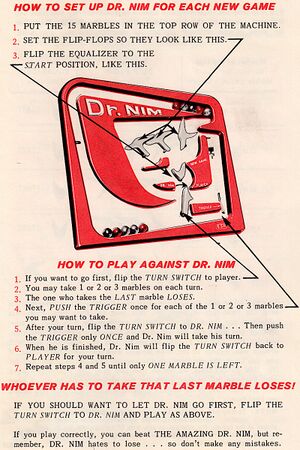
> Dr. Nim was a plastic toy invented by John Thomas Godfrey and published by ESR Inc. in 1966. It was the first mass-market consumer product explicitly marketed as a “computer game,”
See Nimbers, Surreal Number
1940, Westinghouse Electrical Corporation built the first Nim playing computer in 1940 and exhibited it at the New York Worlds Fair.
In Python
Nim Fanfiction
https://www.youtube.com/watch?v=MVRunwyoTMA
Nim Fanfic v.1
July 2056, the Nim population has hit a point of stagnation. My name is 1, I am a proud, yet worn out citizen, of what is known as the Nim nation for now more than five centuries. Since our formation in Europe in 1532 our population has not decreased nor increased. We remain a steady and horrifyingly tiresome sixteen individuals, stuck in what is now a seriously embarrassing hierarchical structure: the pyramid.
Our society used to be organised in the following structure:
1
1 2 3
1 2 3 4 5
1 2 3 4 5 6 7
We respond to a very simple set of rules that are the following:
(i) Only one couple is allowed at the time in Nim Nation
(ii) Nim citizens are only able to communicate with their immediate neighbour, i.e 1 and 7 can never be in touch
(iii) Only Nim’s of an identical position within our pyramid structure can navigate outside of the pyramid together at once
As you may imagine, the referral to multiple 1s, 2s, 3s, 4s and 5s was quite unsettling, raised jealousies and could get outsiders confused. The Nim Revolution, 1904, marked a turn in our history as new names were assigned to each citizen: 1, 2, 3, 4, 5, 6, 7, 8, 9, 10, 11, 12, 13, 14, 15, 16.
1
2 3 4
5 6 7 8 9
10 11 12 13 14 15 16
Embracing each citizen as individuals, through distinct names and physical features became the norm. Our diversity had finally become the trope for a fair representation of the self within a co-dependent society. The following year, 1905, the L-group composed of 3, 7, 13, 14, 15 and 16 wanted to go even further and re-considered our architectural ideologies. We wanted to implement a new set of rules:
(i) Nim nation is opened to groups as much as individuals one. It will no longer be a couple only experience.
(ii) Nim citizens should be able to engage with any Nim citizens and not only their immediate neighbour
(iii) Identity and social stature wouldn’t be limited to one’s position in the pyramid
(iv) Nim citizens should be able to navigate outside the structure with any other Nim citizens not only the once of similar structural stature
(v) The traditional pyramid structure has to become a structure amongst others, not the default structure
(vi) One’s fate shouldn’t be set in stone, one should have agency as to the path one chooses
(vii) Nim nation should be open to the growth of its citizens as well as its annihilation, retirement of its citizens or replacement of its citizens
Unable to convince the others of the necessity of the institution’s rewriting, our structure remained the same.
1: Psst.
Silence.
1: Pssst!
2: What?!
1: I’m not talking to you.
2: 3.
3: Hm?
2: I think 1 is trying to talk to you.
3: What is it?
1: I’m lonely.
3: We already talked about this.
1: Well it still hasn’t been solved.
3: I’m sorry there is nothing I can do about it at the moment, you could…
1: People assume because I’m at the top of the pyramid, everything is great for me! Ha, sure is a great bore. Five centuries of solitude, an omnipotent perspective that has no witness. No one to share my point of view with. To get any mundane experience across I need a waterfall of information to slightly hope one will get some kind of input and they might never understand.
3: I understand you! Or at least try too.
2: Quiet you two I’m practising.
1: And when I go, I go alone.
3: Well at least you don’t have to suffer the unreasonable ones of this row.
1: And when I fear, I fear alone.
3: You talk to me, sometimes.
7: Is one having a moment again?
3: Yes, yes, we’re trying to figure it out.
2: Sssh.
6: This again?
2: 1 is trying to annihilate us again.
6: Let them be, they will be picked at soon enough again.
2: Hmm.
1: And when I dream, I dream alone. 7: They got everyone up again.
3: Everyone’s up now.
1: Well not enough.
3: Let’s keep it quiet for now.
1: You know?
3: Tell me.
1: In dreams… I walk with you.
3: Roy?
https://hub.xpub.nl/soupboat/~gi/About_Nim/Nim_Fanfic-1.pdf
Nim fanfic v.2
July 2056, the Nim population has hit a point of stagnation. My name is 1, I am a proud, yet worn out, nimizen of what is known as the Nimation for now more than five centuries. Since our formation in Europe in 1532 our population has not decreased nor increased. We remain a steady and horrifyingly tiresome sixteen individuals, stuck in what is now a seriously embarrassing hierarchical structure: the pyramid.
Our society used to be organised in the following structure:
1
1 2 3
1 2 3 4 5
1 2 3 4 5 6 7
We respond to a very simple set of rules:
(i) Only one couple is allowed at the time in Nimation
(ii) Nimizens are only able to communicate with their immediate neighbour, i.e 1 and 7 can never be in touch
(iii) Only Nim’s of an identical position within our pyramid structure can navigate outside of the pyramid together at once
As you may imagine, the referral to multiple 1s, 2s, 3s, 4s and 5s was quite unsettling, raised jealousies and could get outsiders confused. The Nim Revolution, 1904, marked a turn in our history as new names were assigned to each nimizen: 1, 2, 3, 4, 5, 6, 7, 8, 9, 10, 11, 12, 13, 14, 15, 16.
1
2 3 4
5 6 7 8 9
10 11 12 13 14 15 16
Embracing each nimizen as individuals, through distinct names and physical features became the norm. Our diversity had finally become the trope for a fair representation of the self within a co-dependent society. The following year, 1905, the L-group composed of 3, 7, 13, 14, 15, 16 and myself wanted to go even further and re-considered our architectural ideologies. We wanted to implement a new set of rules:
(i) Nimation is opened to groups as much as individuals. It will no longer be a couple only experience.
(ii) A nimizen should be able to engage with any other nimizens and not only their immediate neighbour
(iii) Identity and social stature is not limited to one’s position in the pyramid
(iv) Nimizens should be able to navigate outside the structure with any other nimizens not only the ones of similar structural stature
(v) The traditional pyramid structure has to become a structure amongst others, not the default structure
(vi) One’s fate shouldn’t be set in stone, one should have agency as to the path one chooses
(vii) Nimation should be open to the growth of its nimizens as well as its annihilation, retirement of its nimizens or replacement of its nimizens
Unable to convince the others of the necessity of the institution’s rewriting, our structure remained the same.
1: Psst.
Silence.
1: Pssst!
2: What?!
1: I’m not talking to you.
2: 3.
3: Hm?
2: I think 1 is trying to talk to you.
3: What is it?
1: I’m lonely.
3: We already talked about this.
1: Well it still hasn’t been solved.
3: I’m sorry there is nothing I can do about it at the moment, you could…
1: People assume because I’m at the top of the pyramid, everything is great for me! Ha, sure is a great bore. Five centuries of solitude, an omnipotent perspective that has no witness. No one to share my point of view with. To get any mundane experience across I need a waterfall of information to slightly hope one will get some kind of input and they might never understand.
3: I understand you! Or at least try too.
2: Quiet you two I’m practising.
1: And when I go, I go alone.
3: Well at least you don’t have to suffer the unreasonable ones of this row.
1: And when I fear, I fear alone.
3: You talk to me, sometimes.
7: Is one having a moment again?
3: Yes, yes, we’re trying to figure it out.
2: Sssh.
6: This again?
2: 1 is trying to annihilate us again.
6: Let them be, they will be picked at soon enough again.
2: Hmm.
1: And when I dream, I dream alone.
7: They got everyone up again.
3: Everyone’s up now.
1: Well not enough.
3: Let’s keep it quiet for now.
1: You know?
3: Tell me.
1: In dreams… I walk with you.
3: Roy?
https://hub.xpub.nl/soupboat/~gi/About_Nim/Nim_Fanfic-2.pdf
Nim Paper Game
Nim Fanfiction Game
Submit to the Rietveld Journal #5
No-social-distanciation game for on the way
Yet again, our touch has known restrictions, regulations and innovations… no-social-distanciation game for on the way is a proposal to radically ignore the consequences of touch and engage with other in a playful, yet consensual way.
NSDG #1 is the Human Nim
The Nim game can be played in different ways, its main feature: two players can pick up a game of nim at any point with any 16 items at hand. Here is my proposal, you’re with a friend, a bit bored, comfortable yet looking for some excitement, what could you possibly do?
A Human Nim game!
Go on the streets, find 16 consensual Human-Nims and it’s game on!
The Human Nim
2 players
16 consensual Human-Nims picked randomly on the streets
4 rows (1, 3, 5, 7)
1 rule: Both players take turn playing, each player must dismiss at least one Human Nim at their turn, they can dismiss more than one Human Nims, as long as those are in the same row. The last player to dismiss a Human Nim has lost.
The Human Nims may choose to stick around or leave the players once dismissed from the game. This makes it more challenging for the players to have multiple games in a row.
About Modding
Chapter 2:"Game Modding: Cross-Over Mutation and Unwelcome Gifts" from "The Player’s Power to Change the Game" by Anne-Marie Schleiner
"‘Modding’ is a term that is used among game players and in the game industry referring to player-driven modification or transformation of a computer game."
"The cultural production of modding thus transpires between two distinct spheres of exchange and reciprocity, between commercialized and volunteered game producers, a contrast to the previous chapter’s sharing of unfolding games freely created among player-artists entirely outside of the game industry."
"As I enter into these questions of relations between di-ferent sets of cultural producers, I will compare modding to a relation of parasitism of a host(3). Michel Serres multivalent figure of ‘the Parasite’ provides a useful theoretical model for understanding how unequal cultural producers like amateur modders and professional game developers co-create digital games. Serres o-fers three possible definitions of the Parasite. In Serres’ first definition, the Parasite is defuned as noise in an informatic system. Secondly, the Parasite manifests as a biological infiltration within a larger hosting body, and thirdly, as the anthropomorphic poachers in Aesop’s fables of hospitality, for instance the hungry rats gnawing on cheese in a tax collector’s well-stocked kitchen(3)."
Ambiguous dynamic between modders and gaming industry. The players/programmers willing to change features of certain games for free are donating a service to the gaming community but also to themselves. They create features they'd like to benefit from themselves. Some of those modders also become part of the gaming industry, thus earning back from their previous time investments.
There lies also a pirate zone where gamers enjoy recently made modding that has not yet been assimilated and monetised by the gaming industry, but that are already available to gamers.
Chapter 26: Repetition, Christopher Hanson (The Routledge Companion to Video Game Studies edited by Mark J. P. Wolf and Bernard Perron)
Modding has enabled the game industry to create what is called "replay value", with only slightly different features being changed on game characters, which might have slightly different access to a world-game, enables gamer to go multiple times through a same game/same décor, with what feels like a completely new point of view.
"The pronounced difference in cost between games designed for arcade and home markets has effected an assessment of the price of the purchase of a game for the home as measured against its long-term recreational use-value; this valuation of a game’s potential for pleasurable return oninvestment is termed “replay value,” by which a game’s potential for continued play after its completion is measured. As such, games designed for arcade settings tend to demonstrate broadly dissimilar tendencies toward average length of play, while games designed for domestic settings (which are thus sold to the consumer) are characterized by significantly longer investments of player time and a pronounced propensity toward game designs that incorporate a degree of finality and completion; this tendency toward games that can be “finished” has placed an increased emphasis on “replay value” for home games as a means to increase the player’s desire to play the game again after it is has been completed—and thus increasing its perceived recreational use-value."
(Non-Mainstream?) Video Games
The Beginner's Guide
Davey Wreden, in real life, is the creator and designer of The Beginner's Guide and The Stanley Parable. Davey Wreden is also brothers with famous content creator Doug Doug. Within The Beginner's Guide, he is the narrator and as such, one of the main characters.
The Beginner's Guide is a narrative video game for Mac and PC. It lasts about an hour and a half and has no traditional mechanics, no goals or objectives. Instead, it tells the story of a person struggling to deal with something they do not understand.
Tropes found in the Video Game
Some interesting Wikipedia quotes:
[1] "This game, its design in stark contrast to the others Coda had made, included puzzles that were intentionally designed to be almost impossible to solve, such as an invisible maze, a six-digit combination that the player must randomly guess, and a door that cannot be opened from within the room the door leads out of. Wreden found that when he was able to use various programming tools to bypass these, he ended up in a gallery with a message from Coda directed at him personally, thanking him for his interest in Coda's games but asking him not to talk to him any more, nor to showcase his games to others. The messages implied Coda felt that Wreden mistook the tone of his games as a sign of an emotional struggle and was missing the point of why he had engaged in game design, as well as accusing Wreden with modifying Coda's games to add more symbolism, and that Wreden's actions had betrayed Coda. As a result, Wreden felt terrible about what he had done, and thus reveals that the purpose of The Beginner's Guide is to try to reconnect to Coda by sharing his games with the public at large and to hope to apologize for his actions."
[2] "Christopher Byrd, writing for the Washington Post, points to blog posts made by Wreden after he had received a great deal of attention following the re-release of The Stanley Parable, and that the game's version of Wreden is really a fictionalized version of himself acting as an unreliable narrator, building upon his own personal experiences from the sudden media spotlight in the relationship between the fictional Wreden and Coda."
[3] "Another interpretative theme taken by some is that the game is presented as commentary on the role between the video game developer and their audience. PC World's Hayden Dingman believed the game was designed to demonstrate the fallacy of the Death of the Author essay applied to video game development, in which commentators attempt to attribute aspects of a game to how the game developer approached it, as opposed to considering how the game affected themselves.[11] Gamasutra's editor-in-chief Kris Graft notes that, as the game attempts to deconstruct the way players will interpret narrative video games, any attempt to interpret the deeper meaning behind The Beginner's Guide is paradoxically "committing all of the sins" that the game presents as problems with player interpretations of games.[12] Laura Mandanas, writing for Autostraddle, described the game as "a man (poorly) coming to terms with his hugely overinflated sense of entitlement", interpreting the game's themes as not only applicable to game development, but also to inter-personal relationships.[13]"
[4] "Some have taken the game to be a work of non-fiction, in that the games presented are works of a real developer other than Wreden, and that the game itself could be seen as an unethical use of someone else's work and potentially copyright-violating. In considering this aspect, Destructoid's Laura Kate Dale commented with later clarification that the game was short enough to fall within the Steam refund window for those who believed the game was non-fiction and thus contained stolen works to return the game.[14] Dale's statement, prior to clarification, led to some controversy in that Dale was suggesting misuse of the Steam refund system, though her clarification made it clear she was addressing those believing it to be non-fiction. The controversy led some to point out that the interpretation of the game was very personal, differing between each player; Wreden himself in light of the controversy refused to affirm or deny any interpretation of the game, until confirming the game's ultimately fictional nature in an in-depth interview with the podcast Tone Control.[15][16][17]"
See alsoInteractive storytelling, Dialogue tree, Metafiction and The Magic Circle (video game)
Echochrome
Time only given by audio clues and Ateliers enable timeless roaming.
Video Game inspired by Maurits Cornelis Escher's work
Loot box(es)
Future Loot Box
Loot Box Brainstorm: https://pzwiki.wdka.nl/mediadesign/Future_Loot_Box
A Box in a Box in a Box is a Loot Box
16.02.2021, with Carmen and Emma
Brainstorm on: https://pad.xpub.nl/p/aboxinabox
This box found you for a reason
The publication is a box.
Each box, that has a same "cover" (outside looks), contains a series of simple games with different rules (see examples) that will uncover ideological awareness. Objectives behind the games are more complicated. Create a world around "simple games", procedures and approach them in a way to subvert the rules and expectations of common games.
PART 1
Examples of games to be found inside the boxes:
"Crooodd(ie)s"
Rule number 1: You cannot write letters.
Rule number 1: Only write a word a day.
Rule number 1: Fill in the definition of the word.
Rule number 1: across definitions only on monday.
Card games
Context number one: with instructions (the instructions are the cards in themselves).
So like a Card with a command that prompts you to do something very specific.
Pick other players without them knowing.
Commands that imply the inversion of what we would usually do.
"Zupelz"
All of the pieces with the same shape.
Puzzle maker can also be puzzle solver.
Incomplete puzzle.
"aMAZ-ing"
You know where you are going
A real-life maze.
Escher-style.
Classical board game
empty, little packages, no rules, but the player will find out/ come up with the rules,
PART 2
Alternative Structures:
Alternative 1. -
The publication is a box.
Each box, that has a same "cover" (outside looks), contains a:
1. same "game-grid".
2. same code of conduct.
3. different rules.
The aim of the game depends on the rules contained inside.
Alternative 2. -
The publication is a box.
Each box, that has a same "cover" (outside looks), contains a:
1. same "game-grid".
2. same code of conduct.
3. no rules.
The aim of the game is to figure out the rules.
Alternative 3. -
The publication is a box.
Each box, that has a same "cover" (outside looks), contains a:
1. different "game-grids" with their own set of rules.
2. same code of conduct.
The aim of the game is to have a good time. For good time we understand a stimulating experience that will foster creativity as well as bring you to a higher level of consciousness meaning, the overproduction of serotonine.
Special Issue 18
Week ONE
with Carmen
Script output
Take #1 Carmen and Gersande on an easter Monday that felt like a Sunday.
G: There is a man on a bench eating a sandwich.
C: Fouf. Can you repeat slower?
G: There is much space around us today in the sun.
C: My god. I have no idea what you are saying.
G: It’s not really ideal but whatever.
C: Hm. I thought I understood French better.
G: The thoughts come and go around us, but they seem to be right thoughts.
C: Actually I think I’m a bit hungry.
G: But we’re looking for a bit of shadow, because thinking, especially in the sun, is tiring.
C: Now I understood Camembert.
G: It seems that our co-editor has said a swear-word, I understood “shit” but maybe it was something else.
C: Hm, huh, my head is going in a bunch of directions at the same time, I don’t know which one to take.
G: We could go in all directions, to the right to the left, straight forward backwards, in front, up and down, euh, but we chose an uncertain direction.
C: I don’t know.
G: We don’t know anymore.
C: Exactly.
G: Exactly, I think that we are meeting in the middle of the road, multiple thoughts, thoughts that go in all directions, but especially an uncertain direction.
C: I was 33, I was living in Amsterdam and the world had turn into something truly weird.
G: It’s been three years that we are here in Amsterdam in uncertain conditions, while the world is changing, we are still going in multiple directions, but especially an uncertain direction.
C: And now I ask to myself what’s gonna happen? I don’t know what is gonna happen next month or next year?
G: We don’t know where we’re going, we don’t know what we’re doing and it’s still very uncertain, yet we know exactly what exactly means.
C: Today I put on some weird clothes.
G: The truth, who knows? Not me, nor Carmen.
C: But it’s sunny, everything is fine, the truth is I’m hungry, we could eat.
G: It seems the truth could be found in the shadow, who knows? Not I, nor Carmen know.
C: Or maybe we could also go to the coffeeshop.
G: I heard coffeeshop, we are heading to the coffeeshop, it is uncertain what kind of coffeeshop has been mentioned, but it is certain, for once in this uncertain direction we are heading to, that we are heading to the coffeeshop.
C: Now I started smoking this thing that is much better, because it doesn’t destroy your brain, and it’s called CBD, and it’s much better.
G: Many many, certainties, that we are almost arriving at the coffeeshop. I can see the shadow of the coffeeshop, we arrived.
C: Shall we turn right?
G: Indeed, it is the coffeeshop, we are living you here. Thank you for following our uncertain directions. In a certainty of arrival, this was a very bad conclusion, but thanks for listening.
C: Did we arrive?
Rijpgracht 6 publication for Kingsday
Event Description
"Holaaa 🪧 THIS WEDNESDAY 27.04 FROM 10 am-6 pm De Rijpgracht, Amsterdam, Netherlands
ROOKIE is the first public encounter of Espacio Estamos Bien.
EEB started by plotting around the idea of a new space in Amsterdam. We felt the need of a place –not necessarily a physical one–that could provide us with an affective and supporting context. The course was set with a sketch of a place that could contain events and exhibitions, with nomadic and flexible models on our mind, a space for those who do not belong in the institutional circuit. A space that is always changing, always moving, but always available.
Our first rendition will be displayed in the back of our car during King's day. We will explore the potential of showcasing a selection of merch from artist from Chile, Colombia, the Netherlands and more, on a day when free exchange and commerce are allowed. We invited Proyecto relámpago (CO) Casa Rat Trap (CO) and Ediciones Rocashop (CL) to make the selection. A live program will accompany the shop, with performances, music, and more.
Artists invited: N13bl4 Polvoindigo Fixme studio Perro Centinela Jeronimo Velasquez Chao Antonia Connidona Ol dirty Things Juan Sebastian Rosillo Isabel O’ Toole Giovanni Vargas El Futuro ediciones Hocus Locus Publishing Juan Manuel Rosero Christine Bjork Juan Ospina Mala Influencia Punk Posters Alfabeto Jason Fonseca SOLA- colectiva de diseño Willow Florez Jose Darcy Cabrera OASIS El corruptor Simonnetta Valeria Giraldo Juan Daniel Velasquez Pablo Bardinet Dasha Leontova Merceria Clara Casco Antiguo Laura Lopez Willow Flores David Alejandro (Ausencia.NADA) Gersande Schellinx Carmen Gray Brass Neck Press Noe Lafranchi Regia Studio Oriol Cabarrocas Rebecca Solari Hugo Beheregaray Eva Mahhov Antonio Duarte Macarena Ternicien Daniela Parra Valentina Peña Caroca
Performances by: Content&Contenido and Mehmet Suzgun Music by Arif, Carmen Gray, Funkyspunk and Cascabel (Juan Sebastián Rosillo)
Logo by Carmen Dusmet Carrasco Logo animation by Carmen Dusmet C. and Céline Hurka Jingle by Antonio Duarte GD by Levi van Gelder"
Week TWO
with Carmen and Alex
About
Take advantage of the space created by sounds, to create a real fake space were the three collaborators can discuss and evolve in what seems to be a same environment.
Each [ ] is a sentence of any wished length.
Alex, Carmen and Gersande are sitting on a bench in a real fictional space. It is sunny around them. A slight breeze brushing off their cheeks while they discuss something of utmost importance: what is happening around them.
Gersande's Script
Alex: [ ] … [ ]!
Carmen: [ ]!
Gersande: [ What do you mean ]? Qu’est-ce que tu veux dire?
Alex and Carmen are silent for a moment, thinking about the question Gersande asked.
Alex: [ ].
Carmen: [ ]…
Alex: [ ]?
Carmen: [ ]! [ ]?
Gersande: [ When I hear this noise it makes me feel like I’m on a holiday, almost like being on a boat, one that has wheels , one that could be a boat, but also just an animal]. [ The noise happened again, a distant call, followed by laughs ]… Quand j’entend ce bruit, j’ai le sentiment d’être en vacances, comme être sur un bateau, qui a des roues, du genre qui a des roues, mais aussi simplement un animal. Le bruit est encore survenu, un appel distant, suivit de rires.
Carmen: [ ]. [ ]. [ ]?
Gersande and Alex burst out laughing.
Alex: [ ]. [ ]. [ ]. [ ]!
Alex made a good point. Everyone has a moment of reflection in silence.
Gersande: [I never looked at it this way]. Je n’y avais jamais pensé sous cet angle.
Alex: [ ]?
Carmen: [ ]!
Alex: [ ]: [ ]!
Carmen: [ ].
Gersande: [You never ate steamed potatoes]? Tu n’as jamais fais de patates douces à la vapeur?
Carmen: [ ]. [ ]. [ ]?
Gersande: [Do you think the sky will still be blue tomorrow]? Tu penses que le ciel sera encore bleu demain?
Carmen: [ ].
Alex: [ ]. [ ].
Carmen: [ ]!
Gersande: [It must be someone howling far away]! Cela doit être quelqu’un qui appelle au loin!
Alex: [ ]!
Gersande: [Who is this]? Qui est-ce?
Alex's Script
Alex: I knew the seagulls would come ask for food at some point. Look! Знаех си, че чайките ще дойдат да ни тормозят за храна по някое време. Вижте!
Carmen: [ ]!
Gersande: [ ]?
Alex and Carmen are silent for a moment, thinking about the question Gersande asked.
Alex: To be honest, I have never thought about it. Честно казано, никога не се бях замисляла за това.
Carmen: [ ]...
Alex: Do you think we should go and talk to that person? Дали не трябва да идем и да говорим с този човек?
Carmen: []! []?
Gersande: . [] ...
Carmen: [] . []. []?
Gersande and Alex burst out laughing.
Alex: Ok, that might make a total sense. But perhaps we were completely wrong. Looking at them now, I think they just wanted to have some ice cream. Pfff, maybe we were completely wrong! Окей, в това може би има смисъл. Обаче, може и да сме в грешка. Като ги гледам сега, ми се струва, че просто са искали малко сладолед. Пффф, май не сме изобщо прави!
Alex made a good point. Everyone has a moment of reflection in silence.
Gersande: [ ]
Alex: Why not go join them? Защо да не се включим и ние?
Carmen: !
Alex: Well, what I meant was this: the sun is too strong, we should put some suncream! Ами, имах предвид следното: слънцето е прекалено силно, трябва да си сложим малко крем!
Carmen: .
Gersande: ?
Carmen: . . ?
Gersande: ?
Carmen: .
Alex: Yes, I was also planning to leave at some point. I am wondering if it's not time to do that now. Да, и аз планирах да си тръгна по някое време. Чудя се дали сега не е точният момент.
Carmen: !
Gersande: !
Alex: Hah, exactly! Ха, точно така!
Gersande: ?
Carmen's Script
Week THREE
caretaker with Kamo and Erica
Introduction
Welcome to the Emergent Opera’s Overture Atlas.
Stepping out of the traditional model of the opera and using its different features as tools to make possible this new model of musical and sound research environment.
The emergent opera, practically, still has all the components of a classical opera: overture, act 1, act 2, act 3, the grande finale and of course entr’actes. Yet, those different components do not suffer any kind of linear regime. As a music conductor, you might play those different components, one way, or another, briefly or repeatedly, together or individually… the possibilities are endless. The Overture Atlas is a space in which the opera could be orchestrated… by anyone! The opera, constantly shifting. It comes into being with the listener’s urge to activate the Overture Atlas. Become a conductor and explore all of its potential.
Editorial
🎺🎺 WEEK THREE is an Emergent Opera! 🎺🎺
What does it mean? This week we invite you to make content within a common structure, instead of finding a structure when the contents have already been made! An emergent opera where each property is part of a bigger whole, that comes together in the becoming...
Pick one part of the opera!
Structure: Emergent Opera Pick Your Opera Slot
Overture: jumbo supi
Act 1: Emm + Jian
Act 2: Miri + Carmen
Act 3: Al (Voices of hierarchy orchestra)
Curtain Call/Grand Finale/Finale: kim-chae
Below you can find some vocabulary that is usually related to opera. You can use the definitions or you can freely interpret them in order to build your piece.
Emergent Opera Glossary
INTERFERENCE
Blur your contribution across other pieces.
OPEN CALL
Your piece asks for external (but what does it mean external at the end?) interventions.
OVERTURE
Which refers to an opening or a hole.
ARIA
A solo piece which focuses on emotion.
SUITCASE ARIA
A signature solo piece (performer's trademark) for a performer that returns often.
Repetition, jingle-like piece, motif, virtuoso piece, stunt.
RECITATIVE SECCO
Minimal instrumentation with a free rhythmic style where the singer/voice can do as pleased.
RECITATIVE STROMENTO
Rhythms are dictated and should be followed.
RECITATIVE
Imitates rhyhtms of the spoken word or used in place of spoken words.
DUETS
Performed by two people or two contributions (botta e risposta/pingpong/back and forth).
ORCHESTRA
Instrumental only.
LIGHTING
Sets the drama atmosphere, enlightens, puts in the shadow, etc... (Can be connected to the listening experience live).

Libretto
Libretto For this week's release, we'd like to create a Libretto! Please share your notes, scores, texts, lyrics or any other related drafts to your contribution with us in order to make it possible.

Entr'actes
solo piece
The Entr'actes 1., 2. and 3. are the intermissions of the Emergent Opera. Meant as a one-person orchestral interlude for the listener's ears. The Entr'actes are meant as a musical narration with no intelligible language. Entr'acte 1. is an improvised piece where the player talks through the trumpet, rather than playing the trumpet, resulting in scratchy sounds and chaotic rythms and intentions. Entr'acte 2. is a naïve score, transcribed from an improvised numerical chant. While Entr'acte 3. uses the noise signifier of a poem rather than the signified sounds of that poem and the story it could tell. This research is an attempt at squeezing out of words their inner emotions, not to distract the listener from feeling while looking for meaning.
ENTR'ACTE 1 - LISTEN
ENTR'ACTE 2 - LISTEN
ENTR'ACTE 2.2 - LISTEN
ENTR'ACTE 3 - LISTEN
Exhibition: The Headquarters at PuntWG
Read more about the exhibition
Tools built for The Guild
Modular Text
Written for the Writing Department: A Laborious Portrait.
Week FOUR
with Jian
About
For the Jingle Board Parliament, the group raised the question of found footage as a material, especially anchored in Pop Culture. A space that can be uncomfortable for some. While Jian immediately felt natural to turn to friend group-chats in order to seek references and material, Gersande turned to a more mundane response. Reacting to those often unfamiliar sound footages with a spontaneous manner, as one would in a live interaction. Reactions that could also apply to other sound footage.
Gersande also found of interest to give in similar manner (the reactions to the Viral Voices being somehow neutral as applicable to different other footage) to explore the potential of the non-human actors in the Jingle Board Parliament, wondering: what would those be? And how would they react to their surroundings? Would they also be involved in the politics of the room or insensible to it as not concerned or used to it. Might they be as moralistic, ethical or judgemental as the human actors in the room? Is it even possible to make non-human actors speak up without personifying them in a human manner?
GO TO THE JINGLE BOARD PARLIAMENT HERE
Reaction to: Viral Voices of the WWW
00:42 Alexandra Ocasio Cortez
00:04 Cheering-Applause.mp3
00:24 Bob Ross
00:02 Thank-You.mp3
00:04 Kamala Harris
00:01 Well-Said.mp3
00:39 Miriam Margolyes
00:05 Ha-ha.mp3
00:11 Owen Unruh
00:02 Do-That.mp3
00:02 Robert Habeck
00:01 Just-Bam.mp3
00:09 Rumors say it is James Baldwin
00:01 Just-Same.mp3
00:17 Tony and Ezekiel
00:01 Who-s-Tony.mp3
00:01 Fuck-You.mp3
Objects of the Parliamant
00:02 Astonish Glass
"I can't believe your eyes!"
00:03 Blue Pen
"Eh! Take it easy there. No need to push so hard."
00:02 Bottle Water
"Yes, that's it! Drink up."
00:04 Chair Man
"Could you please lean a bit more to the left already? My legs hurt."
00:02 Creacky Floor
"He, psst, nice shoes!"
00:04 Sad Suit
"It's been ages since you last took me out and this is where you take us?"
00:04 Showcase Briefcase
Close me when you're done would you? Not everyone needs to see me undress."
00:06 Sneaky Snickers
"What? You're ashamed of us? We can't be hidding under there forever!"
00:03 Tameless Table
"Could you please not put your snots under there?"
00:03 Tight Tie
"It's getting really warm in here."
Instrumental and Notation Research
Instructions for a Duet
Instrument ideas
1. Hollow box with hidden "noise", sound source. Like a drum. Design pattern at top, open as a gate to the hidden source. What could be inside? Strings? Metal? Beans/seeds?
2. The sound of letters... letters as instruments? Letter-shaped pipes, or horns.
3. Recordable voice module (geluidsmodule) to make a shouting book, that could be a choir if opened in a certain way. A publication that releases sound when flipped through, can be played like an accordion. An instrument for public surprise. Play casually while doing a mundane activity. Where is the sound coming from? This idea is... expensive.
Contactless Instrument
Theremin: no physical or no material touch rather.
Scores with depth
Research
Week FIVE
with Chae
Raw Text
If we censor art what is left to discuss:
why art has been censored maybe. Or would that also be censored? Something like the liar's paradox as mentioned by Dennis the Pillow in Everything is Alive. Is censorship openly discussed, out there, if censorship there is? "I am lying" says the liar. Would censored art be censored to discuss? A motivation to rename, rebrand, re-contextualise. Be under the radar, under-scrutinized in opposition to overanalysed.
If we understand art what is left to discuss?
In a book I am currently reading, Weight of the Earth The Tape Journals of David Wojnarowicz, I read the following: "I liked that things carry the possibility for unlimited interpretations." Oh how I like this image. Oh how I rediscover this thought I've had at many occasions: that of a text with million stories, as each set of eyes has a different rhythm, attention span, assumptions of certain words, sentences, definitions, might skip over a sentence, some letters, misconstruct narration or structure... so many variables depending of the reader, leaving the text to interpretation, leaving the "things" with the possibility for unlimited interpretations.
If we misunderstand art what is left to discuss?
I am 126 pages into the book and for the first time I smile and fold the bottom of the page, underline this sentence as not to forget its placement. Not that I didn't enjoy the book previously, but I recognised something in this sentence, I wanted to mark down, as to acknowledge it and be able to come back to it at any given moment. Not to censor, rather to underline.
Notes from Chae
What if we leave out very concrete parts? The ones that I stroke out.
Can this trigger imagination? Like what if we beep it out or put highlight sounds (literally attach a mic on the tip of the highlighter and record the sound of it)?
I love everything is alive too btw. My fav is a grain of sand and glass.
This text you wrote triggered me to overlap the act of highlighting and censoring/deleting. During the Japanese Colonial Period in Korea and from 60s to 80s during the military government, a lot of newspapers were censored, published as blank blocks or with blackened lines.
Now I am highlighting this sentence, "Not to censor, rather to underline".
Highlighting and deleting texts within the line. Same movements. Different outcomes, with different intentions.

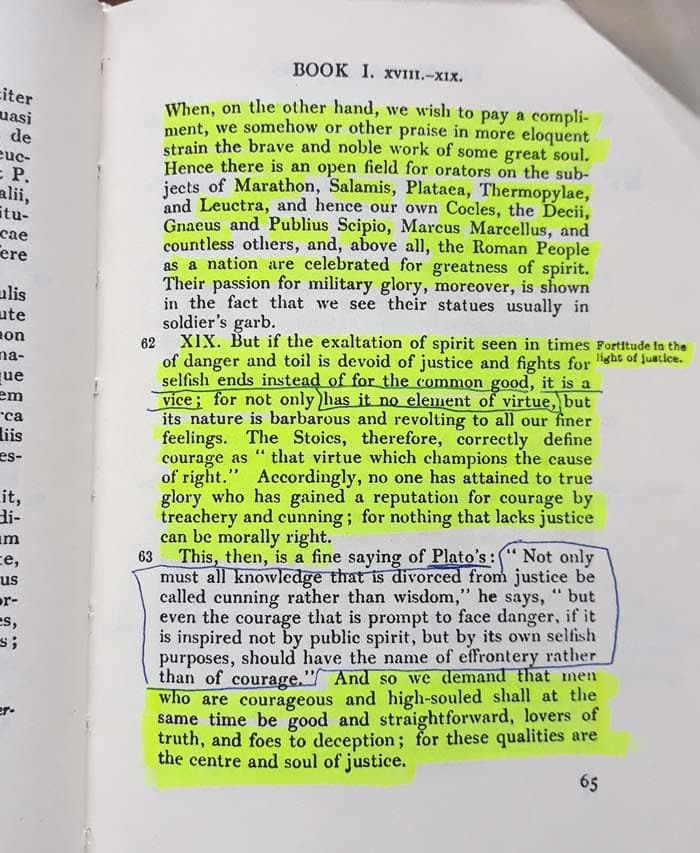

Edited Text
If we censor art what is left to discuss: the reasons, the motivations behind the censorship of art perhaps. Or would that also be censored? Something like the liar's paradox as mentioned by Dennis the Pillow in Everything is Alive. Is censorship openly discussed when censorship is also taking place? Can censorship be discuss simultaneously while it is happening? "I am lying" says the liar. Would censored art be censored to discuss? A motivation to rename, rebrand, re-contextualise. Be under the radar, under-scrutinized in opposition to overanalysed.
If we understand art what is left to discuss? In a book I am currently reading, Weight of the Earth The Tape Journals of David Wojnarowicz, I read the following: "I liked that things carry the possibility for unlimited interpretations." Oh how I like this image. Oh how I rediscover this thought I've had at many occasions: that of a text with million of stories. How? Well, each set of eyes has a different rhythm, a singular attention span, personal assumptions of certain words and sentences and definitions; some might skip over a sentence, some letters, misconstruct a narration or a structure... so many variables depending of the reader. These different circumstances put together, leave the text to interpretation, leave the "things" with "the possibility for unlimited interpretations."
If we misunderstand art what is left to discuss? I am 126 pages into the book and for the first time I smile and fold the bottom of the page, underline this sentence as not to forget its placement. Not that I didn't enjoy the book until that moment, but there is something in this sentence I recognised. Something I wanted to mark down, as to acknowledge it and be able to come back to it at any given moment. Not to censor, rather to underline.
What is left to discuss? The ones that I stroke out. I left them out, for they are too concrete.
Does it trigger your curiosity? If it beeps, does it trigger your imagination? If it is highlighted, is there any way you would not read it? Probably your eyes would roll back over, again and again. Like marbles, sliding towards the highlighted sentences. Like magnets, drawn to their opposites: a fluorescent body, so unnatural to our eyes that they are not to be missed. Impossible to ignore, a coloured scream.
If we underline censorship what is left to art? The questions above triggered me to overlap the acts of highlighting and censoring and deleting. During the Japanese Colonial Period in Korea and from the 60s to the 80s during the military government, a lot of newspapers were censored, published as blank blocks or with blackened lines, a colourless shout. Highlighting and deleting texts within the line are the same movements. They offer different outcomes, with different intentions. To highlight becomes a form of militantism, to delete presents a twisted kind of activism. A space to enhance words, another to strike absence.
For now I want to highlight this sentence, "Not to censor, rather to underline".
Week Six
with Carmen
The Kut-Up Method
The Kut-up method is an illustrative way to create new content for theoretical reflection and aestehtic contemplation with an undefined grid. Inspired by William Burrough’s & Brian Gysin Cut-up works in The Third Eye and Digital Workers found Varia Zone.
Thinking of diffractive ways of reading and methods to do so, Carmen and Gersande tried to imagine "unintentional" ways to edit text.
How to come up with a new content of already existing texts? How to create new connections between contents, without being biased by our own influences and expectations of textual matter?
The Kut-Up Method is inspired by existing works and initiatives, combining systemic, visual and textual tactics.
A naïve approach to text editing, focusing on an illustrative grid, instead of a formal one, in which text can be added and mixed on a 50/50 spatial occupation.
This approach does challenge the notion of copyright and how to treat caption and footnotes. As not to ignore the sources of that newly made text-collage. Thus the different experiments with colours, typefaces and outlines to find a way to map or underline those differences. Or at least make those differences noticeable, maybe legible. The text thus comes in two shapes: the mapping of the inputs and the output.
Process Log
1. Take two texts/images/illustration that have or have not anything in common
2. Create a hand-made lay-out, filling an A4 (or more) sheet of paper with different kind of “box”-shapes.
3. Use a symbol, color or typeface to indicate the two different sources in your footnote at the bottom of the page and use it to differentiate your content without interfering with it.
4. You just created your very own Kut-up text!
5. Read it out loud with or without your partner(s).
SI18 Release
First Draft
SI18 REVIEW
The third and last issue of the first year Experimental Publishing (XPUB) students, Radio Implicancies: Methods To Practice Interdependencies, is a series of eight, increasingly ambitious, weekly released sound publications. While the name of this publication might give you the impression that those periodical releases were broadcasted, they very much took place behind closed doors, amongst the group of students themselves…
Released for the very first time on the 12th of April, the twelve members of the group, who where shapeshifting each Tuesday of the week into their own audience, constantly shuffled positions in the overall work infrastructure until their very last release on the 21st of June.
This modular approach to work positions enabled an interdependent publishing structure in which different figures of agency took turn in order to share responsibilities in a sustainable manner.
Certainly captivated by the diversity in shapes, contents and experiences offered by the Special Issue 18’s eight sound publications, you might wonder: but what is it all about? The time pressure and weekly format framework left the overall project stuck under the surface of the water, as under an ice floe. Yet, the time spared on reflecting over past releases was invested in a bold pace of exploration, in which each week the group has re-conceptualised new work methodologies.
The urgency of experimenting with new infrastructures and breaking down mainstream hierarchical ones, took over the reflection of the resulted emergencies within each project. The ice floe broke at some place, enabling water flows, but those remained disparate, a stream still waiting to be connected.
Somehow estranged from everyones’ work progress, all the members of the group would walk into a dedicated room every other Tuesday of each week unaware of what kind of experience they would step into. Some publications even shifted from edited projects to live performances, presenting tools, interface or instruments for the public to thread all the pieces together themselves.
The third week release, Uneven Patterns, was the first milestone, in which the release’s care-takers took the role of editors. The listener’s experience evolved from that of a brutal unintentional edit of disparate sound-works, to an intentional curated piece, interlaced by a common rythm: that of different binding sounds. The theme presented by the editors was inviting in an non-restrictive manner.
From then on the publications’ care-takers(1) became the heart of each weekly publication.
On the fourth week, the Emergent Opera’s care-takers introduced a new kind of release format: live edit. The release’s interface, unlike the up-to-then linear structures, a circular constellation of sound tracks was activated live on the day of the release. instrument-like rather than a track
(1) care-takers a name given to a small group of students, responsible of the overall outcome of that week’s publication.
Final Draft
SI18 REVIEW
The third and last issue of the first year of Experimental Publishing (XPUB), Radio Implicancies: Methods To Practice Interdependencies , is a series of eight, increasingly ambitious, weekly released sound publications. While the name of this publication might give you the impression that those periodical releases were broadcasted, they very much took place behind closed doors, amongst the group members themselves…
Released for the very first time on the 12th of April, the twelve members of the group, who where shapeshifting each Tuesday of the week into their own audience, constantly shuffled positions in the overall work infrastructure until the last release on the 21st of June. This modular approach to work positions enabled an interdependent publishing structure in which different figures of agency took turn in order to share responsibilities in a sustainable manner.
Certainly captivated by the diversity in shapes, contents and experiences offered by the Special Issue 18’s eight sound publications, one might wonder: but what is it all about? The time pressure and weekly format framework left the overall project stuck under the surface of the water, as under an ice floe. Yet, the time spared on reflecting over past releases was invested in a bold pace of exploration, in which each week the group has re-conceptualised new work methodologies. The urgency of experimenting with new infrastructures and breaking down mainstream hierarchical ones, took over the reflection of the resulted emergencies within each project. The ice floe broke at some place, enabling water flows, but those remained disparate, a stream still waiting to be connected.
Every other Tuesday of each week, somehow estranged from everyones’ work progress, all the members of the group, except the care-takers (a few members responsible of the overall outcome of that week’s publication), would walk into a dedicated room unaware of what kind of experience they would step into. Some publications even shifted from edited projects to live performances, presenting tools, interface or instruments for the public to thread all the pieces together themselves.
The third week release, Uneven Patterns, was the first milestone in which the release’s care-takers took the role of editors. The listener’s experience evolved from that of a brutal unintentional edit of disparate sound-works, to an intentional curated piece, interlaced by a common rhythm: that of different binding sounds. The theme presented by the editors was inviting in a non-restrictive manner.
From then on the publications’ care-takers became the heart of each weekly release.
On the fourth week, the Emergent Opera’s care-takers introduced a new kind of release format: live edit. The release’s interface, unlike the up-to-then linear structures, took the form of a circular constellation of sound tracks, an instrument that can be activated by any willing participant, generating a new kind of audio-collage.
This potential for more performative and interactive interfaces inspired the care-takers of The Jingle Board Parliament to challenge said format on the fifth week. For the first time, the potential of found footage in media and pop culture, within a short-format restriction, got encouraged. The occasion to experience and command a once in a lifetime political landscape hosting an eclectic assemble of voices.
The instrument became voice. While dialogues were emerging out of cheer spontaneity, the Nested Narratives release was the occasion to reflect together on a textual net around a given refrain. One that would weave the diverse reflection, on a common problematic, of makers and listeners together…
And the voices carried methods. For the first time in months, the care-takers decided to take the bull by the horns and propose to confront methodologies upfront with the Sharing Methods for Diffractive Reading cookbook. The occasion highlighted that however considerate a method might be, different texts need different care and attention.
This intricate publication blew a wind of spontaneity to the last week’s release. Each day, the different contributors would react to one another with daily (short-) uploads on the Unfolding [ ] Implicancies platform. A final interface with data strata of all kind resulted in a generous open-end: a rhizome narrative with no top nor bottom, no left or right, where what ends is where that begins.
Visuals Drafts
XPUB2 2022-2023
Office for Small Decision Making
Plan B, September 2022
with Carmen Gray and Mariana Jurado Rico
About
"The Office for Small Decision Making has been given the unique opportunity to set their Office and use the vacant space of Plan B during the month of September.
Unfortunately, due to budget cuts the OfSDM will only be able to occupy the current premises for a total of three days and three days only, with a number of ad hoc additional hours..
Due to the exceptional character of such a short-term instalment, the Office members instigators do not get any remuneration to conduct proper job interviews to hire more Office staffs. Having the opportunity not to pay only a few Office members, the OfSDM concluded that any temporary employee working on the base of free volunteering are welcome to call themselves Office members. Therefore, any client of the Office can assume corporate status when participating in any Office activities during Office hours."
Excerpt from Third Office Meeting Transcription made by the Chief Secretary
Chief Secretary's Paperworks
Office Manuals Junior, Teenage and Adult
Small Chair Inventory Catalogue
Events
All following excerpts are from the Third Office Meeting Transcription made by the Chief Secretary
Onboarding day
"The onboarding day at the office takes place on the 10th of September, on which occasion all Office members and clients will be briefed on the Office’s guideline, Office rules and upcoming days of work.
This day will be the occasion for new Office members and clients, to be introduced to the Office’s new facilities, meet one another and share their hopes for the short-coming and small ambitions of the OfSDM.
The Office members will welcome potential clients into the space from 5PM onwards, the introduction to the office’s rules and facilities will then be ongoing until 11PM where the Office will conclude its first day in service."
Auction of favours
"On the 17th of September, an auction will take place for Office members and clients to determine who will take which small chair home with them.
Artist Carmen Gray has given as condition to the donation of her Small Chair Collection to the Office the dissemination of the collection amongst autonomous parties.
Therefore the OfSDM has decided to hold an auction of favours, no small chair will be sold, where individuals part of the community of the Office can acquire a small chair through trade.
This will be an important step for the Office to spread the facility's furniture as it will be already time to think of the ending of the OfSDM within the space of Plan B for the next week.
As a survival tactic, for the Office has no means to survive in a comm on space, Office members decided to spread it, scatter its body, to plant seeds of Small Decision Making tactics and tools beyond Plan B."
Karaoke Cocktail Party
"As a farewell cocktail party a karaoke night will be held during the last opening hours of the Office on the 24th of September from 5PM to 11PM.
It will be the occasion for all Office members and clients to get together, celebrate a short time of labor and the achievements and failures the Office will have managed the past weeks.
As such, the OfSDM has decided to leave aside all insipid working hours one would experience in another kind of working environment that benefits from a more significant budget and will embrace all milestones any business would experience in a longer lasting time, in a smaller amount of time.
These three milestones were made possible by different third parties joining the Office members as host, musician, or else, for one night. The OfSDM is very grateful to count those external partners amongst their own for the time of the Office’s stay at Plan B."
Graduation Project Proposal
Week 1
Starting Points
19.9.2022
Looking back at my first year, I took from it your comments and my enthusiasm at a growing interest in developing a practical and theoretical writing practice around my practice as a Curator and Facilitator of working-infrastructures, as well as specific projects (recent exhibition at Plan B in Amsterdam was my first experiment around this research/exercise).
Along this writing practice, I’ve been really interested lately in prototyping “nomadic shelves” (shelves one can build up and down wherever they go, that is not necessarily attached to a bigger piece of furniture) and what is the abstract of the shelf. This would be a continuation of my research with Jian around the second special issue’s box. This research is strongly connected to my professional practice too (publication making and bookbinding workshop) and I somehow think that the physical shelf could maybe be a great material research to host my writing practice mentioned above.
Side-notes I had to think of team-building exercises, research around collaborating structures and making use of my material practice to research my writing/curatorial practice.
This is still somewhat vague, but getting sharper in my mind by the day. And I very much would like to focus my research a platform that can be prototyped, dismantled, put back together and shared in workshops to sharpen the written & material research along the year.
Interview with Luca
22.9.2022
Interviewee GI
Interviewer LUCA
Note-taking EMMA
L: what are you doing at the moment? currently working on a project
G: I’m picking up for the graduation project, the writing practice has been ongoing since last year. i see writing for my grad proj
The material aspect, bookbinding workshop, my colleagues have been producing tools to access to make books
It became a social project, to make people together, showing them they can make themselves, to create
pantograph, developing different things, active in the social part not design
I was thinking about producing a shelf
Shelf my mom found, one self-standing shelf, it’s more like a transportable shelf, to travel with books, it’s outstanding, that can keep a collection of books, want to prototype it but that ppl can customised, customed through the interaction
Where do I involve ppl? design, curator part, a lot of layers, design constraints,
What I have it’s not accessible, find a more accessible design
Public or individual use?
Public, I want to make workshop where ppl can reunite and do things together
I’ve been interested in my role of mediator, facilitator and writer, writing down protocols and ethics, always collaboration with ppl that have different needs, I worked in it but never paid attention why it succeeded or failed? never been recorded
L: What’s the difference to public bookshelves that we already have?
G: The abstract of the shelf, similarity with facilitator that show a body of work, a small library, the street ones, unwanted books that get adopted, but I feel more like practically how to make a tool and see how much people can interact with it
L: It’s not about one shelf, but to make it fit everywhere?
G: Yes, I also want to record the process. Do I go to collectives, specific places to ask what is their ideal shelf? create something is needed
Organise workshop with the same tool and end with personalised ones
What’s the idea of shelf? and what books on them?
L: how do you plan how would you need a shelf? how would you mix it with your theoretical research?
G: I tend to be really big, if I have one project/platform focus is good
L: project documentation between your thesis?
G: Shelf research and thesis together, research to find better publishing environment, if you are deep into what you do you do more, compromise, exploration, that it’s not necessary
Because it’s always collaboration towards something, I want to scale it down to a shelf together /human scale
Building level, design, putting it outside? idk
L: thought the shelf as a publication tool? New-stands with a lot of things on? what’s the influence of publishing in your project?
G: for me publishing is beyond the book media or website, the abstract of the shelf has the potential itself, I relate with the shelf as a facilitator, a newspaper can always be revisited, you can change
L: it’s an intra-action, find something that fits so many fit at once.. News-stands, has this already been done?
G: work with traditional media and subvert it. Find old models and redesign them to current needs. No need to create new things all the time. The more conscious approach to thing
L: bigger fear? the killer?
G: insecure to not narrow it down. So many potential leads that it’s hard to choose one, not a final outcome, my work starts when it’s out there. Where people can be active. Bring able to bring that to people, if I have to hold/support it al the time it means I failed a bit. Should be readable by all, see whatever they want in it.
If it doesn’t talk to ppl, I failed. But if it does, whatever the way and the result it’s okay.
L: research topics?
G: this morning the text a lot about materiality (Johanna Drucker). Digital platforms as materials? plain text she sees as performative acts, not as finite products. Many layers, I need a case study to focus on, I love that publishing has become an active field, a lot of theory I read it’s still not something I relate with, there’s room for me to research, I already have a lot of material, literature, my main focus alongside I want to keep in my working experience, just this contact and experience I have with ppl with successes and failures. I want to make my research out of my experience, academic stuff can be a bit out of touch. It lacks a bit of practical sense sometimes.
L: how do you see yourself as the curator defining the size? or you put the curation of this to the user of the shelf?
if the shelf has limits, it’s limited physicality? if you look at public spaces you decide how much can fit and how?
G: I do not see myself as the one in control of the shelf. If I have to produce the shelf for the bb workshop, but bringing it somewhere else, it would be interesting to think about public shelf, outside of the private sphere.
Could also prototype a shelf that can work autonomously if that the way
L: interaction of ppl with the shelf?
G: I find interesting the potential bringing body of work everywhere. I don’t know what could be in it. Im excited to create a platform where ppl can say and think how to use it.
L: you’re the mediator for the possibility for the individualised shelf and put their media on?
G: I’m still unclear here. Could also make a series and give it to ppl and ask for documentation.
Shelf design based on what the person need but not making it but mediate the creation.
Would be nice if every writing stage has a different shelf
L: do you see yourself as an instructor? to be usable as a shelf? you need to instruct them?
G: I haven’t placed myself yet. Just asking ppl to use it?
Im interested in
L: ppl might not make practical shelf that fit or estetically pleasing? maybe they can do it totally differently than what you thought?
G: you can’t have control on it. To be a good facilitator is a lot of planning ahead knowing what could happen.
Giving them materials, that can be assembled.
L: like Ikea but unclear instructions. They can use on their own
G: textual set of instruction and materials and see how they interpret it
L: personal but also business? two
All different leads, potential “shelf-making” need to be written and collected, archived
Ultrastudio Workshops
XPUB x BB x RATS
First Ultrastudio Workshop featuring the BB Workshop and RATS Rotterdam at Pijnackerpleinwith the XPUB second year group.
Project part of the Ultradependent Public School curriculum of BAK Community Portal.
Hack pact
Bilbiography
SI17
(i) The Routledge Companion to Video Game Studies edited by Mark J. P. Wolf and Bernard Perron, Chapter 26
(ii) The Player’s Power to Change the Game, Annemarie, Chapter 2
(iii) Predatory monetization schemes in video games (e.g. ‘loot boxes’) and internet gaming disorder, DANIEL L. KING & PAUL H. DELFABBRO
(iv) Base and Superstructure in Marxist Cultural Theory, Raymond Williams
(v) Gamification as twenty-first-century ideology, Mathias Fuchs
(vi) Cultural Resistance Reader, Stephen Duncombe, Stuart Hall,"Notes on Deconstructing 'The Popular'"
(vii) The Ruling Class and the Ruling Ideas, Marx & Engels
(viii) Steve Bannon Saw the ‘Monster Power’ of Angry Gamers While Farming Gold in World of Warcraft, By Jake Swearingen
(ix) Selfwork, How fitness technologies turn the body into an investment property, Karen Gregory; Kirsty Hendry; Jake Watts; Dave Young
(x) Well Played, Video games reproduce the worker’s capacity to continue working, Vicky Osterweil
(xi) Chapter 2: PWNing Leisure from Play Like a Feminist by Shira Chess
SI18
(i) Animacies by Mely Chen, Chapter 1: Language and Mattering Humans
(ii) Diffraction / Reflection columns by Karen Barad
(iii) The Plot of Her Undoing by Saidiya Hartman
(iv) The Tiger Flu by Larissa Lai, Chapter 1 + 2
Graduation
[|See Graduation Project here]
Sources
Patent
(i) Barnard, W.S (1877) Improvement in Booksupport, United States Patent Office
Books
ex: Gilbert, S and Gubar, S (1988) No Man’s Land New Haven, Yale University Press
(i) Cras, Sophie (sous la direction de) (2022) Ecrits d'Artistes sur l'Économie, Éditions B42
(ii) Barette, Lucie (2022) Corset de Papier, éditions divergences
(iii) Gilbert, Annette (2016) Publishing as Artistic Practice, Sternberg Press
(iv) Flusser, Vilém (2002) Petite Philosophie du design [Essai], Éditions Circé
(v) Calvino, Italo (1983) If on a Winter's Night a Traveller, Vintage Classics
(vi) De Munck, Marlies & Gielen, Pascal (2022) Kwetsbaarheid, Valiz
(vii) Klement, Elisabeth & Pappa, Laura (2017) Signals from the Periphery, Estonian Academy of Arts Press
Articles
ex: Rollerton, F (1989) ‘Wordsworth’s Secret Dreams’ in Citations Vol.12, No.4 (pp.113-124)
(i) Drucker, J (2013) 'Performative Materiality and Theoretical Approaches to Interface' in DHQ: Digital Humanities Quarterly Vol.7, No.1









